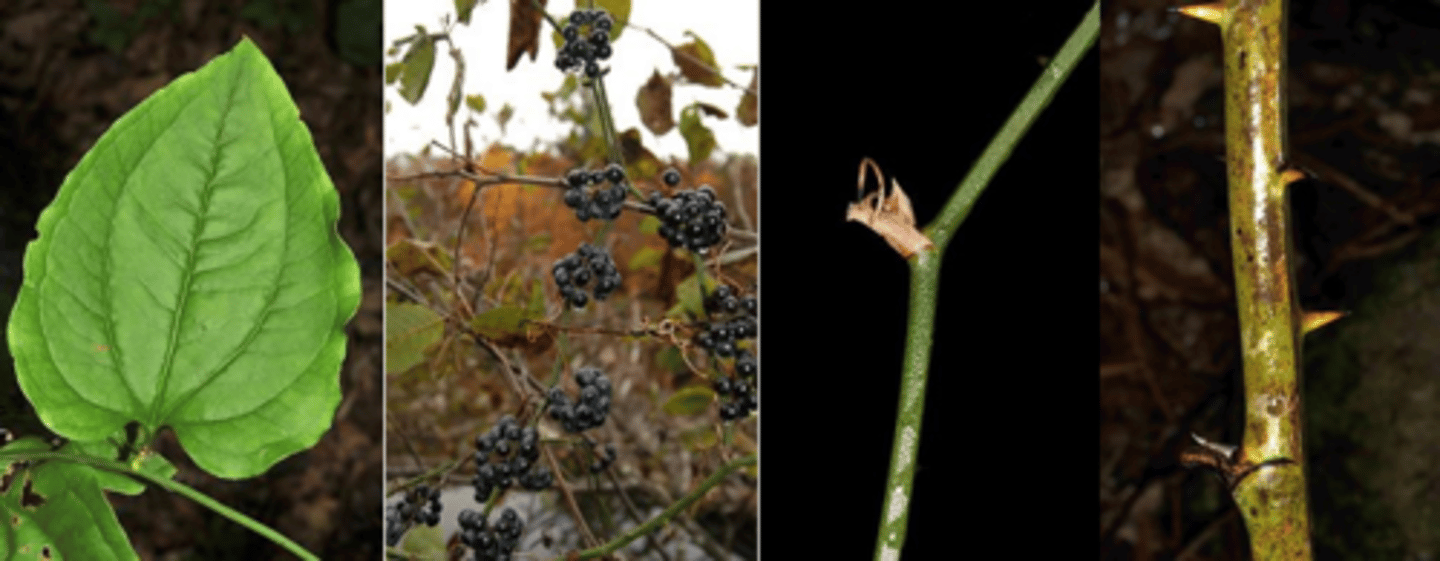Mizzou Dendrology (COVERED 2X)
1/112
There's no tags or description
Looks like no tags are added yet.
Name | Mastery | Learn | Test | Matching | Spaced |
|---|
No study sessions yet.
113 Terms
MAD Cap Horse
Trees with opposite leaf arrangement
M - Maple
A - Ash
D - Dogwood
Cap - Caprifoliaceae family
Horse - Horse chestnuts
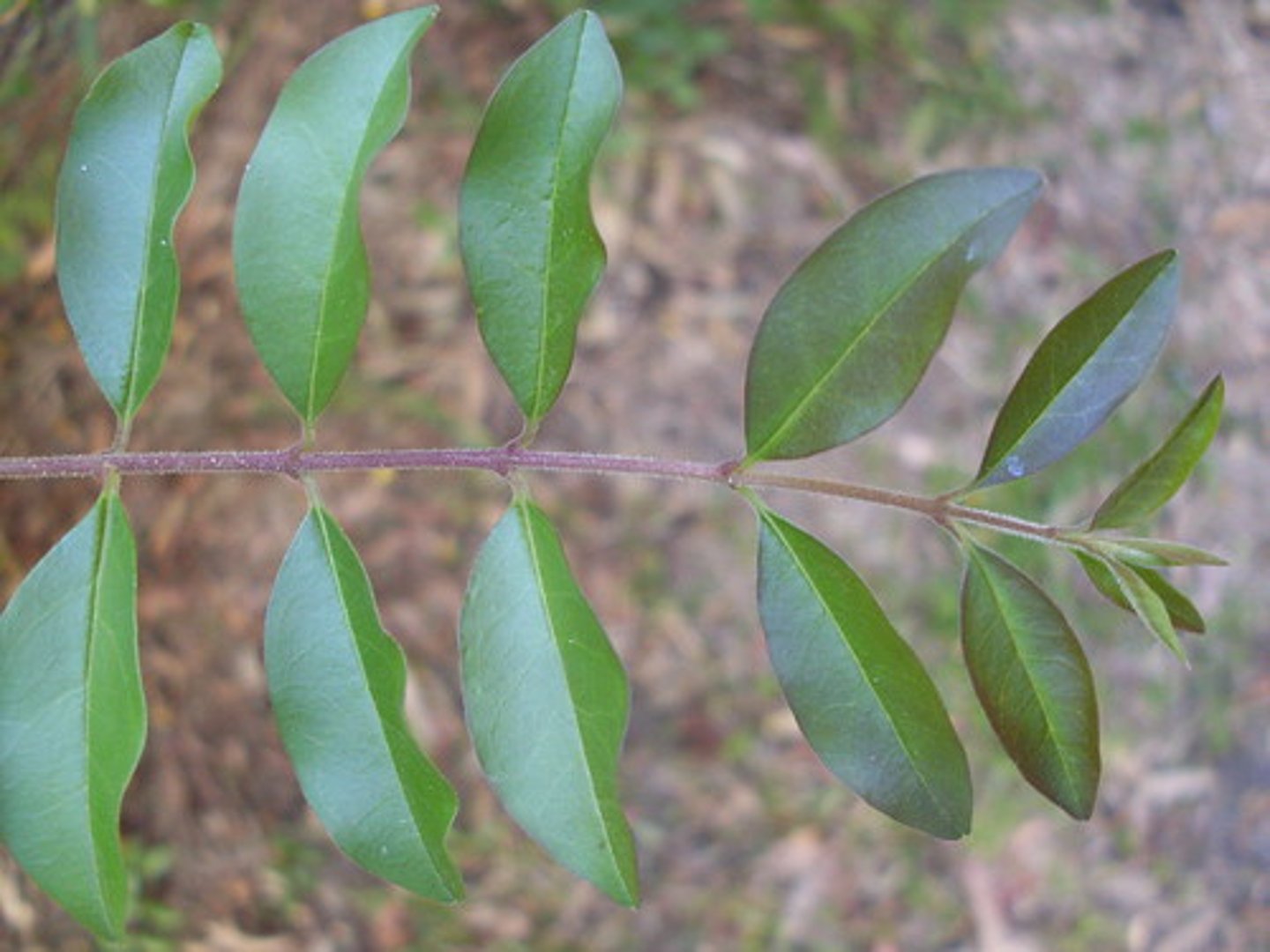
northern red oak
Fagaceae
Quercus rubra
Leaves: alternate, simple, 7-11 bristle-tipped lobes, sinuses 1/3-1/2 way to midvein, oblong
Twigs: fat and stubby, red-brown (especially on new growth), and glabrous
Buds: cluster of terminal buds (multiple), conical, 1/4" long, covered in red-brown scales (some of which may have frosty pubescence)
Fruit: 3/4-1" long and nearly round, matures in 2 growing seasons, has flat, thick cap covering 1/4 acorn or less which resembles beret, flat cap, truncated cap scales
Bark: "Ski tracks", wide and flat-topped ridges and shallow furrows, dark brown/gray, and pinkish-red inner bark
Silvics: medium-large in size (up to 90'), short trunk and round crown when open grown, occurs on well-drained soils
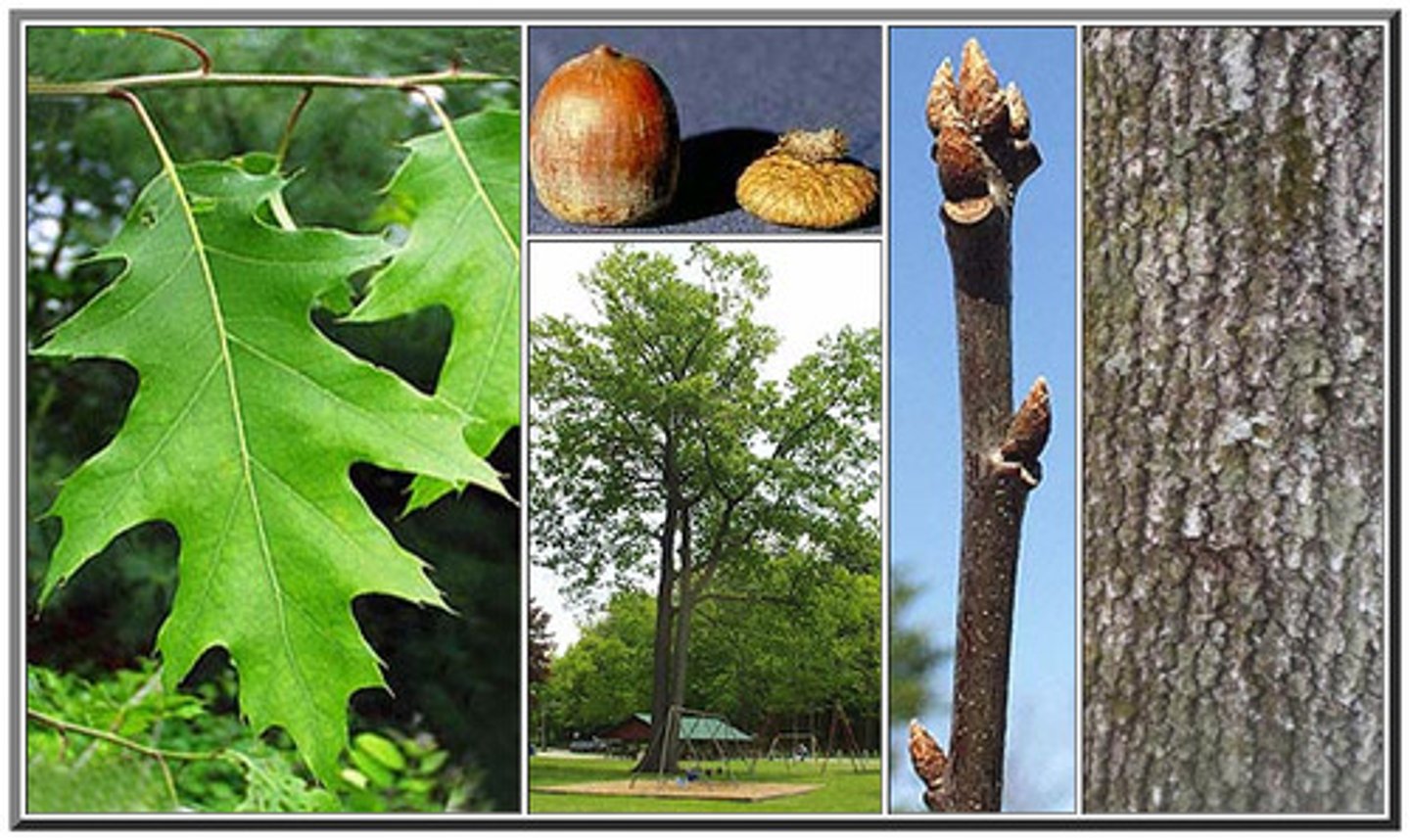
shumard oak
Fagaceae
Quercus shumardii
Leaves: 7-9 bristle-tipped lobes ("more" bristles than Q. rubra); Deeper/wider sinuses (compared to Q. rubra); shiny dark green above, duller (yellowish?)-green below. Lobes wider at the tip than base
Twigs: slender, gray-brown, gray-green on new growth smooth.
Buds: sharp pointed, not round in cross-section w/ tannish-straw colored imbricated scales.
Fruit: 2 yr. acorns 1.25 in. long, look like Q. rubra but longer; cap covers ~25% of acorn length, saucer shaped and convex (Q. rubra caps are flat).
Bark: grayish-brown w/ narrow 'ski tracks' separated by deep fissures. The 'ski tracks' less continuous in length compared to Q. rubra.
Silvics: Hard to distinguish from northern red oak. Not as common; prefers moist, well-drained sites, but can be found on both poorly drained, swampy sites as well as upland; very intolerant of shade
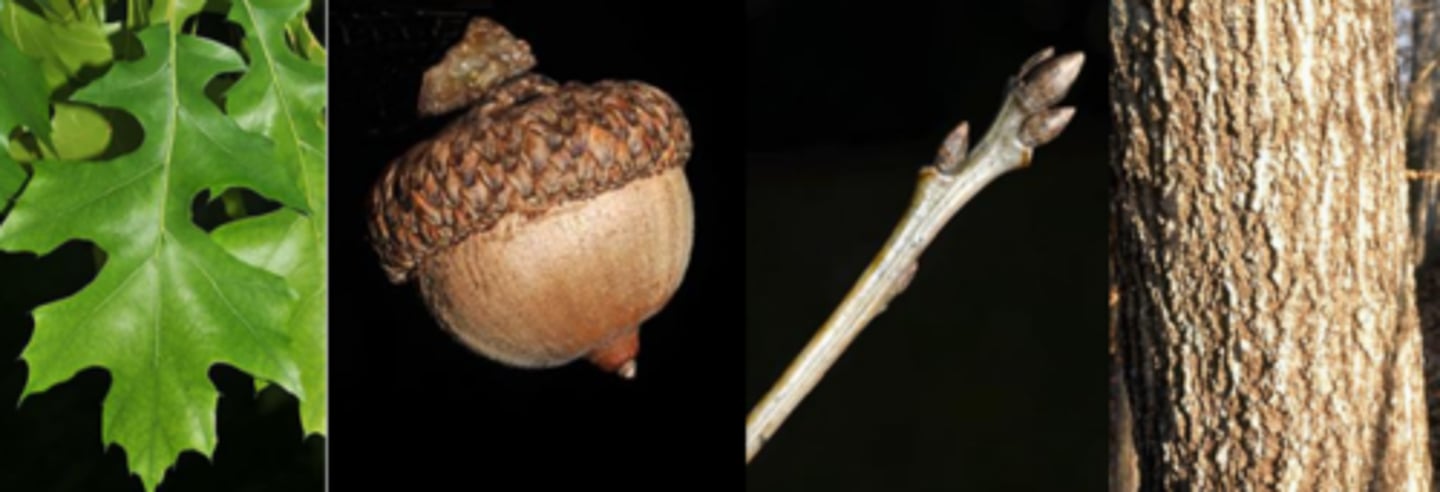
red maple
Sapindaceae
Acer rubrum
Leaf: opposite, simple, usually 3 lobes, sometimes 5, triangular, serrated lobes ALL THE WAY DOWN, w/ "V" shape sinus, base of leaf is rounded, irregularly toothed (silver has no teeth on sinuses), new growth and petioles often red, petioles to 4" stay red all summer. Often smaller than sugar.
Twigs: slender, dark, lustrous red; odorless or nearly so; New growth red.
Bark: same as sugar but often light gray splotches when younger
Buds: obtuse, blunt-tipped, 2-4 pairs of red scales.
Fruit: samara with wings at 60° angle, mature in the spring w/ the appearance of leaves; Fall color not always red unless a cultivar.
Form/Silvics: Mature size--40-60'. Intermediate in shade tolerance; pioneer species; somewhat ubiquitous; found along edges of swamps in Bootheel and edges of sinkhole ponds in SE Ozarks.
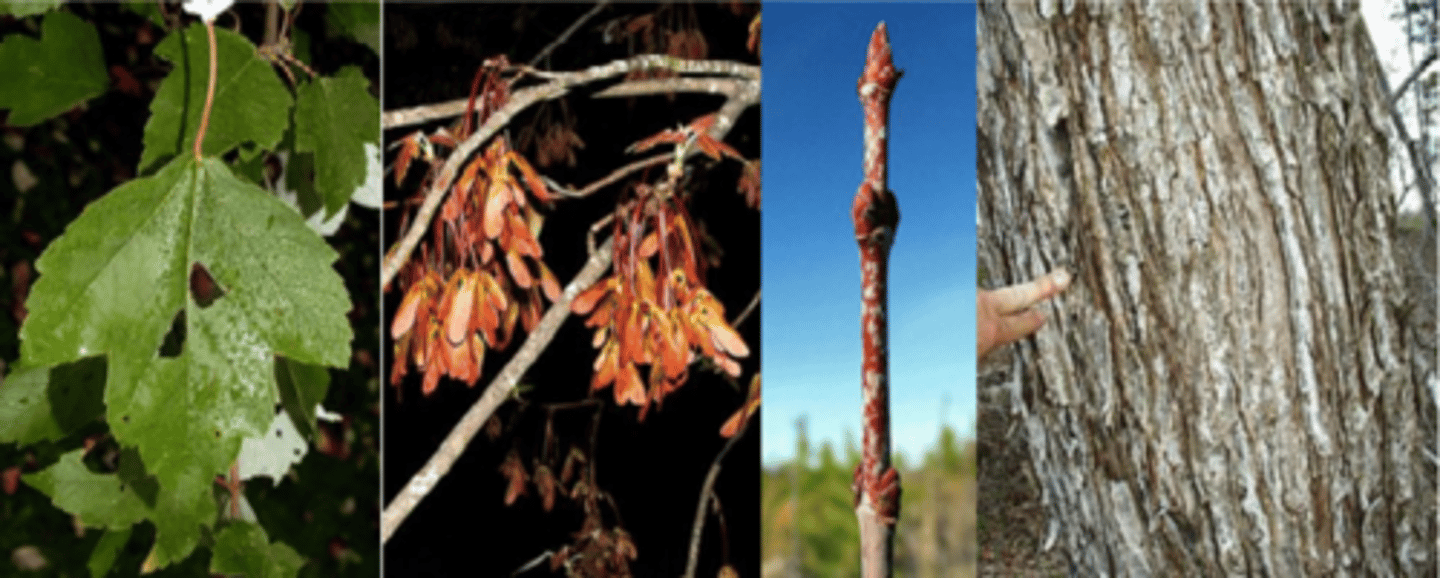
ginkgo
Ginkgoaceae
Ginkgo biloba
Leaves: deciduous, alternate, flabellate (fan-shaped); petiole 1-3 ¼" long; blade ~3long and ~4" wide; with or without narrow apical sinus; small, dichotomous venation; borne on long shoots at the tips of branches, but on older growth only on short, spur branches; brilliant pale yellow or orange-yellow fall foliage; all leaves drop within a few days.
Twigs: scaly brown, short and stout buds, terminal bud present; estipulate (no stipule scars); homogeneous pith
Flowers: dioecious (male and female flowers on separate trees); naked ovule; wind-pollinated; globose; ripened fruit has a rancid butter odor
Factoids: monotypic all the way up to Order! From Late Mesozoic (~150 million years ago).
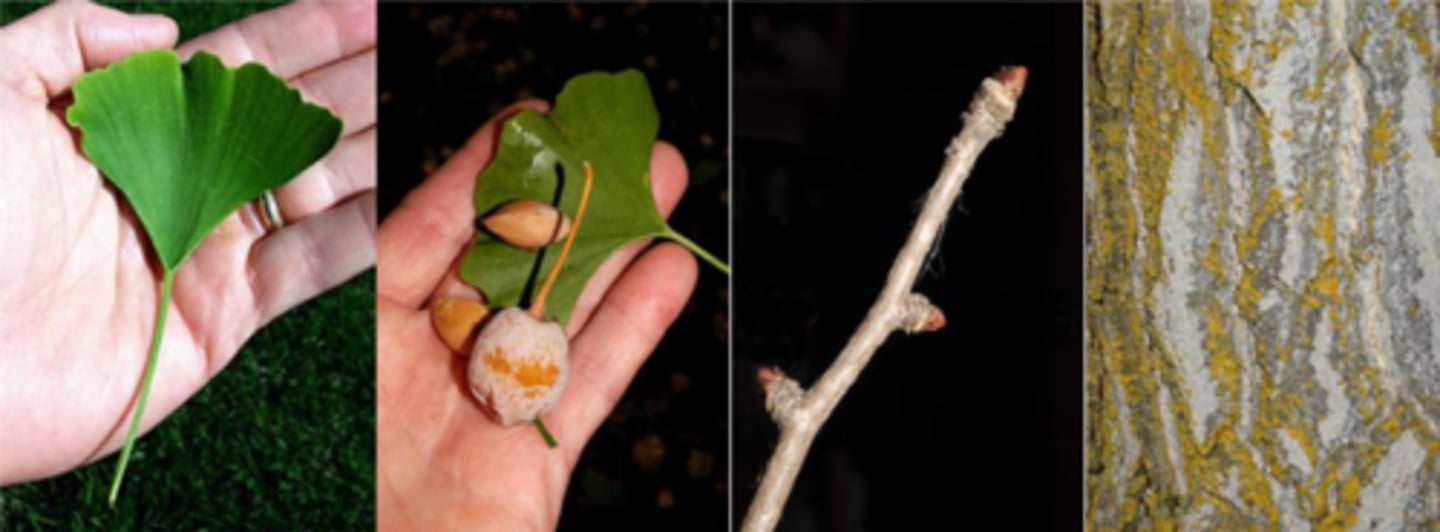
scarlet oak
Fagaceae
Quercus coccinea
Leaves: alternate; simple w/ truncate base; ovate, obovate, or oval; 3-7" long, 2-5" wide; , 5-7 bristle tipped lobes with deep, wide C-shaped sinuses (nearly to midrib); shiny, bright green above, pale beneath; may have good scarlet fall color (common name).
Twigs: slender, reddish brown; glabrous
Buds: terminal bud 1/8-1/4: long; ovoid; often angled (not round) in cross section; shaped like a rugby ball; dark reddish brown.
Fruit: acorns more wide than tall; ½-1" long; w/ concentric rings at tip; frilled cap covers 50% of acorn length.
Bark: mature bark is dark gray, nearly black; ridges separated by shallow fissures. (ridges similar to Q. rubra but are shorter, discontinuous). Inner bark is pink-red.
Form/Silvics: Mature size 70-80' tall; a dry-site species. Commonly found w/ black oak. Very intolerant of shade but competes well on dry sites. Can handle high pH soils.
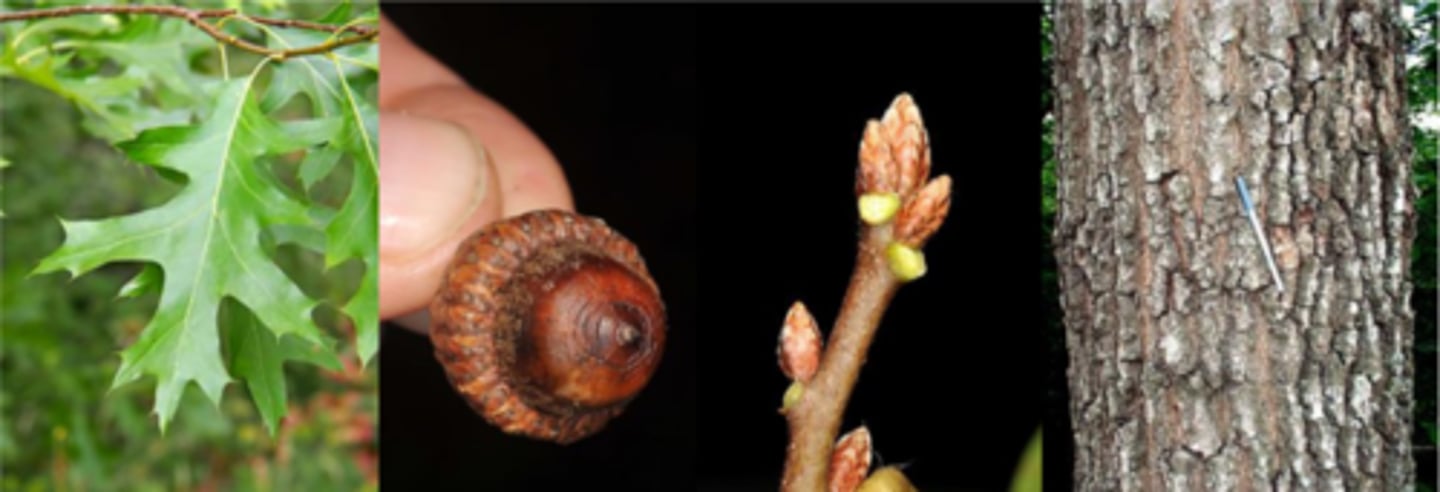
American sycamore
Platanaceae
Platanus occidentalis
Leaves: alternate, simple, large, 8" wide) w/3-5 lobes and large teeth, bright green above, pale and hairy beneath - especially along leaf veins, petiole base completely encompasses bud. Smaller sinuses and less jagged than L.p.
Twigs: Twigs grayish tan, smooth.
Buds: cone-shaped, burgundy red colored, smooth, octagonal in cross-section.
Fruit: pendant, round cluster of tan colored achenes. One fruit per stalk.
Bark: distinctive, multi-colored (green, tan, white, brown). Peely, exfoliating on younger bark
Form/Silvics: Largest diameter trees in North America; fast growing, can live to 600 years. Found in bottomland sites that may occasionally flood, shade intolerant. Distinctive look.
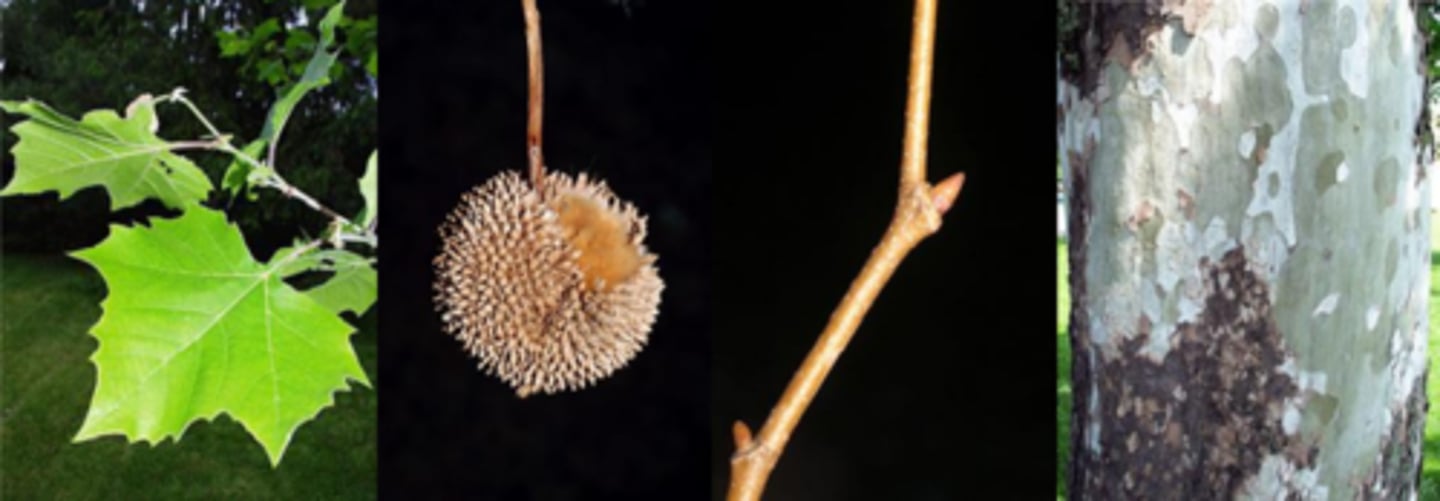
London planetree
Platanaceae
Platanus x acerifolia
Leaves: Alternate, simple, 7" long x 8-10" wide, 3-5 lobes, acute sinuses 1/3 length of blade, truncate (flat) to cordate (heart shaped) base. Deeper sinuses with more teeth than A.s.
Fruit: Rounded syncarp of achenes, 1", two per stalk. (P. occidentalis has 1/stalk, while P. orientalis has 3/stalk); however, this is not a definitive character.
Bark: Multi-colored patches, generally light green in color (more so compared to P. occidentalis), exfoliating bark.
Form/Silvics: Hybrid between P. occidentalis and P. orientalis. Commonly used as a street tree in Europe. Mature size 70-100'. This tree has several problems: messy fruit and twigs dropping, anthracnose, canker stain fungus, powdery mildew, lacebug. Ornamental.
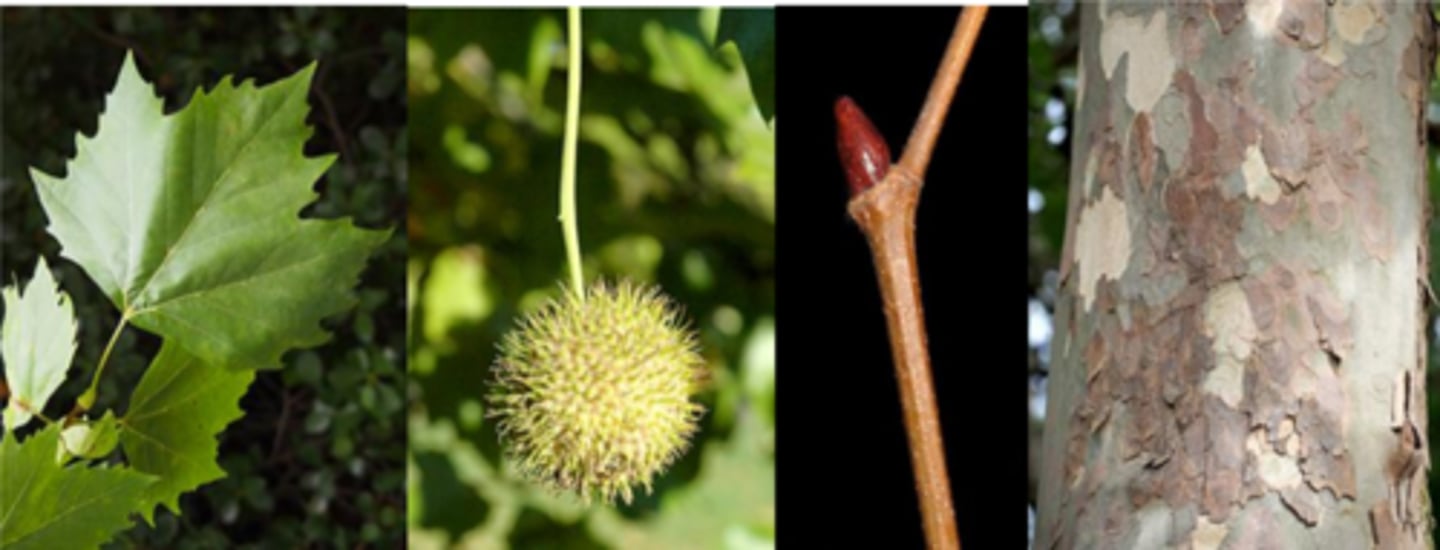
white oak
Fagaceae
Quercus alba
Leaves: alternate, simple, oblong to ovate in shape, 4-7" long; rounded, finger-like lobes, sinus depth ranges deep to shallow, apex rounded and base wedge-shaped, green to blue-green above and whitish below. NO BRISTLE ON END OF LOBES. Less contrast between above and below leaf.
Twigs: red-brown to somewhat gray, even a bit purple at times, hairless and often shiny.
Buds: multiple terminal buds are red-brown, small, rounded, and hairless.
Fruit: ovoid to oblong acorn, cap is warty and bowl-shaped, covers 1/4 of the fruit; cap always detaches at maturity; matures in one growing season in the early fall.
Bark: Whitish or ashy gray with high contrast between outer layer of bark and below, varying from scaly on smaller stems to irregularly platy or blocky on large stems. On older trees, smooth patches are common.
Silvics: a very large tree; when open grown, rugged, irregular crowns that are wide spreading, with a stocky bole. In the forest, crowns are upright and oval with trees reaching up to 100 feet tall and several feet in diameter. Can grow almost anywhere on the landscape: upland and lowland
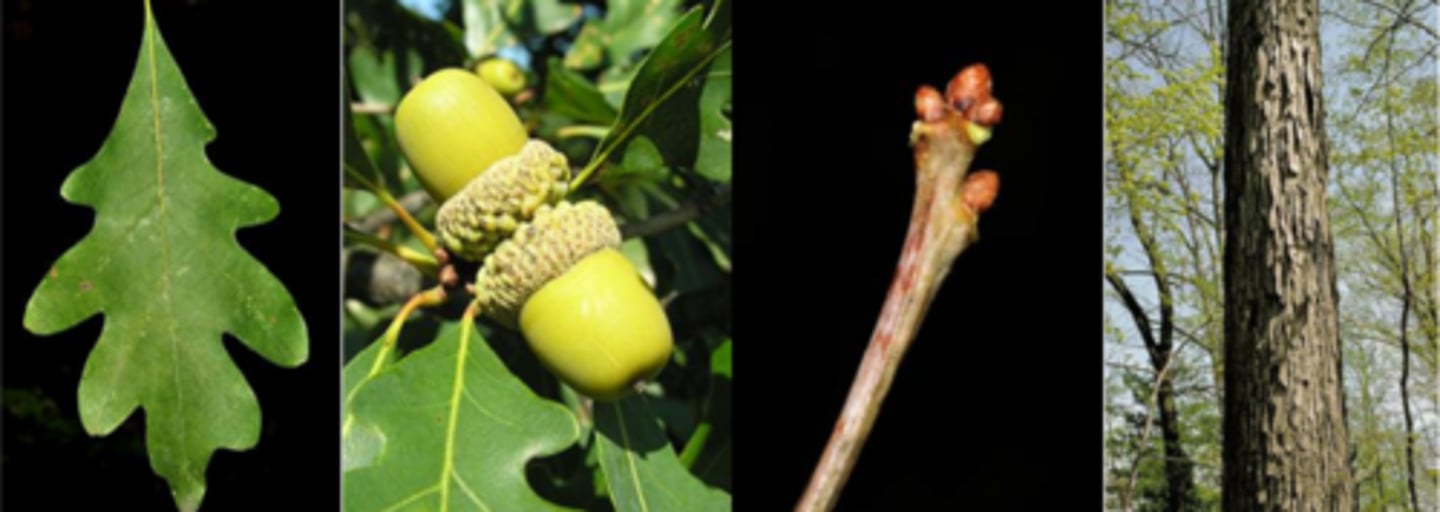
eastern white pine
Pinaceae
Pinus strobus
Needles: 5 per fascicle; 2.5"-5" long, slender, soft, flexible; blues-green, sometimes lighter and whitish; finely serrate; remaining 2 years with 3rd -year needles dropping Aug-Sep; white lines of stomata; deciduous fascicle sheaths 1/2", peeling back (ragged appearance) Mature Size --50-80 x 20-40
Cones: sub-terminal; not symmetrical; pendulous, 6-8" long; stalked often curved; resinous and light brown; thicker scales than on a spruce cone; apophysis nearly smooth or slight raised; umbo terminal and unarmed; change in color at the apophysis
Twigs: orange-brown, glabrous; buds covered with thin, reddish or orange-brown scales
Bark: on young stems thin, smooth, and dark green, soon furrowed; on old trees 1"-2" thick, deeply and closely fissured into narrow, roughly rectangular blocks, minutely scaly on surface of blocks
Form/Silvics: 80-100' tall; 24-40" dbh; intermediate shade tolerance (more than paper birch, aspens and red pine but less than sugar maple, American beech and eastern hemlock), lots of branches lower to ground
Factoids: produces one false whorl of branches each year; ornamental attributes include soft foliage texture, upright form, windfirm.
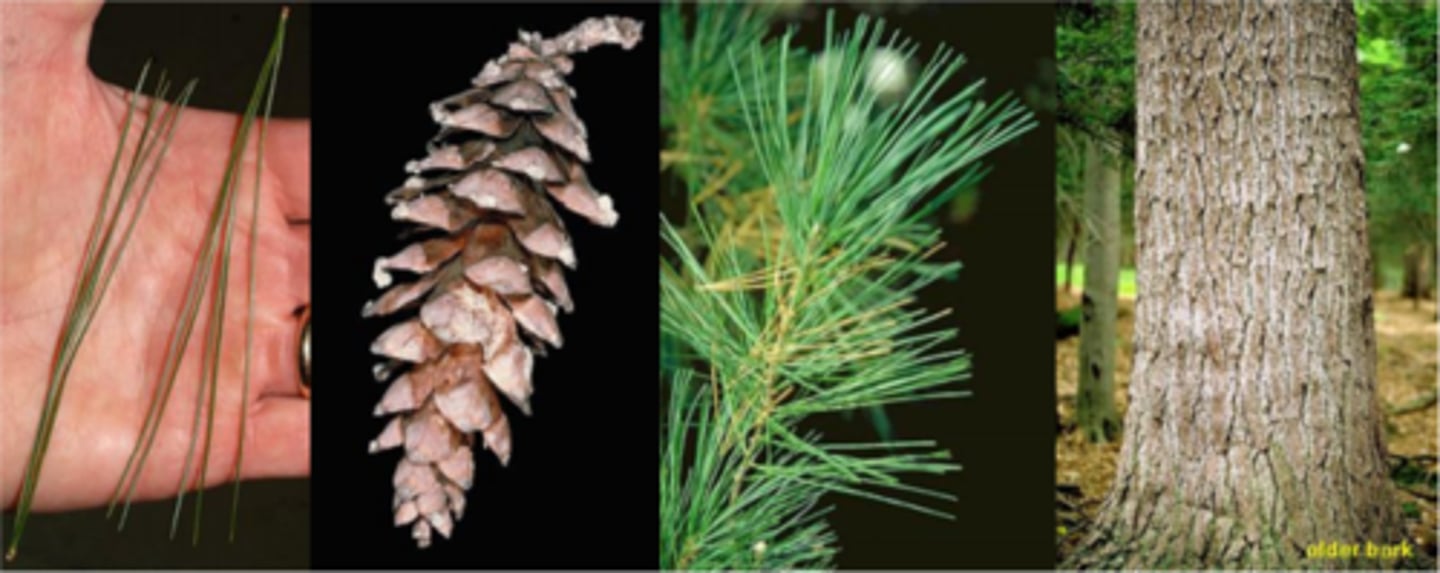
eastern redbud
Fabaceae
Cercis canadensis
Leaves: alt., simple, cordate, margins entire, petiole swollen at both ends.
Twigs: zigzag, dark brown, shiny w/ white lenticels.
Buds: small, black (look like mouse poop) appressed leaf buds. Flower buds are preformed, globose and conspicuous. Flowers are pink and appear before the leaves, on two-year old branches and bole.
Fruit: short, thin, dark brown legume. (leafy bean pod)
Bark: dark red-brown, scaly on older trees.

American beech Fagaceae Fagus grandifolia
Leaves: ovate w/ acuminate tip, dark green shiny above, pale pubescent beneath. (slightly waved and toothed); very straight, defined veins
Twigs: slender, reddish-brown turning gray.
Buds: elongated 1+ in. long, slender, sharply pointed w/ bronze colored imbricate scales
Fruit: 3-sided nut, < 1" long in a bur (2-3 per bur); bur has 4 scales.
Bark: smooth gray, very distinctive; easy to identify by its smooth gray bark;
Form/Silvics: very shade tolerant; mature size 80' tall; very long-lived tree (400 years); prefers moist, well-drained fertile soils; can sucker (shallow roots)
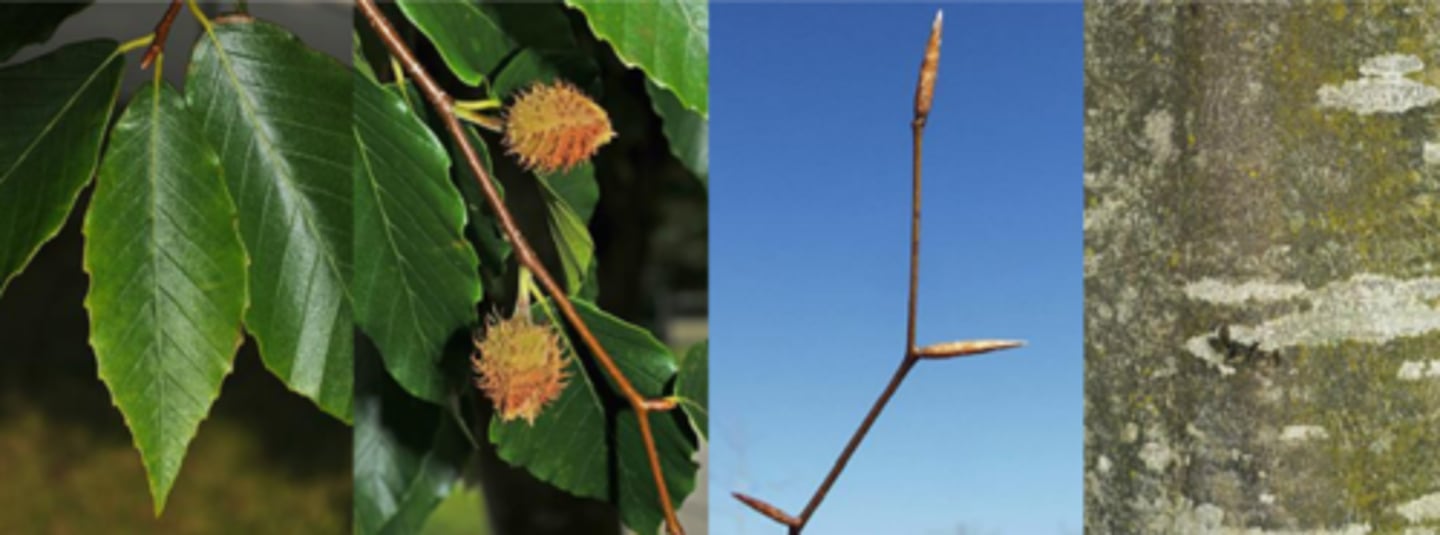
swamp white oak
Fagaceae
Quercus bicolor
Leaves: alternate, simple, oblong-obovate (kite-shaped), 3-7" long coarsely sinuate (wavy margins) -dentate (lobes not pointing forward) with 6-10 pairs of obtuse teeth, dark green above, gray green, velvety/fuxzzy beneath, leathery, midrib yellowish. (bicolor= two colored leaves, like silver maples)
Twigs: straw-brown, dull.
Buds: terminal buds clustered, rounded, reddish-brown w/ smooth imbricate scales. Tips of buds can be hairy.
Fruit: 1-yr-old acorns borne on 1-4" peduncles that are light brown in color, The peduncle falls to the ground w/ acorn at maturity (great I.D. feature). The pyramid like, warty cap covers 1/3 of nut.
Bark: small branches can have corky wings (like swamp white and burr oak). Mature bark like bur oak. Upper limbs can have papery, peeling bark like river birch. Inner bark is bright green in color.
Form/Silvics: Medium-sized tree, 60-70' tall, 24-36" dbh. Moderately shade tolerant. Highly tolerant of poorly aerated (clay) soils. Poorly pruned bole and irregular crown. Not abundantly common in woods, but when found it is along stream banks or on moist or peaty flats along swamp margins

American basswood
Tiliaceae
Tilia americana
Leaf: alternate, simple, ovate to cordate, 5 to 6 inches long, with serrate margins (singly toothed), pinnately veined, base is unequally cordate, green above and paler below.
Twigs: moderately stout, zigzag, green (summer) or red (winter);
Buds: terminal bud is false, each very plump with one side bulging out disproportionately; edible but very mucilaginous. Brighter red during cold months, especially in comparison with that of T. cordata.
Fruit: round, unribbed nutlet (1/4") that is covered with gray-brown hair; occur in a hanging cluster with a curving, leafy bract acting as wing on top of the cluster, ripening in the fall.
Bark: At first smooth and gray-green, later turning gray-brown and becoming ridged with long, shallow furrows and flat topped ridges. The bark is very fibrous. Sprouting of multiple main stems common.
Form/Silvics: A medium sized tree to 80'. Older trees very often sprout from the base when cut. Stumps sprout prolifically, often resulting in clumps of several trees.
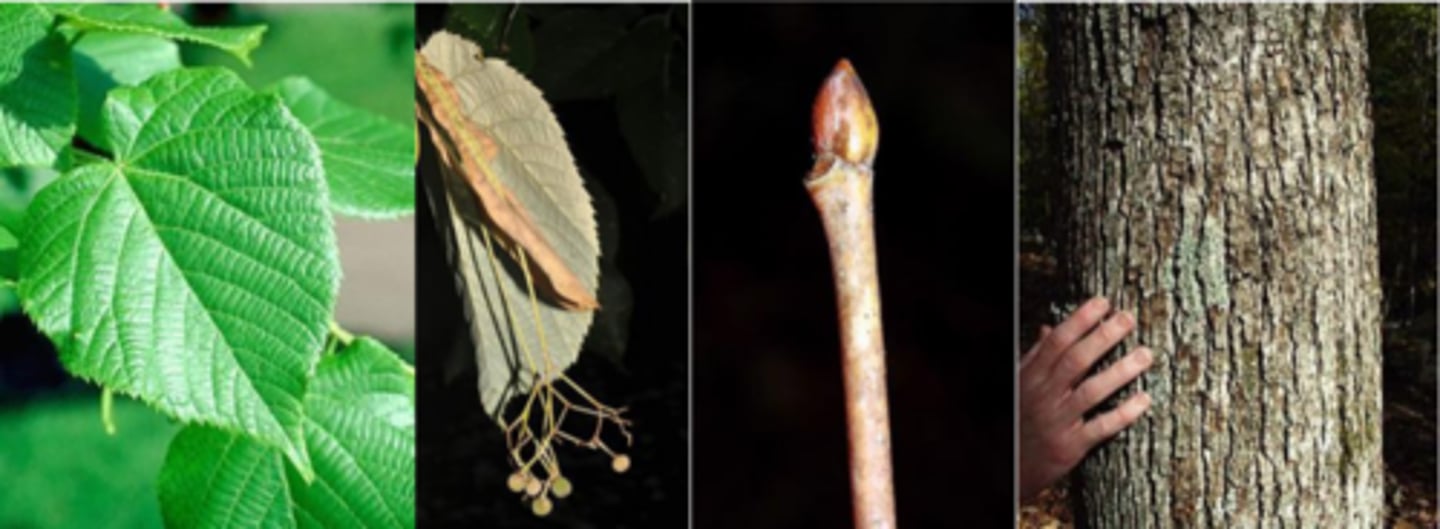
little-leaf linden
Tiliaceae
Tilia cordata
Leaves: Alternate, simple, ovate to cordate, 2-4” long, with serrate margins, pinnately veined, inequilateral base, green above and paler below.
Flower: Species is monoecious; pale yellow, borne below a long, gracefully curving leafy wing in a many branched cluster, several inches long, appearing in early to mid-summer.
Fruit: A round, conspicuously 5-sided nutlet (1/4”) that is covered with gray-brown hair; occur in a hanging cluster (multiple fruit) with a curving, leafy bract acting as a wing on top of the cluster, ripening in the fall.
Twig: Slender, zigzag, green-brown or red-tinged (particularly in the winter); terminal bud is false and globose, buds are plump with one side bulging conspicuously, edible and when eaten they are mucilaginous.
Bark: Gray or brown, ridged with shallow furrows; young stems are brown and soon become ridged. The bark is quite fibrous. Often multiple main stems.
Form/Silvics: A small to medium tree to 70’ with a dense, round crown. In the U.S. it is typically only seen when open grown where it develops into a small tree as wide as it is tall. Often end up with bug damage in fall that causes leaves to look skeleton-like
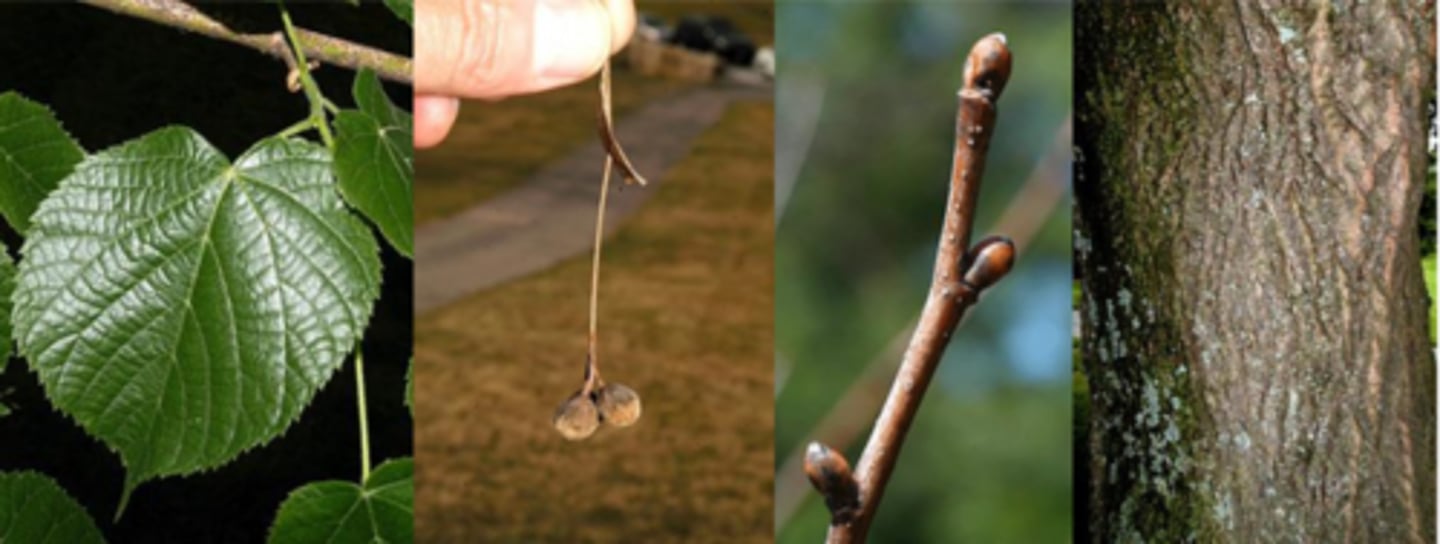
baldcypress
Cupressaceae
Taxodium distichum
Leaves: Linear and small, 1/4 to ¾" long, generally appearing two-ranked. When growing on deciduous branchlets the leaf-deciduous branchlet structure resembles a feathery pinnately (or bi-pinnately) compound leaf; green to yellow-green.
Fruit: Cones are composed of peltate scales forming a woody, brown sphere with rough surfaces (around most of the year), ¾ - 1" in diameter; cones disintegrate into irregular seeds.
Twig: May be deciduous or not; non-deciduous twigs are slender, alternate, brown, rough, with round buds near the end of the twig; deciduous twigs are two-ranked, resembling pinnately compound leaves.
Bark: Fibrous, red-brown but may be gray where exposed to the weather; old, thick bark may appear somewhat scaly (or long and stringy)
Form/Silvics: A large tree with a pyramid-shaped crown, cylindrical bole, fluted or buttressed base and often with knees.
Looks like: pondcypress, dawn redwood
dawn-redwood
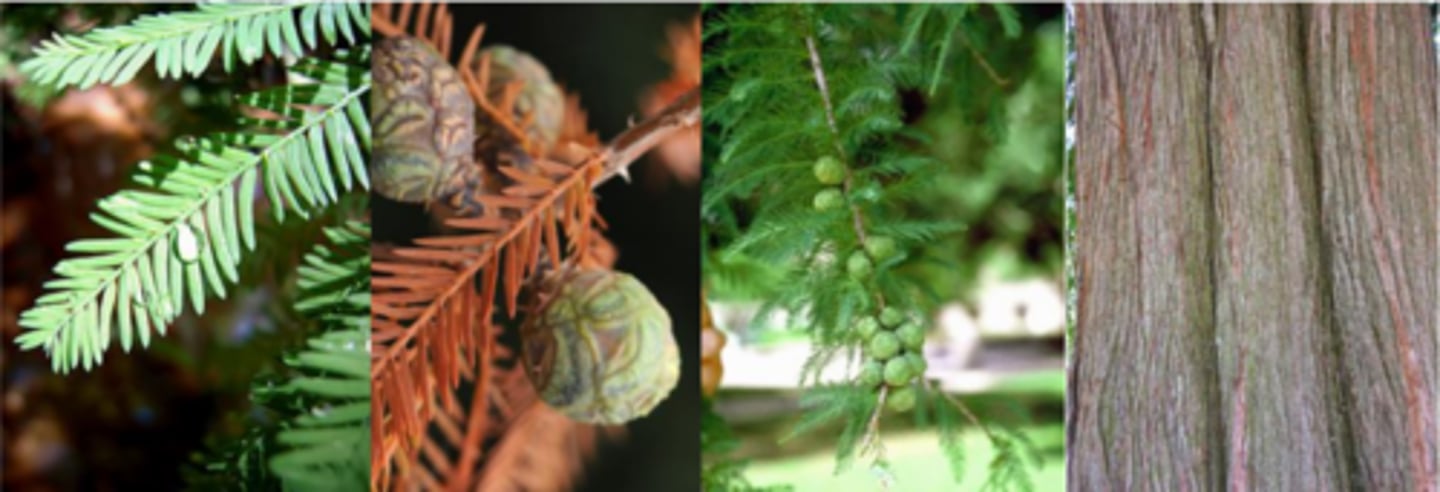
river birch
Betulaceae
Betula nigra
Leaves: alternate, simple, somewhat delta-shaped, doubly serrated, lower surface is whitish/very hairy, yellow fall color.
Twigs: reddish-brown, slender, often pubescent. Food source for white-tailed deer.
Buds: small, cone-shaped, reddish-brown.
Fruit: Cone-like, aggregate, 1 to 1 1/2 inches long, with many hairy scales, reddish brown, containing many tiny, 3-winged seeds, ripen and break apart in the spring (other birches in the fall). Consumed by songbirds
Bark: distinctive salmon-pink, papery, exfoliating, later coarsely scaly
Silvics: moist, riparian sites, pioneer species, medium size tree to 80' w/ irregular crown
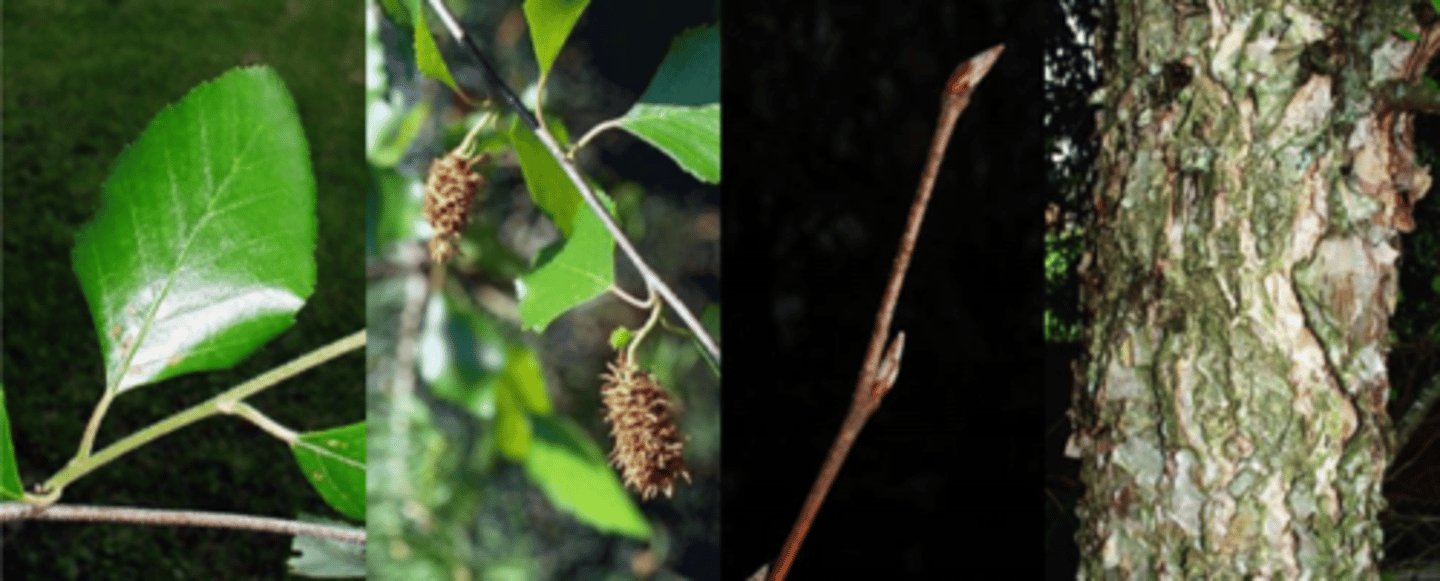
dawn-redwood
Cupressaceae
Metasequoia glyptostroboides
Leaves: opposite, deciduous, linear, 1" long (longer and bigger), flat, generally appearing two-ranked in a flattened display; when growing on deciduous branchlets the leaf/deciduous branchlet structure resembles a feathery pinnately (or bi-pinnately) compound leaf, green to yellow-green.
Fruit: four-sided, box-like cones that hang on long stalks, round to cylindrical in shape, ½-1" long, light brown; peltate shields contain small, winged seeds, matures in late fall.
Twigs: may be deciduous or not; non-deciduous twigs are slender, light reddish brown in color, smooth, with short, buff-colored, opposite, cylindrical buds protruding at right angles (small and some green); deciduous twigs are two-ranked, resembling pinnately compound leaves.
Bark: Reddish brown, fibrous and stringy, develops an irregular fluted pattern, exfoliates in strips, ropelike in appearance.
Form: Very straight, branches all characteristically shoot upwards; capable of reaching heights well over 100' tall.

Norway spruce
Pinaceae
Picea abies
Leaves: Evergreen needles, stiff, ½ - 1” long, 4-angled but somewhat flattened, with a sharp pointed tip, shiny deep green. Each needle borne on a raised, (tiny) woody peg (sterigma).
Fruit: Cones are very large, pendulous, cylindrical, 4 – 6” long, with stiff, thin scales that are irregularly toothed, chestnut brown, maturing in fall.
Twig: Slender to medium in size, lacking hair, shiny orangish brown; needles are borne on woody pegs; buds with very loose, gradient orange-brown scales which are lighter at tip (resembles a rose).
Bark: Red-brown and scaly, later turning gray with flaking scales or plates.
Form: A medium to large tree with conical form capable of reaching over 120’ tall, with horizontal to upward sweeping branches that often droop branchlets. Prefers moderately moist, sandy, acid well drained sites in cool climates. Common pests include spider mites, spruce gall aphid, budworms, aphids.
Looks like: red spruce, Oriental spruce, Brewer spruce, Serbian spruce
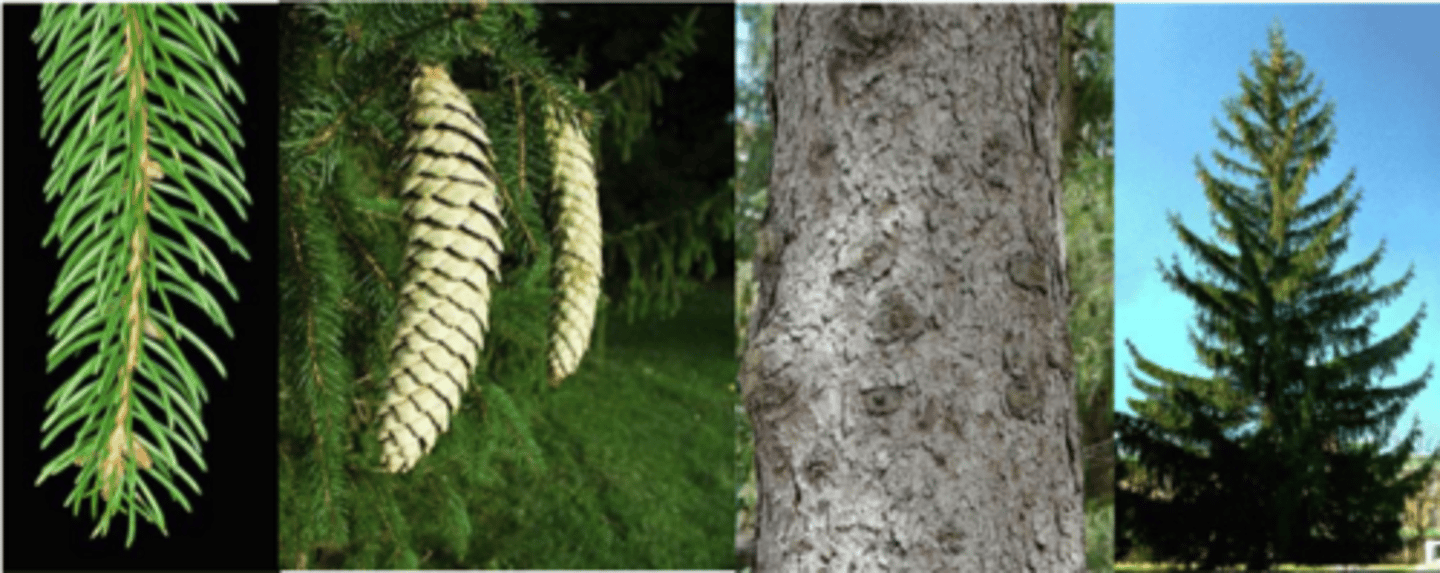
pin oak
Fagaceae
Quercus palustris
Leaves: alternate; obovate to broadly oval; 3-5” long, 2-4” wide; 5-7 deeply lobed (less fanned out), bristle tipped leaves; sinuses nearly reach to midrib (flatter sinsues); shiny bright green above, pale beneath; young trees are marcescent (=retaining leaves all winter).
Twigs: smooth, slender, shiny. Older dead twigs and branches retained on the tree, resembling pins thrust into the trunk, hence the name
Buds: terminal buds sharply pointed/angled w/ (lots of) smooth, imbricate, reddish-brown scales.
Fruit: acorns small up to ½” long w/ black stripes. Cap is thin, flattened, barely covering the acorn.
Bark: gray colored, thin for an oak. Will develop broad, scaly ridges w/ shallow fissures.
Form/Silvics: A medium sized tree up to 100’ w/ strong, conical shaped crown. Branching is unique w/ lower 50% of branches descending and the upper branches ascending. Fast growing tree species common on poorly drained, wet sites. Flood tolerant/shade intolerant. Widely planted in urban landscapes. Found also along streams, rivers, etc.
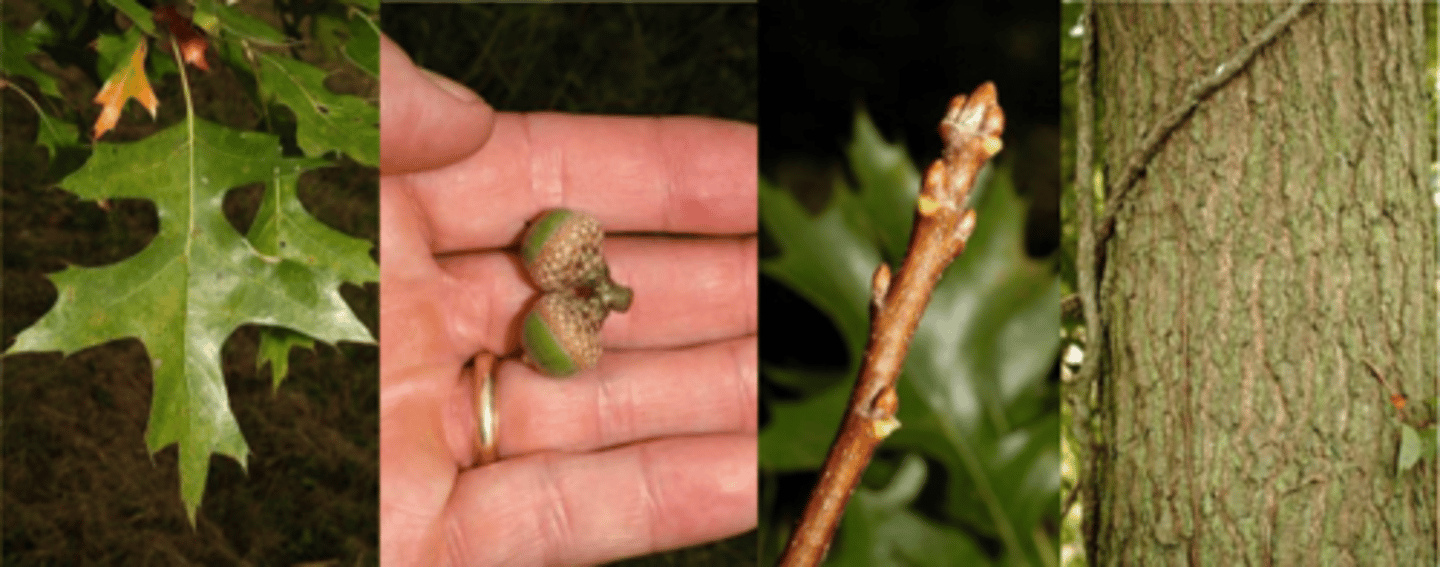
silver maple
Sapindaceae
Acer saccharinum
Leaves: opposite, simple, 4-6” long (smaller), with 5 deeply palmate sinuses, lobe margins coarsely serrate; light green above, pale, silvery white below. (intricate shape)
Twigs: similar to red maple but stouter and often more chestnut-brown/orange in color, unpleasant odor when crushed;
Buds: reddish brown with large scales and in 2s or 4s.
Fruit: samara, largest of any native maple, divergent wings 1½ - 2 ½” long, germinate as soon as released, mature in late spring (w/ the leaves).
Bark: light gray and smooth when young, when older breaks up into long thin strips, loose at ends. Similar to red maple but coarser.
Form/Silvics: Characteristic bottomland species and is not found on dry soils. Can become quite a large tree reaching over 100’ tall; trunk usually short, dividing into several sub-trunks. Long slender branches sweep downward and then curve gracefully upwards. Branches are brittle, prone to breakage.
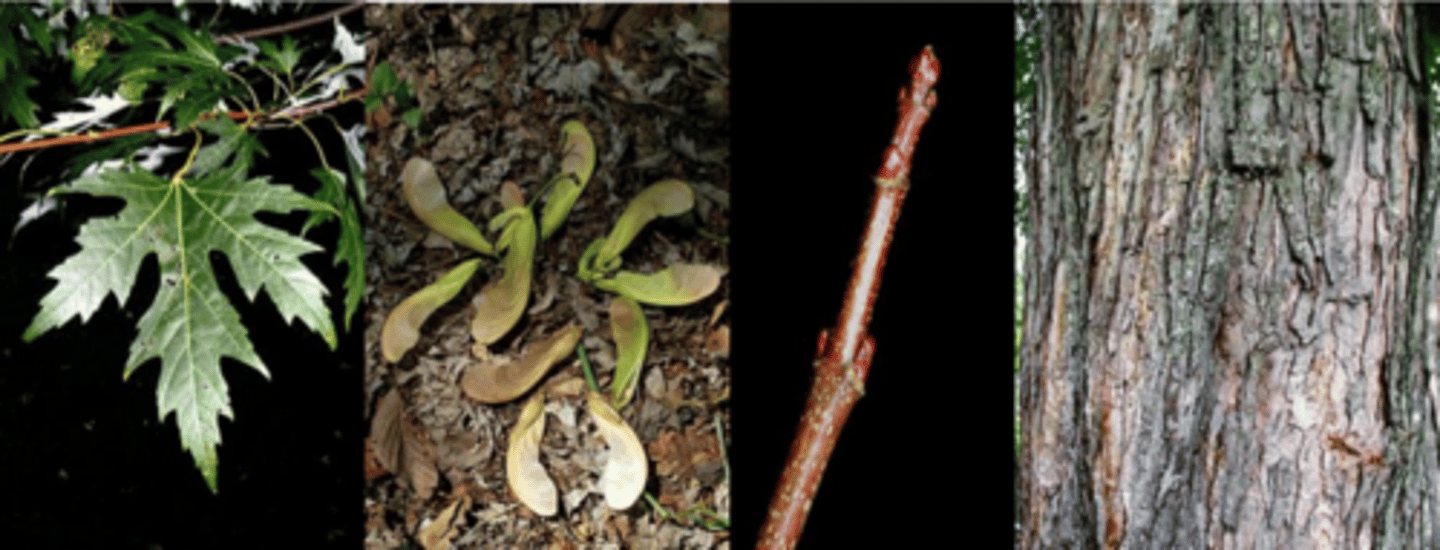
bur oak Fagaceae Quercus macrocarpa
Leaves: alternate, simple, definitely obovate to 10" long, lower portion narrower with 2-3 pairs of lobes, dark green above, whitish beneath--leaf shaped like a base fiddle (upside down), petiole 1.25" long, downy.
Twigs: stout, yellow-brown, may develop corky ridges on 2-yr-old wood.
Buds: imbricate, conical, sharp or blunt w/ pale pubescence covering entire bud, often w/ stipule scars.
Fruit: Acorn to 1.5" enclosed at least half in a cup with hairy fringe on margin.
Bark: rough, w/ deep ridges/furrows, usually dark gray to gray-brown.
Form/Silvics: Medium to large tree, 60-80' tall with a broad, spreading, rounded crown, massive trunk and low, spreading branches. Occurs in low woods in valleys or on lower slopes and along streams in the Ozarks. But, in glaciated northern Missouri often in upland woods as well as in valleys and in degraded/former savannahs.
Factoid: This oak can be difficult to transplant (but tolerant of clay soils, high pH and drought once established). Bur oak has a huge native range (macrocarpa = big fruits).
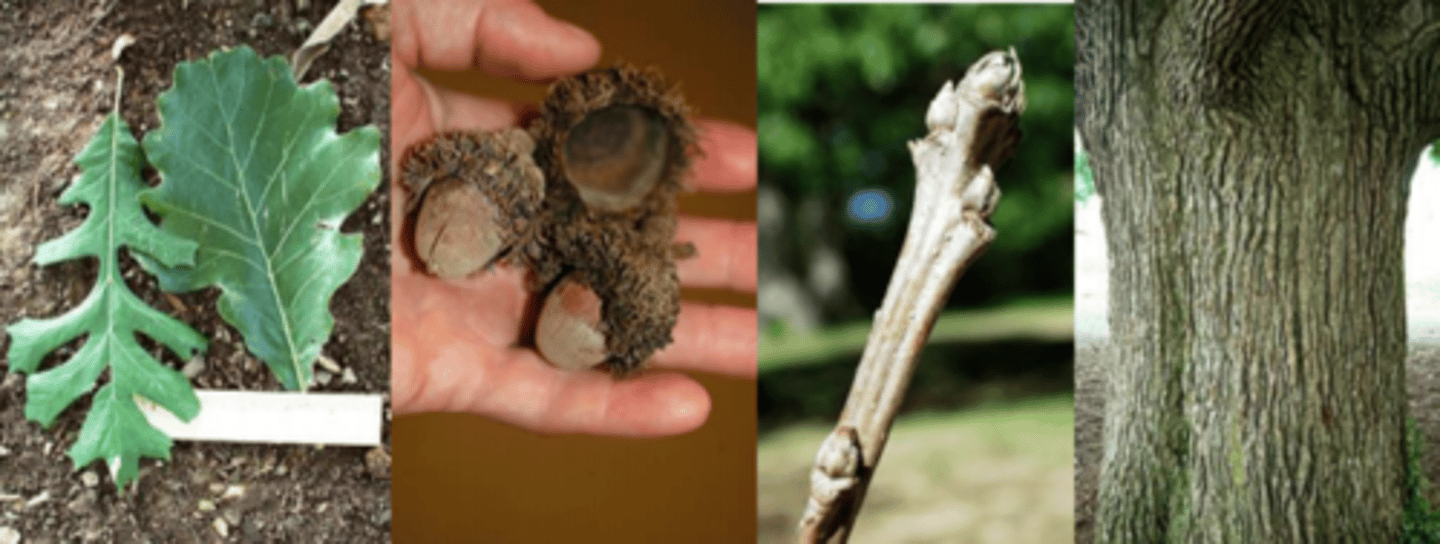
southern magnolia
Magnoliaceae
Magnolia grandiflora
Leaf: alternate, simple, evergreen, obovate or elliptic, 10-12", dark green & lustrous (shiny), leathery (coriaceous) above, rust colored beneath (called ferruginous, as in oxidized iron).
Twigs/Buds: Terminal buds 1.25" long, brown, tomentose.
Flower: Perfect creamy white, fragrant 8-12", May, June sporadically thereafter.
Fruit: Rose red aggregate of follicles splitting to expose red seeds.
Bark: dark gray, smooth becoming furrowed and scaly.
Form/Silvics: Mature size 60-80' tall, 24-36" dbh. A spectacular tree, we are on northern edge of range for this species; needs winter protection.
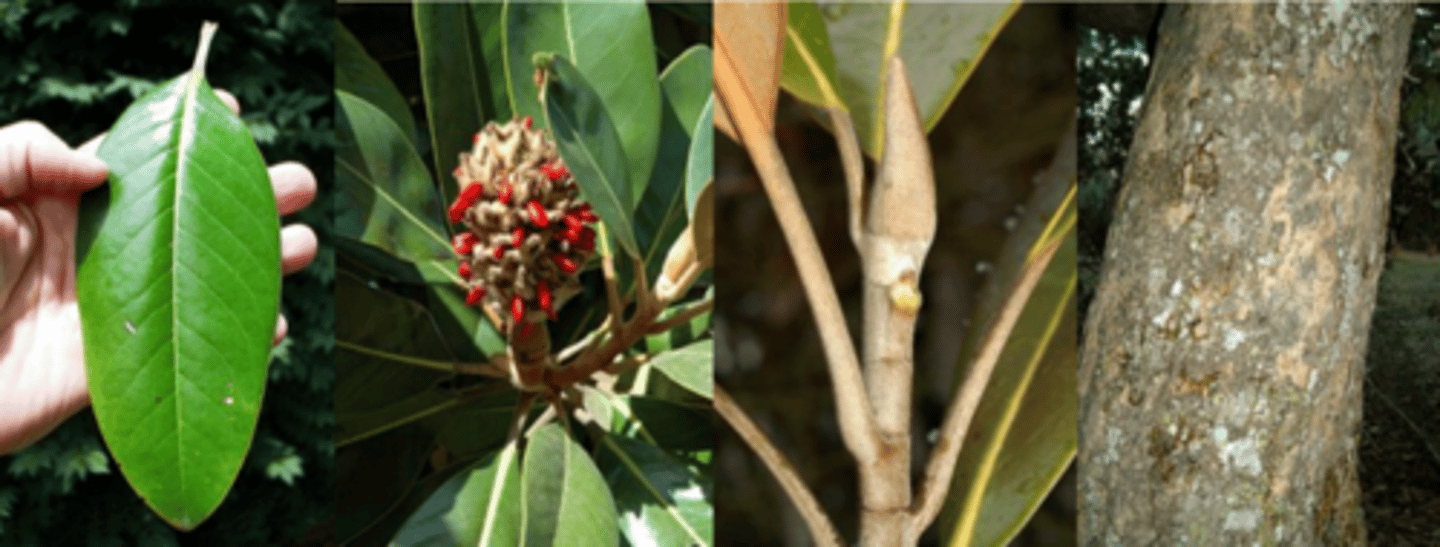
chinkapin oak
Fagaceae
Quercus muehlenbergii
Leaves: simple, alternate, 4-6” long w/ 12 fairly sharp pointed teeth per side; obovate shape, dark green, lustrous above, light green beneath, acute tip w/rounded base. Fall color can be yellow-orange/brown. Bristle at end of nodes.
Twigs: orange-brown, slender, glabrous
Buds: terminal buds small, 1/8” long, orange-brown
Fruit: sessile or short-stalked (direct attachment to twig), ¾-1” long; enclosed 50% by a thin, bowl-shaped cap; nut is small, chocolate brown/nearly black when ripe acorns (fall germinating).
Bark: ashy colored gray (or white) w/ square scales for entire tree length – easily rubbed off.
Silvics: moderately shade-tolerant for an oak; small to medium-sized tree, 60-80’ tall, 24-36” dbh; prefers limestone ridges, high pH conditions; can reach 400 years old.
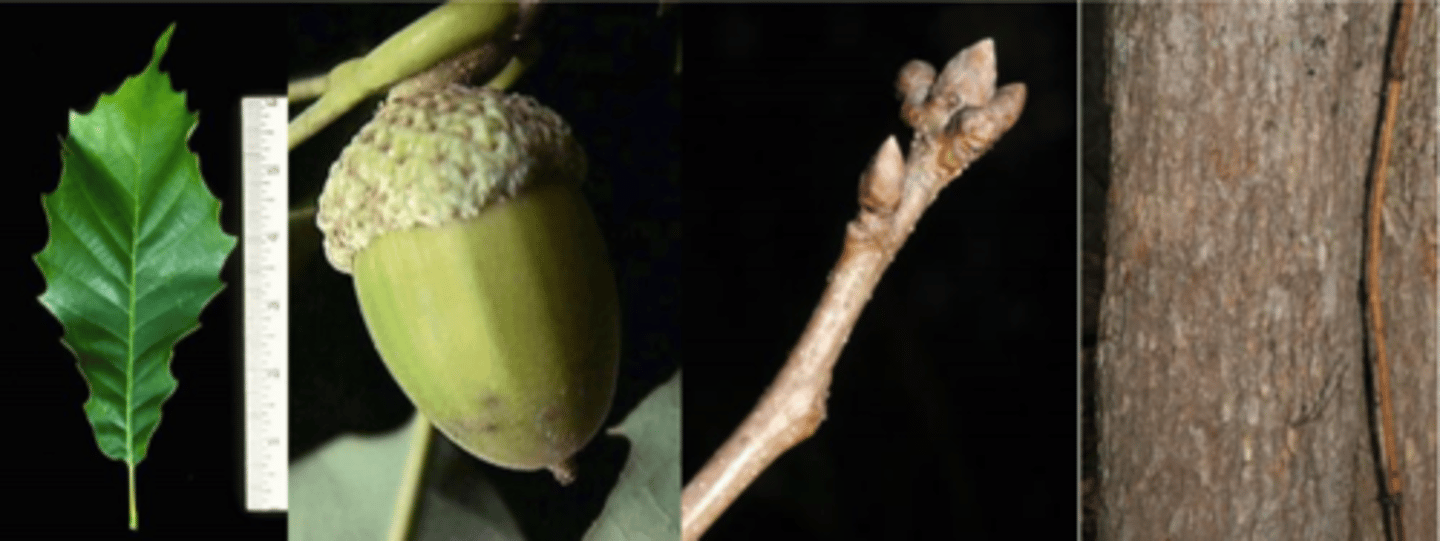
sugar maple
Sapindaceae
Acer saccharum
Leaves: opposite; simple, 3-5" orbicular outline; 3-5 lobes, usually 5; narrow, deep U-shaped sinuses; margins of lobes entire or sparingly sinuate-toothed (smooth); apices of lobes acuminate (pointed); glabrous surface; bright green above, paler beneath; distinctive yellow-orange fall color (most other maples are red or yellow). Black maple has similar leaves, but they droop on the margins and have tiny bracts on base of petiole.
Twigs: slender, shiny, smooth, reddish-brown, light-colored lenticels (scratch for sweet smell);
Buds: terminal bud brown (not black) sharply pointed. in 1s or 3s
Fruit: small, double samara; ripens in autumn; glabrous; horseshoe-shaped w/ nearly parallel or slightly divergent 1-inch long wings.
Bark: variable, gray to nearly black; smooth on young trees; long irregular plates on older trees, loosely fissured and less continuous; some scaly/warty/smooth areas on bark is possible.
Form/Silvics: Prefers moist, deep, well-drained soils; extremely shade tolerant, a climax species. 60-80' tall, 24" dbh. Valuable furniture wood, maple syrup.
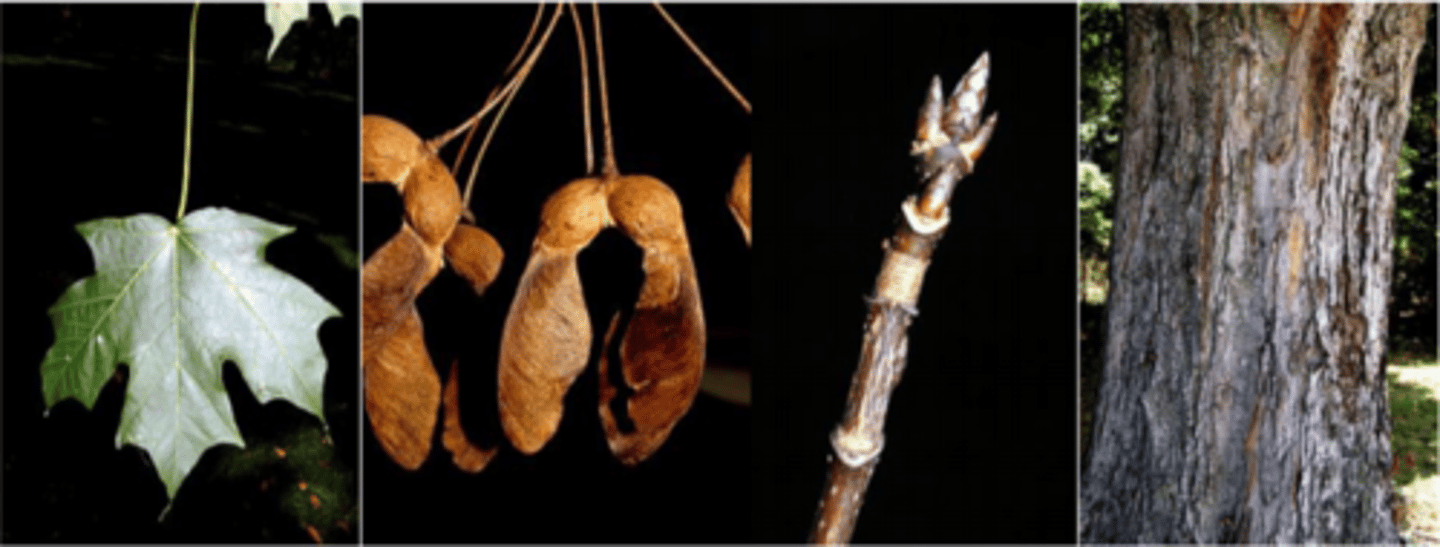
pecan
Juglandaceae
Carya illinoinensis
Leaves: Alternate, feather-like arrangement; 9-20 inches long; composed of 9 to 17 leaflets, 2-4 times longer than broad, lance shaped, pointed at tip and hook forward like a talon, margins toothed, side veins branching near the tip; upper surface dark green and smooth, lower surface paler, smooth to hairy; leaves aromatic when crushed
Twigs: stout, reddish-brown, hairy, with numerous elongated orange-brown pores, bud on end of twig yellow-brown
Fruit: September-October in clusters of 3 to 10, persistent. Husk thin, aromatic, winged, splitting along 4 ridges at maturity to expose nut; kernel sweet and edible
Trunk: bark grayish-brown to light brown when young, becoming dark reddish-brown with age; ridges long, flat, loose
Form/Silvics: Large tree up to 150’ tall, with a narrow, pyramid-shaped crown in the forest, broad and rounded in the open; largest of all hickory trees. Found in rich, moist bottomland soils
Other: One of the most important cultivated nuts in N. America. Carya is ancient Greek for walnut; illinoinensis refers to the state of Illinois. The nut is eaten by a variety of larger birds; squirrels, and other small rodents
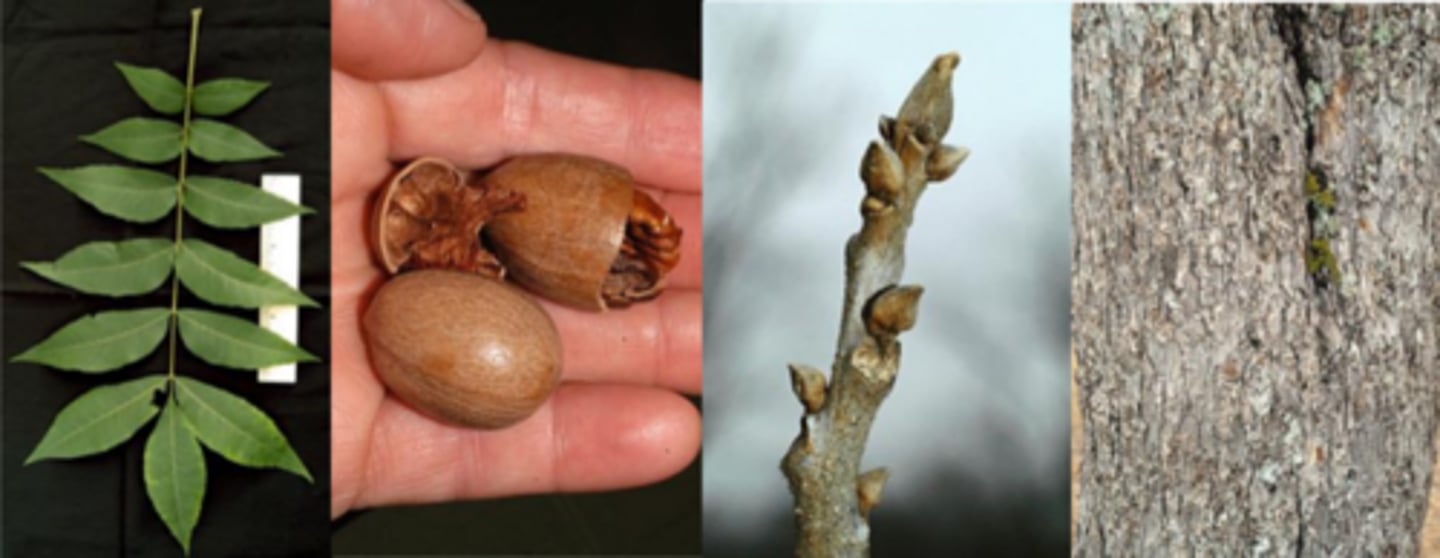
Ohio buckeye
Sapindaceae
Aesculus glabra
Leaves: opposite, palmately-compound, 4-10" long with 5-7 leaflets each obovate; leaflet tip is obovate/acuminate, leaf base is cuneate, obtusely double serrate leaf margin; rusty tomentose near base beneath, no petiolules attached to individual leaflets; leaflets, oval to obovate leaflets, 3-6" long with a serrated margin, rachis about as long as leaflets, dark green above and paler below. Strong fetid odor when crushed.
Twigs: stout, with a large shield-shaped leaf scar; fetid odor when broken;
Buds: terminal bud large, tan (peanut butter) colored w/ keeled scales; have a "skunky" odor; opposite lateral buds are much smaller.
Fruit: prickly, leathery husk (a capsule) husk orange-brown w/ short spines, enclosing usually 1-2 smooth chestnut brown seed (1-1½" in diameter). Borne on a stout stalk and mature in fall. Seeds (buckeyes) rich, lustrous reddish-brown color.
Bark: initially smooth, ashy gray but later developing corky, scaly patches, becoming quite rough and darker gray.
Form/Silvics: medium-sized tree, 60-80', 24" dbh. Oblong crown with pendulous up turning branches. Common in forest understories, associated w/ limestone soils. Tolerates shade, but becomes intolerant w/ age.
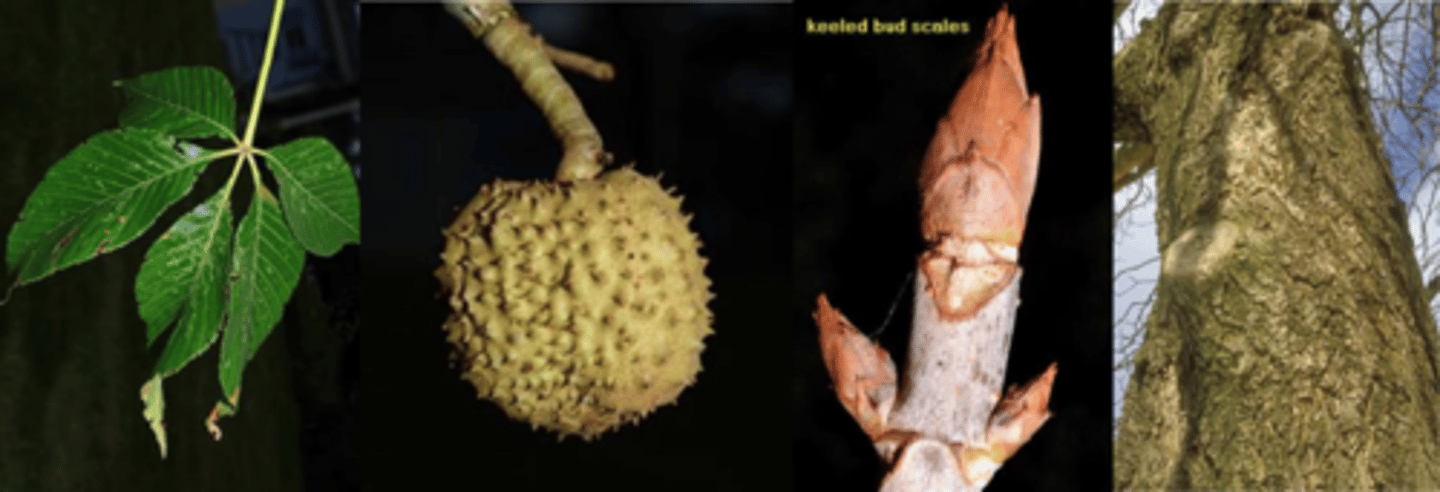
eastern black walnut
Juglandaceae
Juglans nigra
Leaves: alternate, pinnately compound, up to 23 leaflets, terminal leaflet is often missing, rachis is pinkred on young trees, yellow on mature trees.
Twigs: stout, pith is chambered/brown, leaf scar lacking a hairy fringe (like butternut).
Buds: gray, pubescent, essentially naked.
Fruit: globose nut (golf-ball size) within a smooth, indehiscent husk, shell corrugations are rounded (unlike butternut).
Bark: dark, brown w/ deep, narrow fissures and thin interlacing ridges (appear criss-cross), chocolate brown inner bark.
Form/Silvics: prefers well-drained, fertile deep soils with adequate moisture. Normally found near streams and well-drained bottomlands. Nuts and twigs have an odor. Most valuable hardwood timber species in North America.
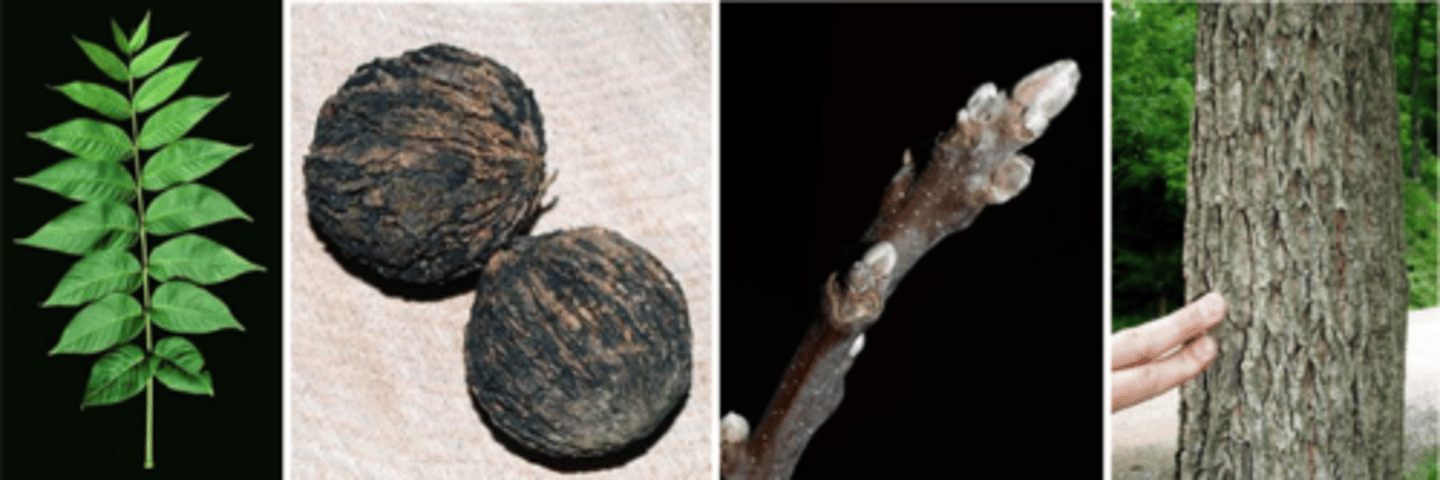
sweetbay magnolia
Magnoliaceae
Magnolia virginiana
Leaves: Alternate, simple, semi-evergreen, oblong-lanceolate 3-5 inches long; lustrous above, glaucous beneath
Twigs: green, slender, glaucous or pubescent; pith is diaphragmed
Flowers: creamy white, lemon scented, 2-3 inches across; May-June
Fruit: Aggregates of follicles. 2” long with bright red seeds in the fall
Form/Silvics: Small tree found along Atlantic coast. Can grow on moist sites, along with sweetgum. Small multi-stemmed shrub/small tree
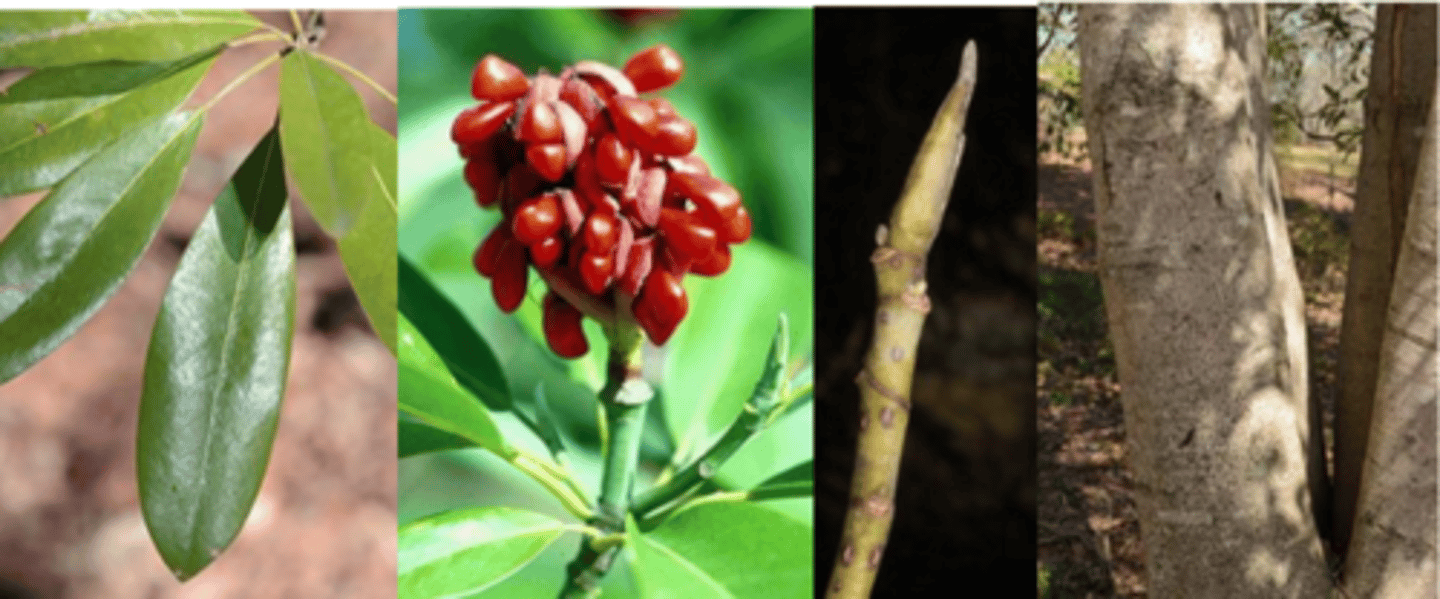
hackberry
Ulmaceae
Celtis occidentalis
Leaves: alternate, simple (resembling elms, but Celtis leaves are only singly serrated), leaf tip is acuminate, leaf base is lopsided (like elms), rough/dry textured, margins are always toothed.
Twigs: slender, gray
Buds: pseudoterminal bud, triangular, smooth, flat, at an angle to the twig. Triangular shaped lateral buds appressed to zig-zag twigs.
Fruit: round, dark purple drupe on long stalk; ripens in early fall.
Bark: distinctive w/ discontinuous warty ridges/scales on mature trees.
Form/Silvics: Can grow up to 200 years, 90' tall. Prefers deep well-drained bottomlands; seeds moved by birds (common to fencerows); shade tolerant; drought, heat and salt tolerant.
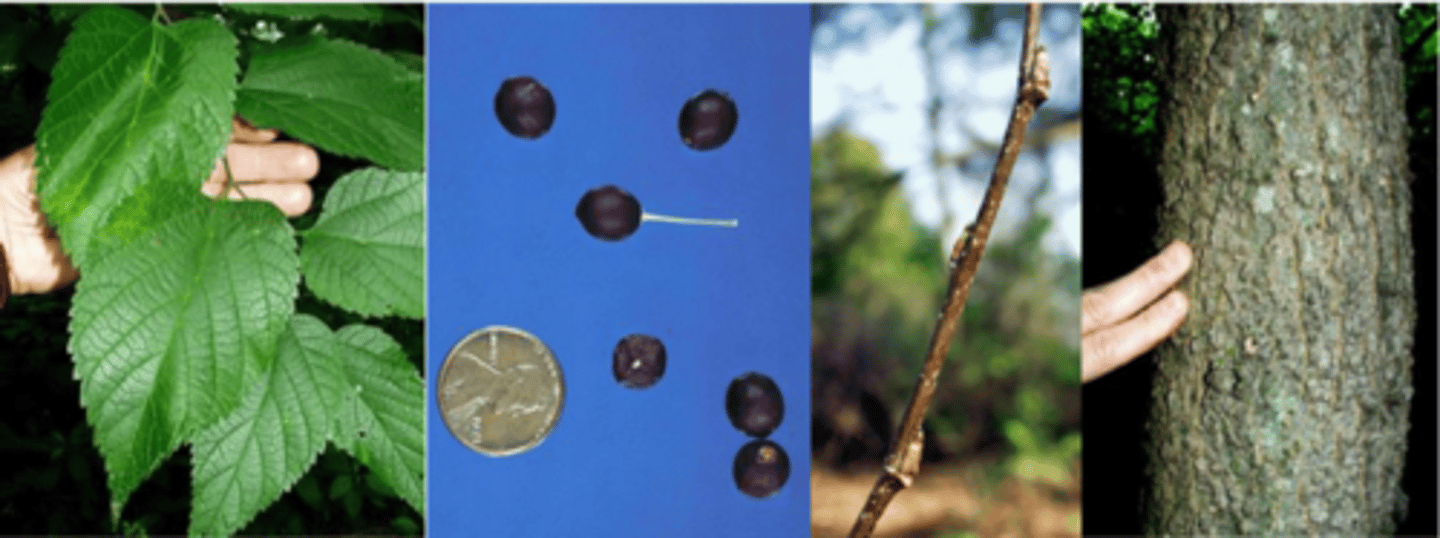
shingle oak
Fagaceae
Quercus imbricaria
Leaves: alternate, simple, 3-7" long, broadly lanceolate, un-lobed with a single, terminal bristle-tip, somewhat leathery, shiny dark green above and paler and fuzzy below.
Twigs: slender, olive-green to orange-brown, quite lustrous
Buds: conical, pointed/angled, red-brown buds
Fruit: Acorns are 5/8" long, 1/3 to 1/2 covered by a thin, bowl-shaped cap with appressed light brown scales, matures in the fall after two years.
Bark: gray-brown, tight and quite hard, with broad, irregular ridges and very shallow furrows.
Form/Silvics: pioneer species; medium sized tree to 70't with pyramidal to oval and later rounded crown; lateral lower branches often droop. Best development on moist soils along streams or on hillsides in mixtures with pin, overcup oaks, elms and hickories.
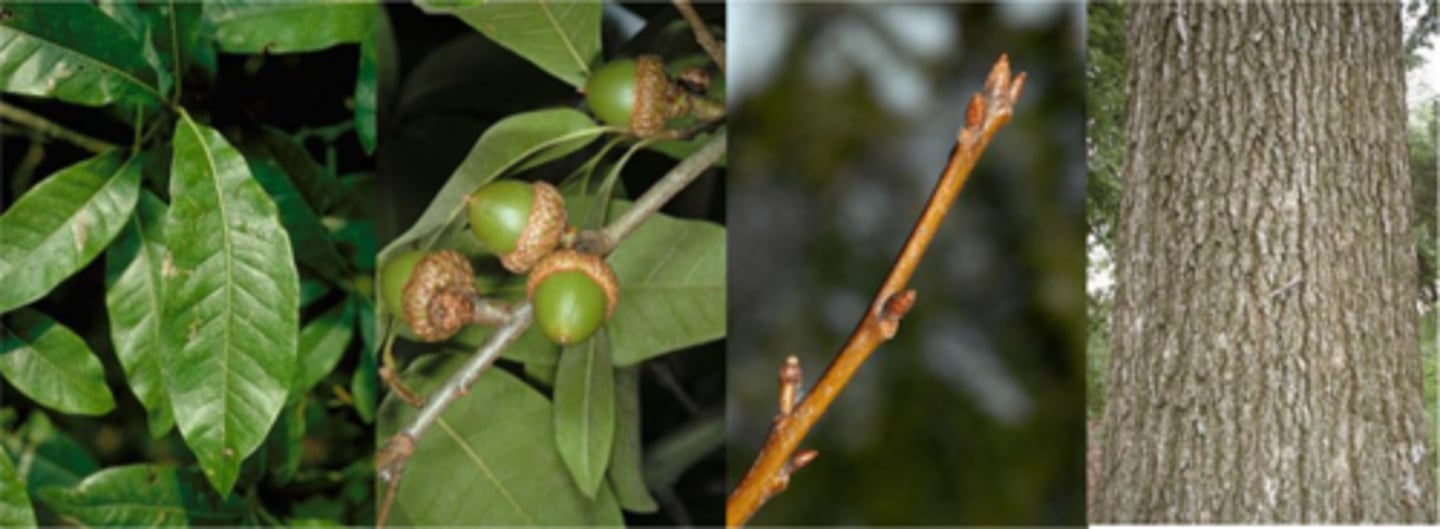
sweetgum
Hamamelidaceae
Liquidambar styraciflua
Leaves: No other tree has a similar “star shaped” leaf; alternate, simple, finely serrate, 5-7 lobes (styrac = star), on a long petiole. Glossy above and aromatic when crushed (carrot smell). Fall color orange-red-purple, often on same tree.
Twigs: often have irregular corky ridges (like Q. macrocarpa). Leaf scar has 3 bundle scars in a row.
Buds: very shiny, dark green/brown w/ imbricate scales.
Fruit: Syncarp (=fleshy, aggregate fruit), star-shaped beaked capsule that are pendulous (spikeball). Somewhat woody, will persist on the ground for many years.
Bark: looks like cottonwood on young trees; mature bark is dark gray, deeply fissured w/ narrow, rounded ridges.
Form/Silvics: Mature size, 60-75’ tall. Primarily a southern tree species, but is found on wet sites in the lower Midwest; prefers moist, alluvial sites. It is shade tolerant (pioneer species). Can reproduce by root suckers to rapidly colonize a disturbed site.
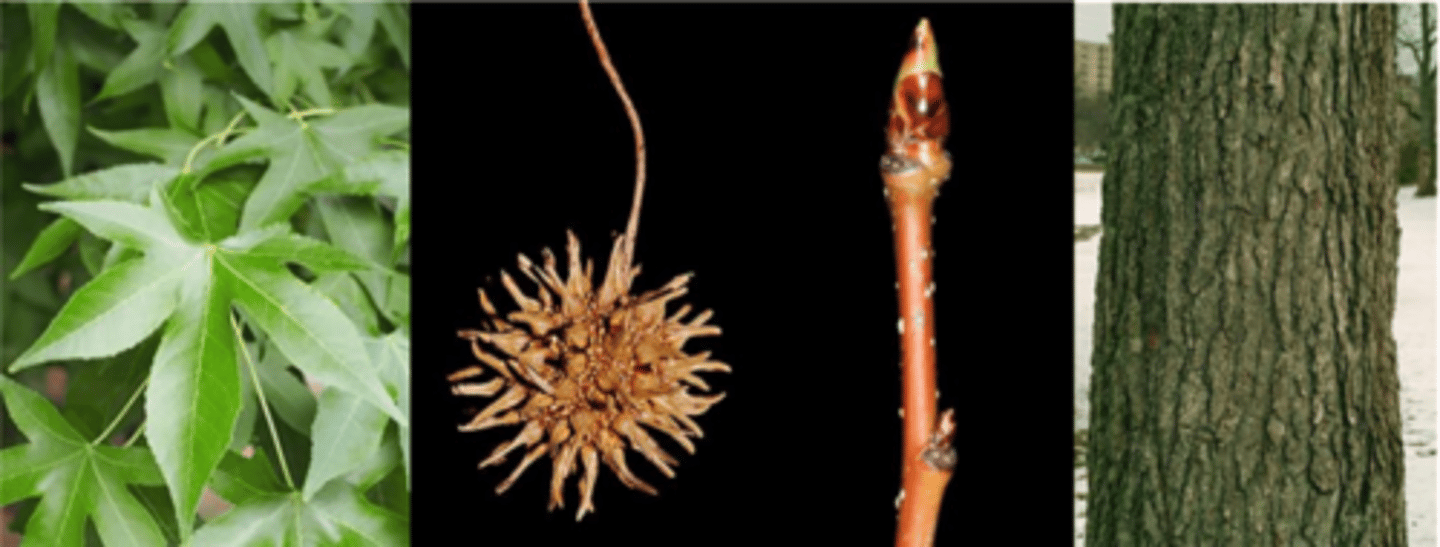
black cherry
Rosaceae
Prunus serotina
Leaves: Alternate, simple, 2 to 5 inches long, oblong to lance-shaped, finely serrated, very small inconspicuous glands on petiole, dark green and lustrous above, paler below; usually with a dense yellowish-brown, sometimes white (or brown) pubescence along mid-rib.
Twigs: slender, reddish brown, sometimes covered in gray epidermis, pronounced bitter almond odor and taste;
Buds: very small (1/5"), covered in several glossy, reddish brown to greenish scales; leaf scars are small and semicircular with 3 bundle scars.
Fruit: dark purple round drupe, almost black when ripe, 1/3" in diameter with a bitter-sweet taste; matures in late summer (August). Eaten by at least 33 species of birds, and other rodents
Bark: smooth with numerous short, narrow, horizontal lenticels when young; becomes very dark (nearly black), breaking up into small, rough, irregular, upturned plates (burnt corn flakes), when older.
Form/Silvics: medium sized tree which (on good sites) develops a long, straight, clear bole and can reach heights approaching 100'. Other: second in demand to walnut for quality wood products. Serotina means "late-flowering"
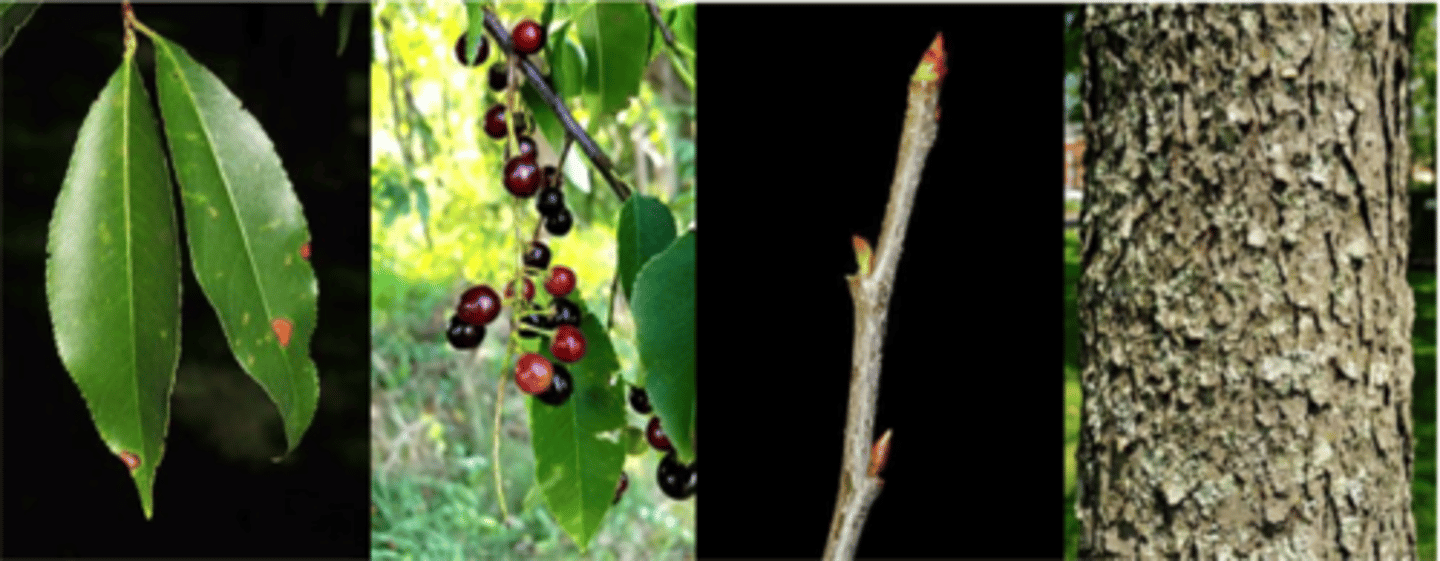
willow oak
Fagaceae
Quercus phellos
Leaves: alternate; simple; 2-5” long; willow-shaped; entire, w/ small bristle tip; dark green in summer, turning yellow in fall.
Twigs: slender, red-brown & hairy when young, turning gray/glabrous.
Buds: terminal bud 1/8” long; ovoid; sharp-pointed; covered w/ chestnut-brown scales paler on the margin.
Fruit: brown acorns w/ dark stripes, ½” long; acorn cap covers 25% of acorn length; cup scales thin, pubescent, w/ somewhat greenish red tinge.
Bark: reddish-brown on young trees turning dark gray w/ irregular scales.
Form/Silvics: medium-large tree w/ dense, pyramidal crown; straight trunk and willow-like leaves. A southern oak species that prefers wet bottomland sites
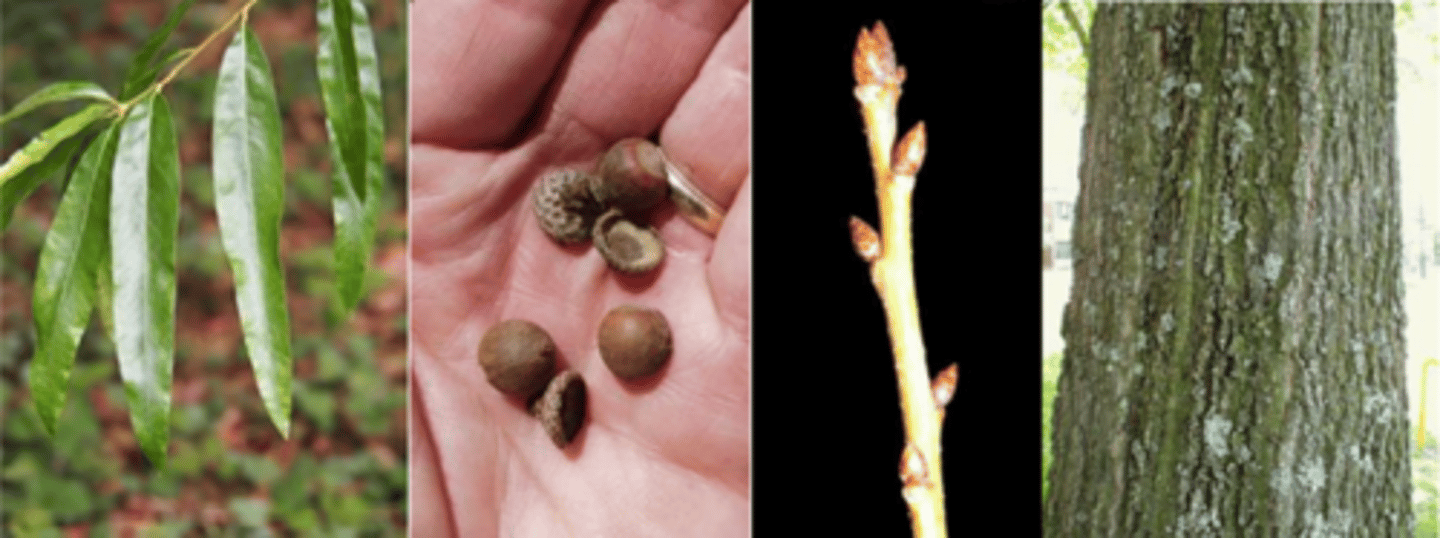
green ash Oleaceae Fraxinus pennsylvanica
Leaves: opposite, pinnately compound w/ 7 lanceolate leaflets. Grooved rachis (much more so than white ash). Has attractive yellow fall color.
Twigs: slender to moderately stout. Gray to greenish brown, dark brown, upper leaf scar is straight across with slight notch for lateral bud.
Buds: terminal buds conical to ovate, rusty brown, pubescent; lateral buds reniform to triangular
Fruit: dioecious! Fruit a samara, seeds narrow, sharply pointed (compared to white ash), wing extends to more than halfway down, alongside seed.
Bark: Mature bark has small interlacing diamond patterns, usually repeating every inch. Inner bark is tan colored.
Form/Silvics: Mature size: 50-60' tall, 20" dbh. A large statured species found on wet-moist sites throughout the Midwest. Has a very large natural range upright, w/ an upright, spreading habit when mature.
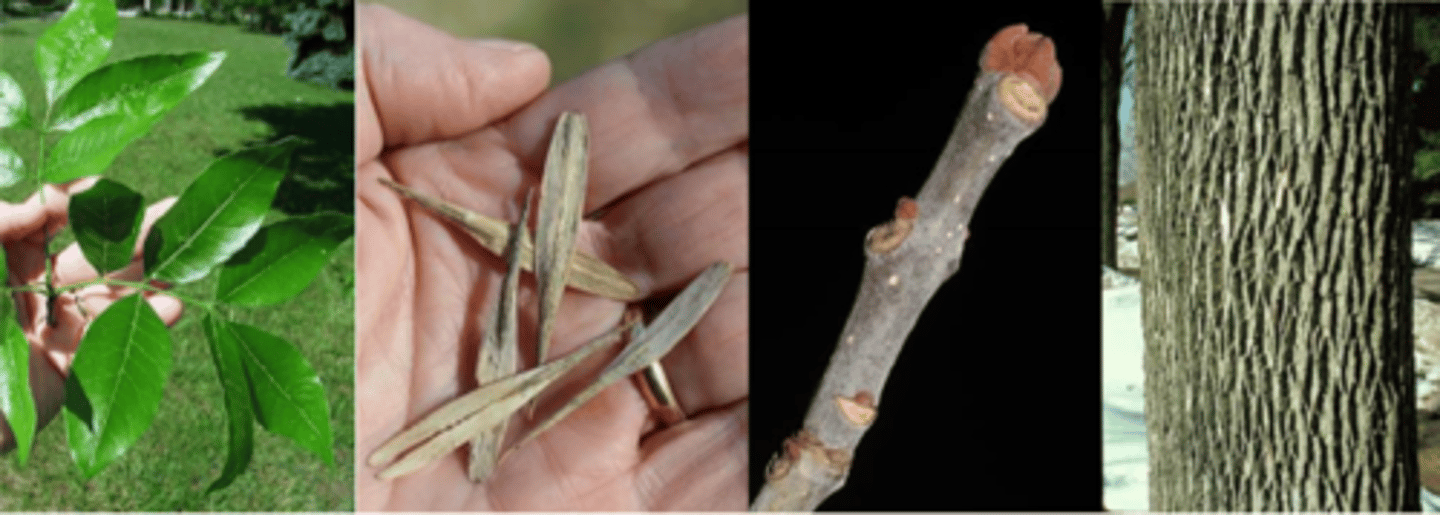
blackgum. black tupelo
Cornaceae
Nyssa sylvatica
Leaves: tiny, alternate, simple, obovate, acute to obtuse, cuneate or rounded, lustrous dark green above. Fall color can be a brilliant yellow to orange to scarlet to purple (multi-colored on some trees; like sweetgum only better). Random red leaves most of the year.
Twigs: tannish-red, smooth w/ 3 bundle scars/leaf scar; pith is white and diaphragmed (segmented). Corkiness from leaf scars near leaves. Contrasting white leaf scar with bud on top
Buds: ovate w/ 3-5 imbricate scales, each of which has a dark colored tip.
Flowers: primarily dioecious but not always. Can have seeds on "male" trees.
Fruit: ½" blue-black drupe on 1-2 in stalk.
Bark: nearly black on mature trees w/ thick blocky ridges (alligator hide?); golden brown inner bark.
Form/Silvics: best growth on moist alluvial soils, but very cosmopolitan and will grow on relatively dry, upland sites. Mature size: 50-60' tall, 24-36" dbh
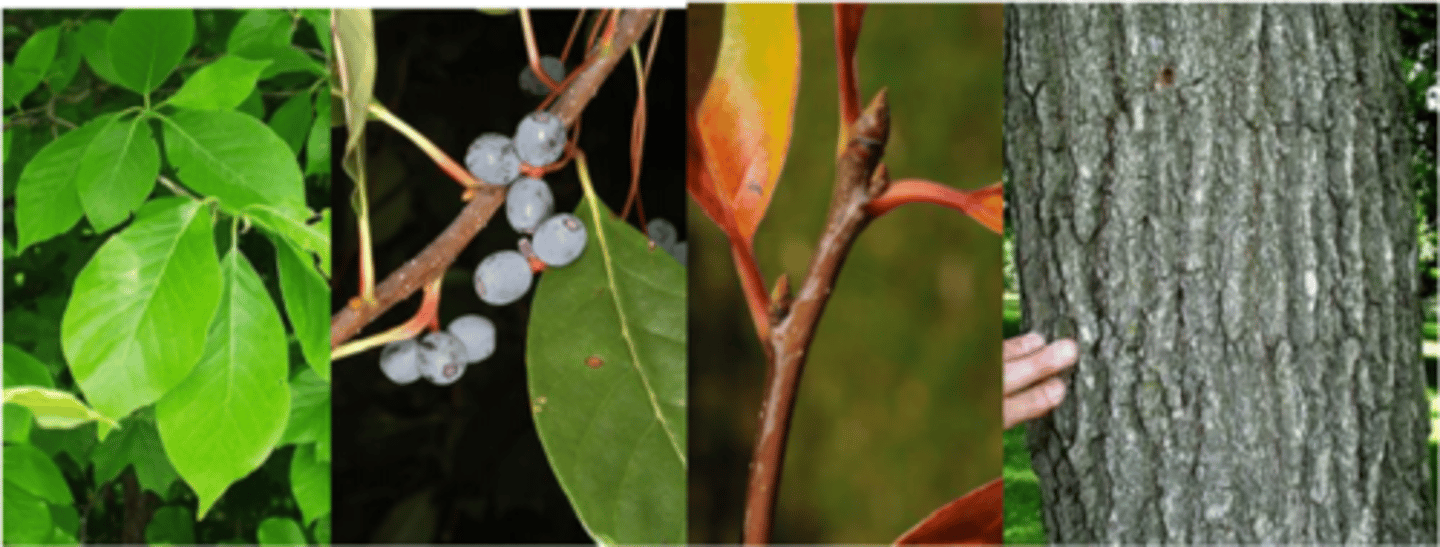
yellowwood
Fabaceae
Cladrastis kentukea
Leaves: alternate, pinnately compound, 5-11 leaflets that are not always opposite. Each leaflet attached to rachis by a petiolule. Base of petiole completely encloses bud (like Platanus sp.). Leaflet margins entire w/ abrupt, acuminate tip. Waxy top and yellow/orange/brown near margin in fall
Twigs: slender, zig-zag growth pattern; shiny, brown.
Buds: no terminal buds present. Lateral buds are hairy w/ usually 2-4 small buds clumped together.
Flowers: May-June, white, pendulous clusters, fragrant.
Fruit: thin, flat papery, indehiscent, pendent, 1'3" long x ½" wide
Bark: Very smooth (like elephant skin), light gray color, similar to American beech; no fissures.
Form/Silvics: limited range in extreme southern MO; prefers rocky drainages/protected sites. Extensively grown as an ornamental tree (bark, flowers).
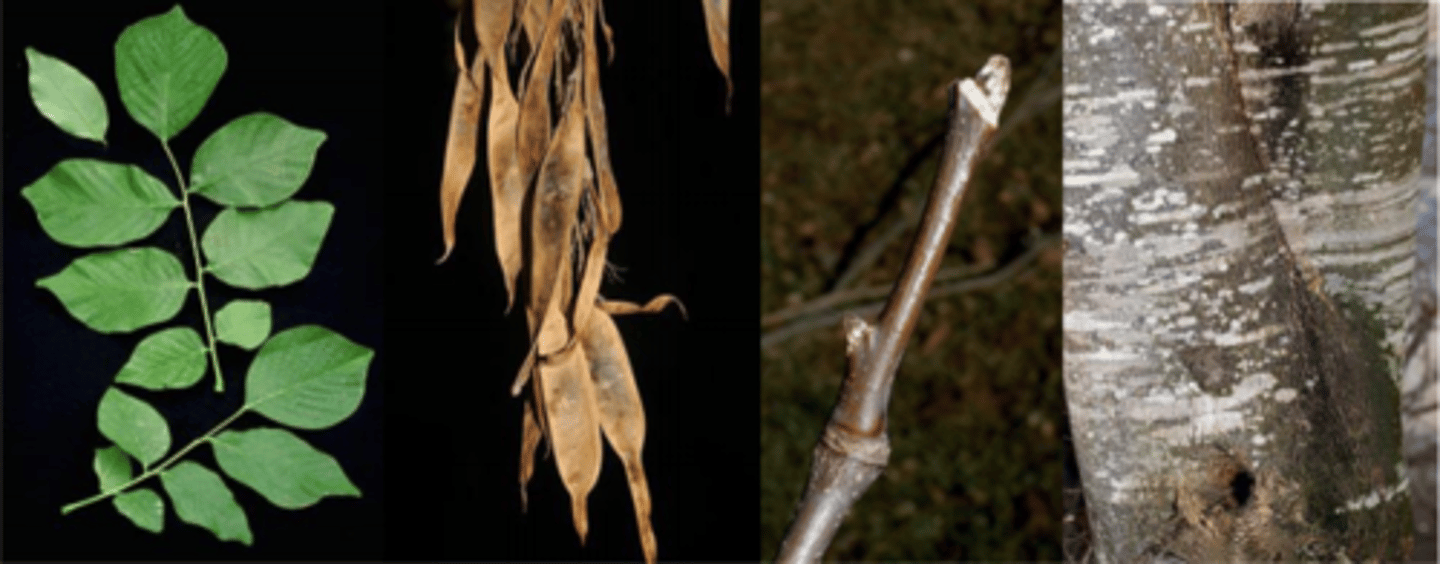
Kentucky coffeetree
Fabaceae
Gymnocladus dioicus
Leaves: alternate, bi-pinnately compound w/ up to 70 leaflets/leaf arrayed on 3-7 prs pinnate “branches”, up to 32” long; blue-green color, pubescent beneath.
Twigs: red/gray/brown; pith is salmon pink colored
Buds: essentially sunken into the twig and hidden; stout twigs are.
Fruit: 4-6" dark brown, leathery pod with hard-shelled seeds in sticky pulp.
Bark: scaly, gray-brown w/ very hard, sharp edged ridges.
Form/Silvics: unusual native tree; mature size 75-100’ tall x 40-50. Named for its use as a coffee substitute by pioneers; but, raw seeds and pulp between them are poisonous!

eastern hophornbeam, ironwood
Betulaceae
Ostrya virginiana
Leaves: alternate, simple, elliptical to ovate, serrated, 3-5" long, pinnately veined, veins somewhat sunken on upper surface giving the leaf a distinctly quilted look, slightly doubly serrated, waxy smooth/soft-ish, green above and paler below. Some curve under like talons.
Twigs: Slender, smooth, red brown, fine/thin vertical lighter lenticels;
Buds: terminal bud ¼" long, green turning to a light brown, vertical striations can be seen w/ hand lens; lateral buds slightly angled, pointed and curling slightly around twig.
Fruit: Small, ribbed nutlet carried on a lobed, slightly serrated, folded leafy bract (1 inch long), bracts are clustered on a long (3 inch) hanging stalk; ripen in early fall and disperse through the winter.
Bark: Thin, smooth gray brown when young; "shreddy", broken into small, thin, narrow, vertical strips that curve away from trunk on older trunks.
Form/Silvics: very shade tolerant; commonly found as an understory in mixed hardwoods stands
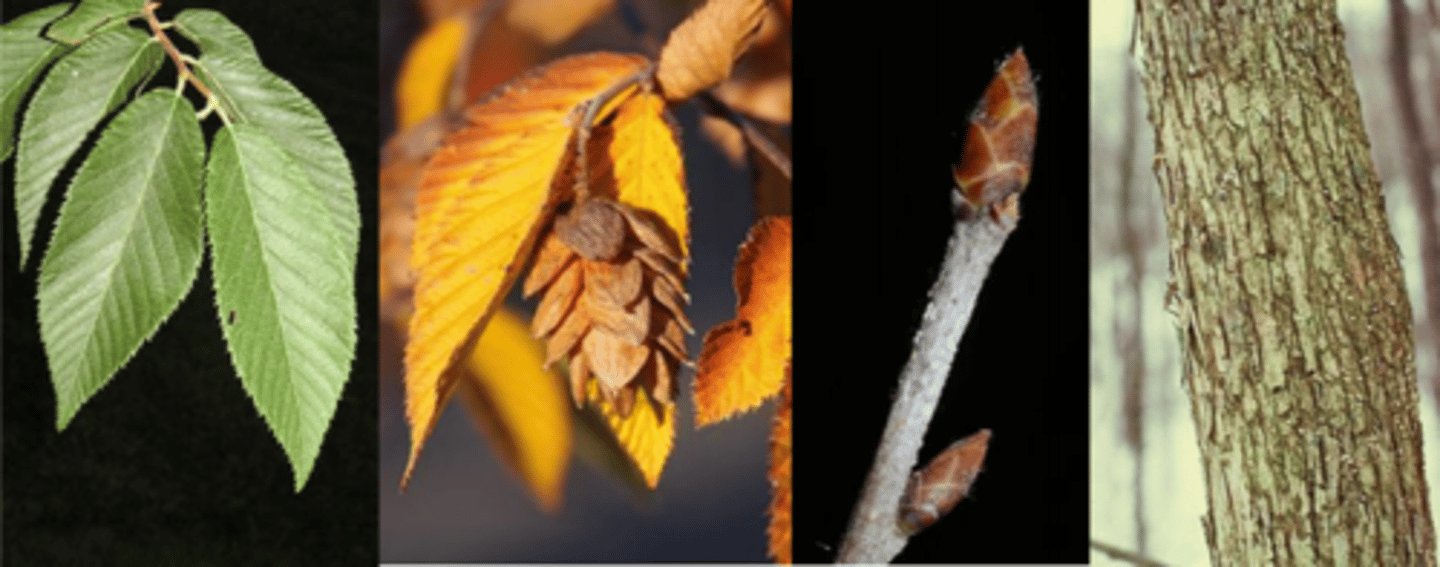
white ash
Oleaceae
Fraxinus americana
Leaves: opposite, pinnately compound with 7 serrate to entire leaflets that are ovate to somewhat lanceolate, 8 - 12" long, essentially hairless, green above and slightly paler below. Often purple in fall
Twigs: stout, gray-olive-green, hairless, leaf scars round at the bottom, notched at the top, with lateral buds in the notch; leaf scars are deeply notched (U-shaped) across the top (not like green ash, which is shield shaped).
Buds: terminal bud is large, brown, with leathery scales and flanked by two lateral buds
Fruit: dioecious, flattened winged samara borne in clusters. Wing covers less than half of seed length.
Bark: tight, interlacing diamond-shaped pattern of ridges and furrows. May have white patches (fungal) on bark of woods grown trees. Bark is cork colored when chipped.
Form/Silvics: Occurs in bottomland forests along streams, slopes, base of bluffs, upland and rocky woods, and glades; whereas green ash favors streams, borders of swamps and ponds
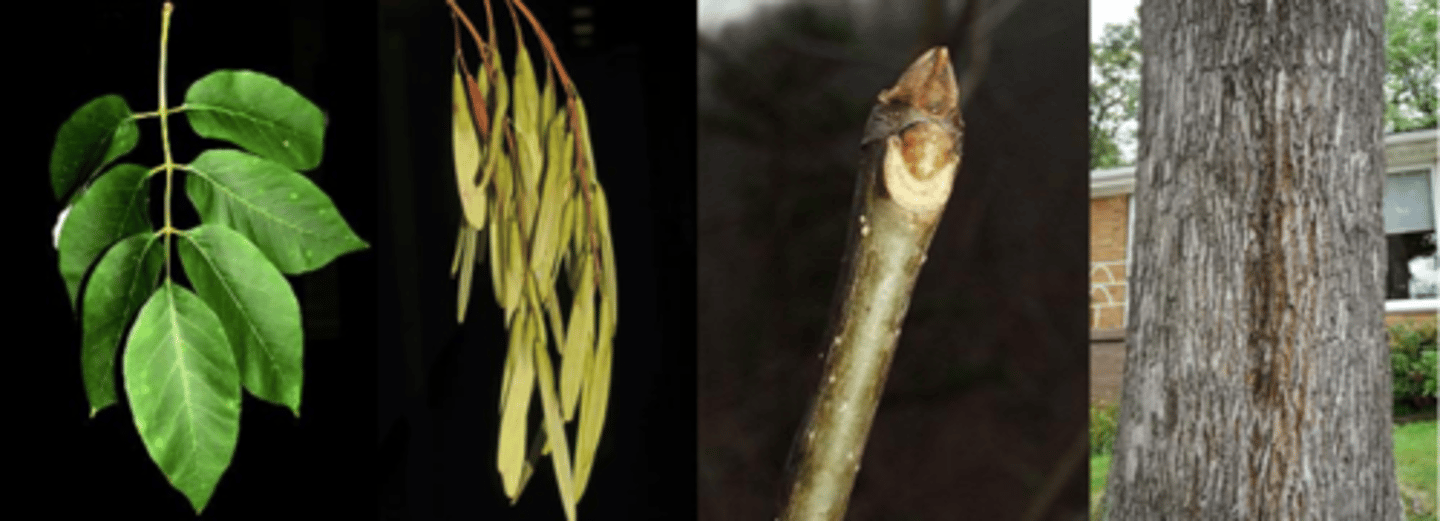
sugarberry
Ulmaceae
Celtis laevigata
Leaves: alternate, simple, lanceolate long acuminate, sometimes with teeth, leaves are smaller than hackberry, 2-4” long, thin, light green in color, smooth on both sides.
Twigs: zig-zag, reddish brown, somewhat lustrous
Buds: similar to hackberry; pseudo-terminal, triangular and flat.
Fruit: orange- red to blue black, sweet and juicy, on 1” stalk, early fall maturity.
Bark: normally without wart-like projections, but if present, corky ridges are not continuous. Much smoother than hackberry. Lighter-colored splotching on most.
Form/Silvics: Site preference: prefers floodplains, sloughs, clay soil, but tolerates urban conditions well; resistant to witches’ broom; flood and shade tolerant. Mature size 60-80’ tall.
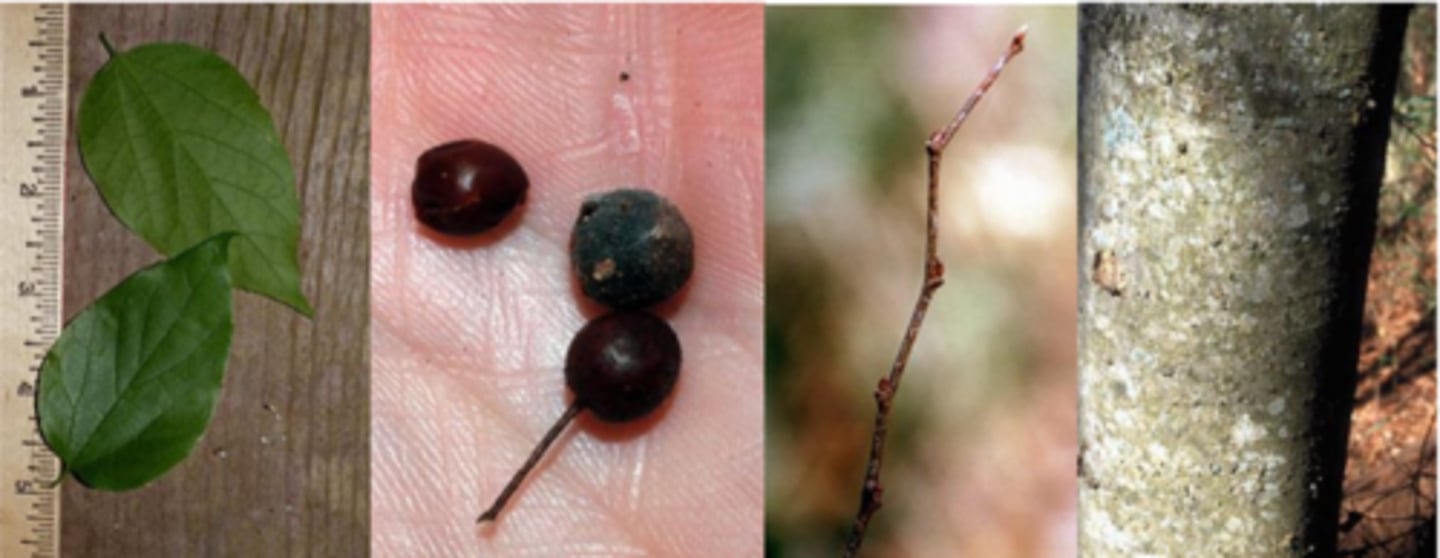
American hornbeam, musclewood
Betulaceae
Carpinus caroliniana
Leaves: alternate, simple, elliptical to ovate, 3-5" long, pinnately veined, tip acuminate, doubly serrate margin; waxy, smooth green above, paler below.
Twigs: slender, somewhat zigzag, brown to gray in color;
Buds: brown, angled, with a tan silky edge to each scale (making the buds appear lined), (buds are not as pointed, nor do they "curve around the stem" like C. betulus); approximately 1/4 inch or less in length.
Fruit: small ribbed nutlet carried on a 3-lobed, slightly folded leafy bract that is 1 inch long (somewhat resembles a maple leaf); bracts are clustered on a long (4-6") hanging stalk; ripen in late summer and fall, disperse through the winter.
Bark: Thin, smooth, gray to bluish gray regardless of age or size; trunk is fluted heavily, resulting in a muscular appearance; fluted (musclewood) with smooth rounded longitudinal ridges, wood dense (ironwood, musclewood)
Form/Silvics: A small, nearly shrubby tree reaching up to 25' tall with a rounded crown and a twisted trunk. Can grow in areas with heavy shade, wet sites and high pH. Usually found on north-facing slopes at base of bluffs, ravine bottoms, and moist sites.
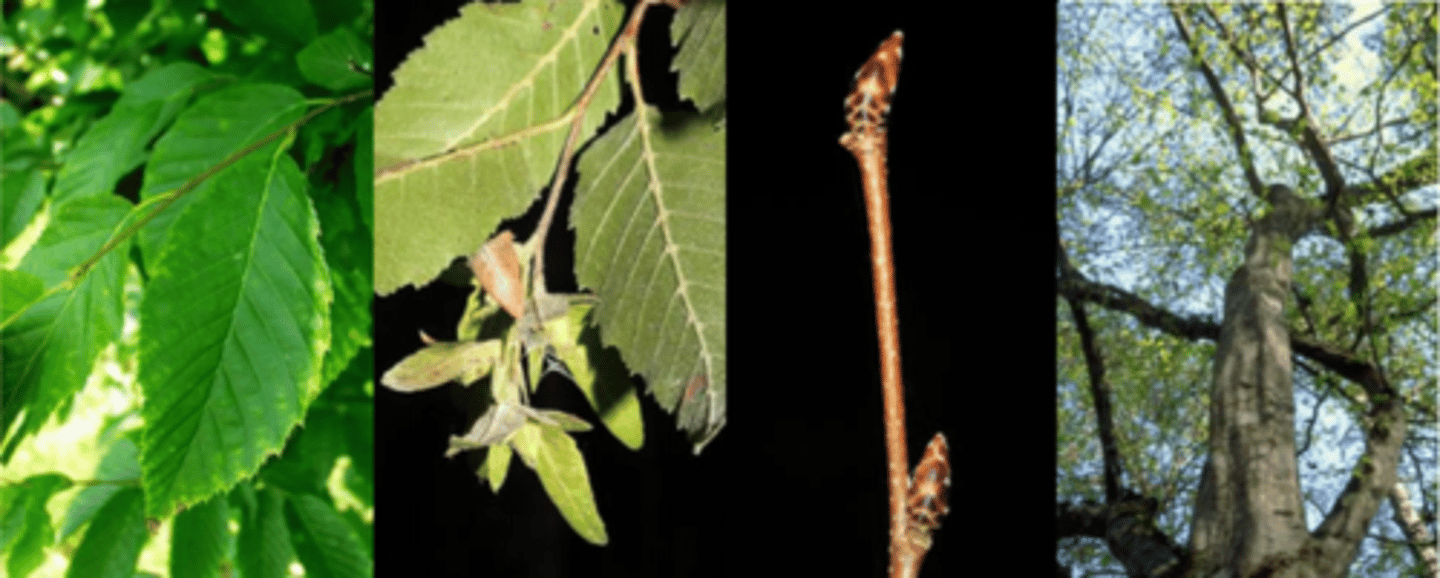
common persimmon
Ebenaceae
Diospyros virginiana
Leaves: simple; alternate, egg-shaped to broadest in the middle, 2 to 6 inches long, 1 to 3 inches wide; margin entire; tip pointed; upper surface dark green, shiny; lower surface paler, smooth to somewhat hairy
Twigs: slender; gray to reddish brown, somewhat zig-zag; terminal bud absent
Trunk: Bark dark brown to black, grooves deep, ridges broken into thick, square to rectangular blocks, wood dark brown, hard, strong, fine-grained
Fruit: September-October, about ¾ to 1 ½ inch long and wide, globe shaped, orange to orange-purple, often with a whitish coating astringent and pucker to taste when green; when ripe, sweet and edible.
Form/Silvics: Medium-sized tree up to 60 feet tall (or in open-grown situations up to 30 feet tall, with a shorter trunk and broad crown. occurs in rocky, dry open woods, edges of woods, glades, prairies, old fields, thickets, bottomland woods and valleys along streams
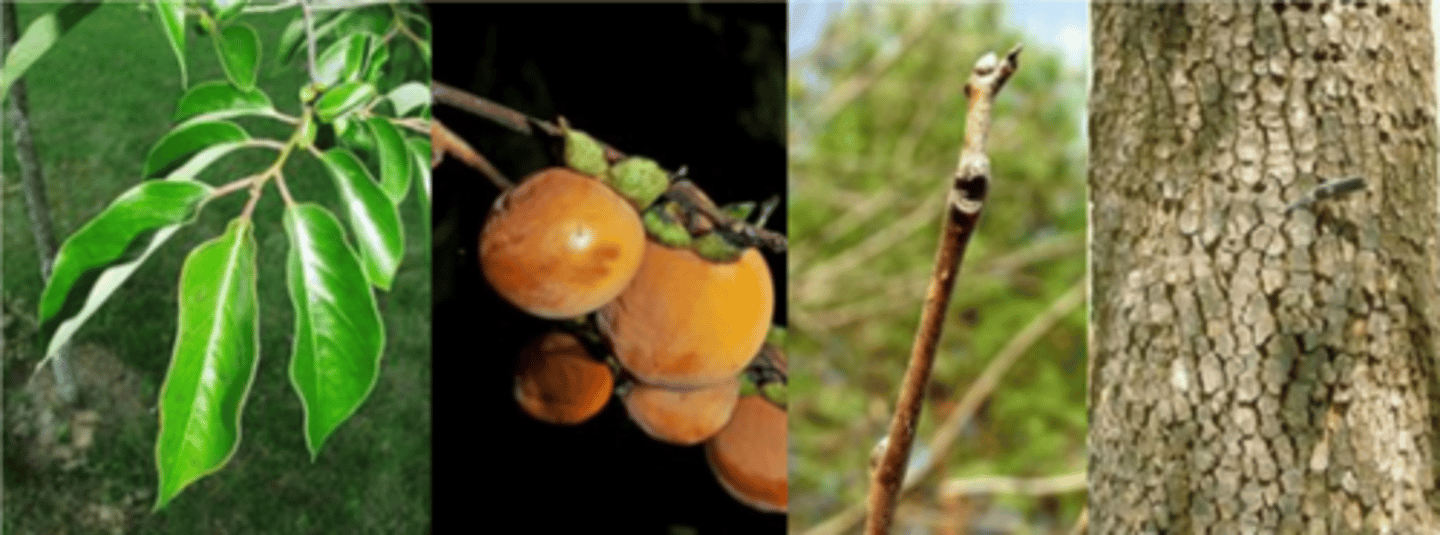
downy serviceberry
Rosaceae
Amelanchier arborea
Leaves: alternate, simple, obovate to oblong, small, finely serrate, tomentose when unfolding then dark green, turning orange-yellow in the fall.
Twigs: faint, bitter almond taste
Buds: slender, pointed, conical with silky hairs on scale edges
Flower: perfect, white in pendulous racemes in April; after redbud, but before flowering dogwood
Fruit: bright red pome 1/4 -1/3” turning almost nearly black when ripe in June (fruit is edible, 35 different species of birds and 11 mammal species love ‘em).
Bark: gray, smooth, attractive. Light gray and smooth when young, becoming dark gray w/ long, shallow furrows
Form/Silvics: found in open rocky woods/bluffs, normally well-drained; tall shrub or small tree ~20’; multi-stemmed, good native species.
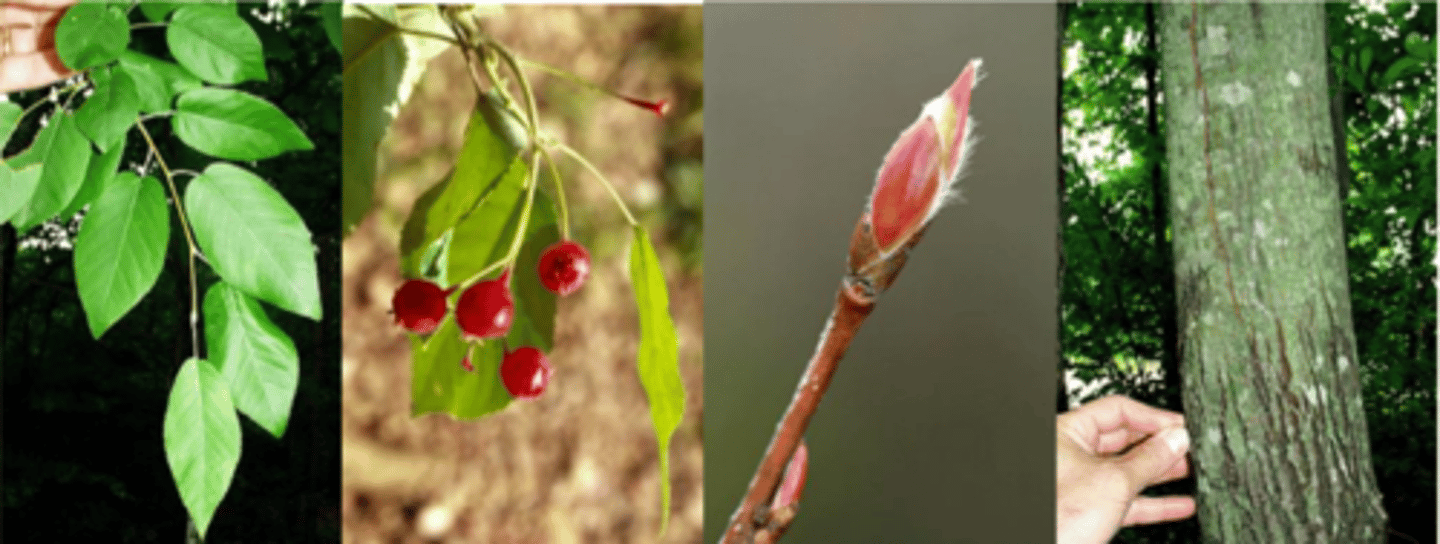
rusty blackhaw
Caprifoliaceae
Viburnum rufidiulum
Leaves: simple, opposite, small, 1-3" long, obovate, tip rounded to pointed, finely serrated margin, base is cordate or rounded; dark green above, leathery smooth, glossy; lower surface pale green w/ scattered rust colored hairs along veins and petioles (= roufus/rufidulum). Reddish fall foliage.
Twigs: slender, gray-brown, smooth; numerous, opposite short side branches (fish skeleton)
Buds: valvate buds more globose than blackhaw covered in rusty-colored hairs.
Fruit: September in drooping clusters, stalks are red, bluish-black fruit 3/8" long, smooth, edible.
Bark: rough ridges w/ rounded fissures or black, squared-shaped plates (reminiscent of persimmon, but on a smaller scale).
Form/Silvics: irregular branched shrub up to 18' tall. Occurs in rocky, dry woods to moist alluvial sites along streams.
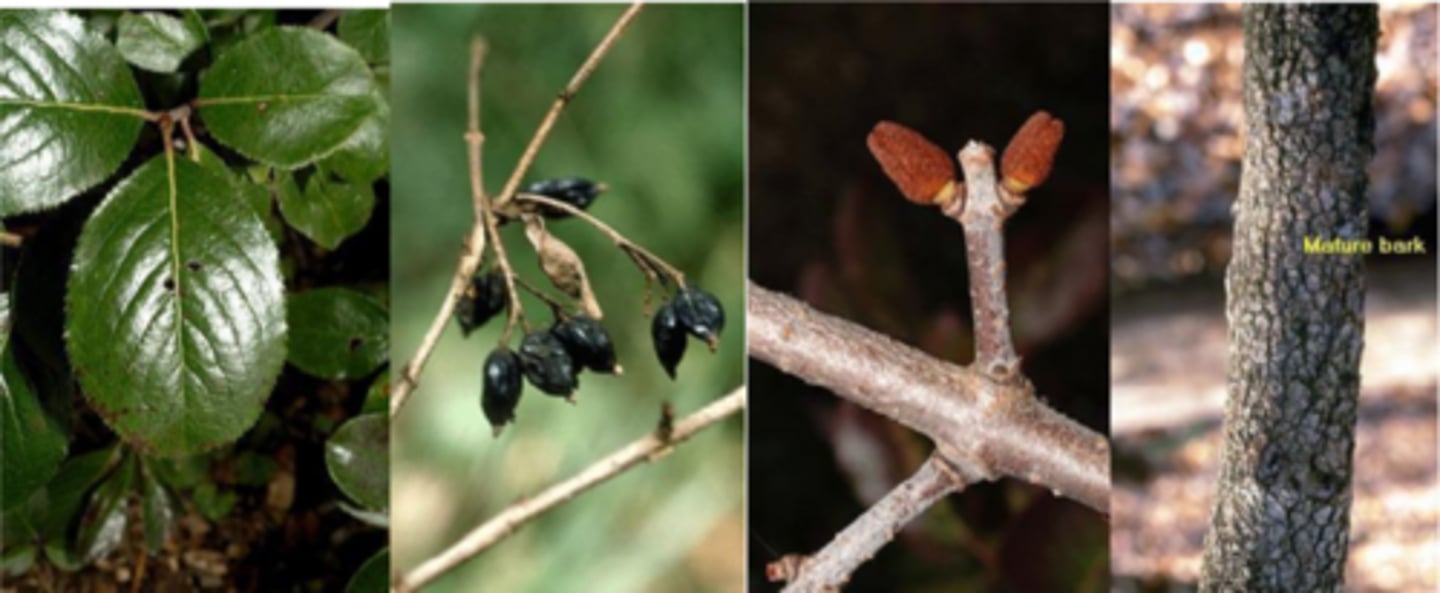
boxelder
Sapindaceae
Acer negundo
Leaves: opposite; compound w/ 3-7 leaflets (all on same tree), reminiscent of elderberry; light, shiny green above, pale/pubescent beneath; margins coarsely lobed. Similar to poision ivy leaves.
Twigs: slender, light green colored turning purple/brown; can have glaucous bloom on young twigs; leaf scars completely encircle twigs.
Fruit: 1.5 in. winged samaras in pendulous clusters 6-8 in. long; often persist all winter.
Bark: looks similar on all trees (except very young/small trees). Tannish-brown w/ thin irregular ridges and shallow fissures.
Form/Silvics: Commonly found on wet sites along creeks/rivers. A riparian species that can become weedy in some circumstances. Shade tolerant. Very fast growing tree, can be brittle.

American elm
Ulmaceae
Ulmus americana
Leaves: alternate, simple, ovate-obovate, acuminate tip, unequal at base, doubly serrate, herringbone pattern, scabrous top and bottom. smaller and smoother than U. rubra
Twigs: slender, brown, pubescent early in the spring becoming glabrous. Leaf scars have three bundle scars.
Buds: pseudo-terminal buds; ~1/4", ovoid; acute, but not sharp-pointed; chestnut brown
Fruit: disk-shaped samara 0.5 in. long, edged w/ fine hairs and has a distinctive notch on the end. Mature in the spring. Not showy.
Bark: dark gray w/ deep intersecting ridges; outer bark exhibits alternating white- brown layers in cross section (like bacon). spongy bark, thicker than U. rubra
Form/Silvics: Mature size 60-80'; the most common elm species in North America w/ vase-shaped crown (drooping branches) and a buttressed/flared base. Moderately shade tolerant, grows best on welldrained sites, but will tolerate sites that are prone to spring/fall floods.
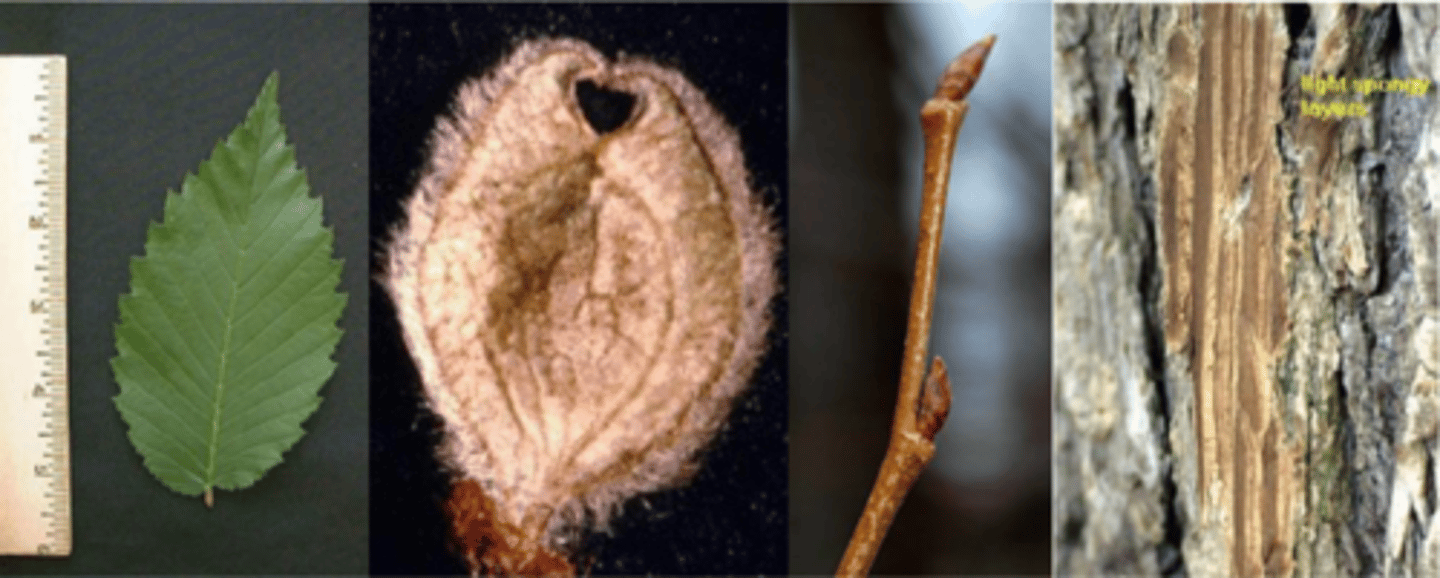
slippery elm, red elm
Ulmaceae
Ulmus rubra
Leaves: alternate, simple, ovate to oblong, 4-6" long, 2-3" wide, margin coarsely and sharply doubly serrated, base conspicuously inequilateral; dark green above and very scabrous, paler and slightly scabrous or hairy beneath.
Fruit: round, papery samara, ¾-1" inch across, margin and surface of wing smooth; surface of seed cavity pubescent, ripen in late spring.
Twigs: often stouter than American elm, slightly zigzag, ashy gray to brownish-gray (often mottled), scabrous and hairy
Buds: false terminal bud, lateral buds dark, chestnut brown to nearly black; buds may be rusty-hairy, twigs mucilaginous when chewed.
Bark: dark reddish brown, does not show buff-colored patches or streaks when sectioned; bark fissures not as diamond-shaped as American elm; inner bark mucilaginous.
Form/Silvics: intermediate shade tolerance; common in wet flats where standing water may accumulate; but, better growth on better-drained, rich bottomland soils; medium sized tree to 80'; trunk usually free of branches for a greater length than American elm, branches also less drooping.
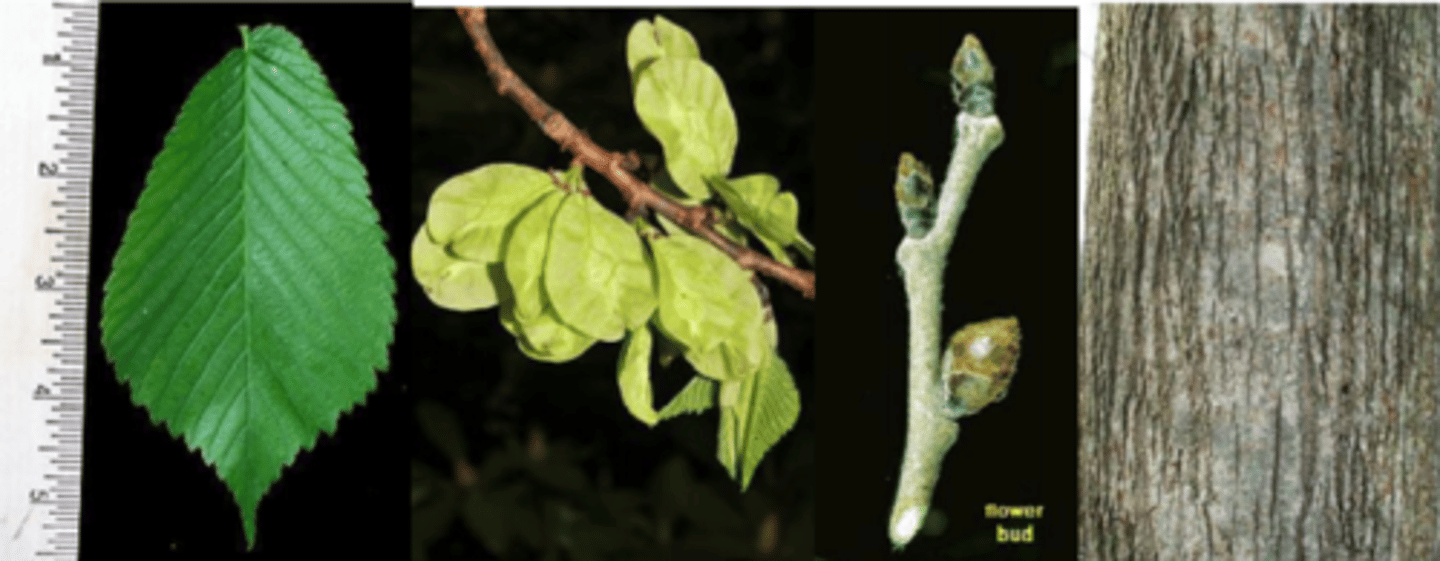
winged spindletree, burning bush
Celastraceae
Euonymus alatus
Leaves: opposite to sub-opposite, simple elliptic to obovate; leaf tip acute finely and sharply serrate petiole 1/12", brilliant red fall color; stem with corky wings (alatus); overall rounded shape of plant; orange/red seeds in Sept/Oct.
Twigs: glabrous, green-brown w/ 2-4 corky wings.
Flower: Perfect, inconspicuous, pale, yellow-green, 1/2 inch across, occur in clusters of three, appear in late spring.
Form/Silvics: nice, red fall color (Burning Bush), twigs texture, branching pattern interesting in winter, makes a good hedge or screen with little pruning. Can become invasive (in New England). Widely planted as an ornamental. Mature size 10-15'.

eastern redcedar
Cupressaceae
Juniperus virginiana
Leaves: Evergreen, very small, with two types of leaves (often on the same tree); scale-like, layered leaves 1/16” long, dark green, with 4 sides held tightly to twig and longer (1/4”), dark blue-green needle-like leaves that are more common on young trees and fast growing shoots.
Flower: Species is dioecious, but occasionally monoecious; males are small, yellow-brown, occurring in large groups; females are light blue-green.
Fruit: Berry-like cones, light green in spring, turning dark blue and glaucous at maturity, about ¼” in diameter, appearing in spring and maturing in the fall.
Twig: Green for several years, covered in scales, later turning brown.
Bark: Red-brown in color, exfoliating in long, fibrous strips, often ashy gray where exposed.
Form: A small tree with a dense ovoid or columnar crown reaching up to 60’ tall.

overcup oak Fagaceae Quercus lyrata
Leaves: alternate; simple; oblong-obovate; 5-8" long, 1½ - 2" wide; mostly 5-9 lobes (fewer lobes) with broad irregular sinuses; acute apex; cuneate base; margins entire AND very variable; surfaces dark green and glabrous above, green and nearly glabrous, or silvery white and downy below; fall color ranges from yellow to red to brown.
Twigs: slender, gray; stipules often persistent near the tip of the twig
Buds: terminal buds are small, about 1/8" long; ovoid to globose; covered with light, chestnut-brown hairs, somewhat tomentose.
Fruit: solitary or paired acorns; sessile or slightly stalked; nut 1/2 -1" long, with the diameter usually greater than the length; subglobose to ovoid; 2/3 to almost entirely enclosed in a deep, thin, unfringed cup.
Bark: somewhat similar to white oak, but more brownish-gray and rough with irregular ridges (no ski tracks); trunk frequently has a twisted appearance.
Form/Silvics: not an important or abundant species except in the main bottomlands of the lower Mississippi River and its tributaries; grows on wet, poorly drained clay soils; better adapted to withstand prolonged inundation.
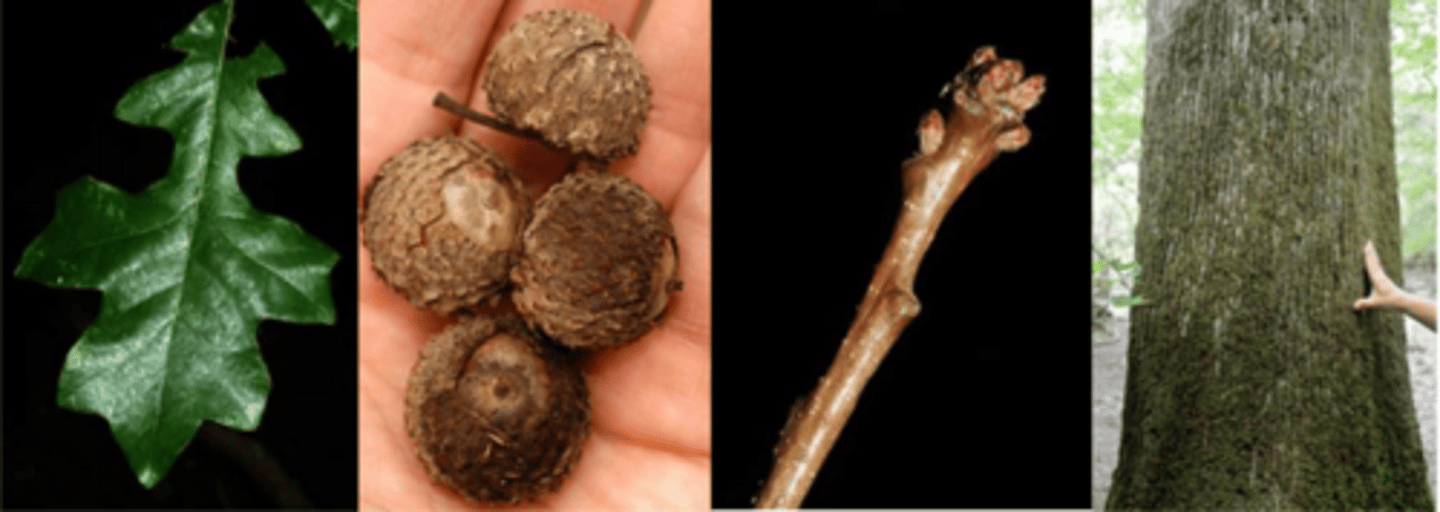
horsechestnut
Sapindaceae
Aesculus hippocastanum
Leaves: Opposite, palmately compound leaf with usually 7, obovate, serrate leaflets (4-6" long), dark green above and paler below, petioles as long as leaflets.
Flower: Creamy white in a large showy upright cluster, 5 to 8 inches long, appear in spring.
Fruit: Nearly round with thick, leathery very spiny husks enclosing 1 to 3 smooth, chestnut brown seeds.
Twig: Stout, with a large shield-shaped leaf scar; terminal buds are large (½ - 1"); shiny, sticky and reddish brown, lateral buds are much smaller.
Bark: Light to dark brownish gray, developing irregular scaly, rough ridges.
Form/Silvics: Upright, 40 to 60 feet tall with a round or oblong crown, 1-2' in diameter. Looks like: yellow buckeye, Ohio buckeye

golden raintree
Sapindaceae
Koelreuteria paniculata
Leaves: Alternate, feather-like arrangement, sometimes split again, 6 to 15 inches long; 7 to 15 leaflets, broadest near the base; margin coarsely toothed, sometimes lobed, tip pointed; upper surface emerging bronzed, maturing to dark green, smooth; lower surface paler, smooth; leaves turn greenish-yellow, yellow, or golden yellow in autumn
Twigs: somewhat zigzag, olive to light brown, smooth
Trunk: Bark light gray-brown, thin older branches and trunk with significant ridges and grooves; trunk short, branching early, quickly losing its central leader
Flowers: June-July, complete, with both male and female parts, flowers yellow with red center, showy
Fruit: September-October in clusters of brown, 3-sided bladder-like, papery capsules, 1 to 2 inches long; seeds black, capsules or pods appear as Chinese lanterns and persist into winter
Form/Silvics: Small to medium-sized tree, up to 40 feet tall, with an equal spreading crown, in a broad, somewhat irregular globe-shape. Some branches appear twisty.
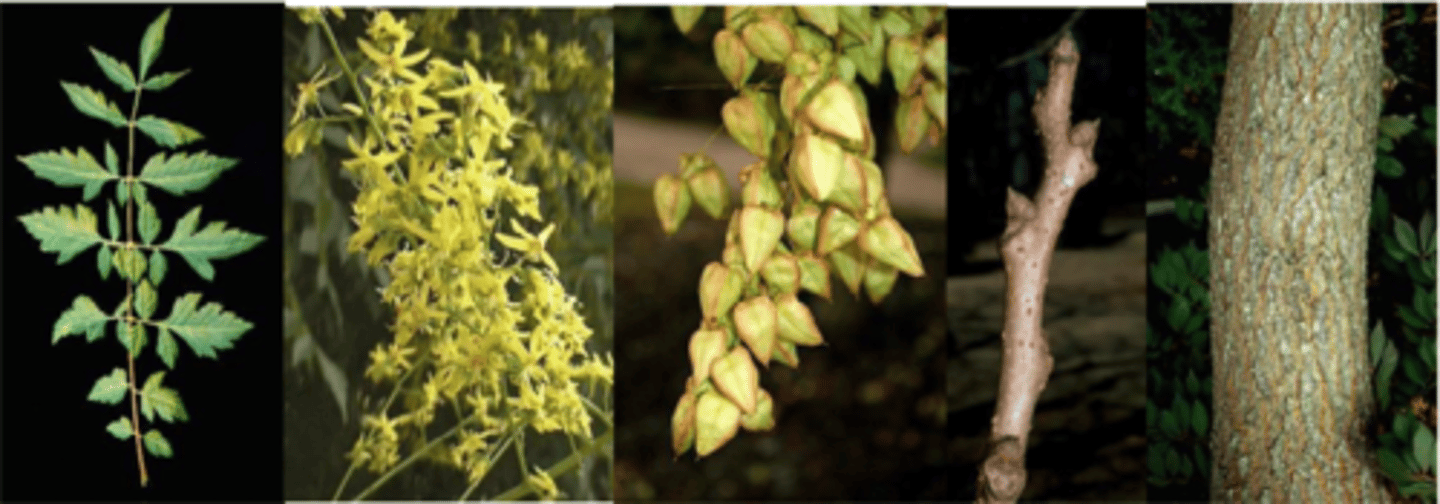
Callery pear
Rosaceae
Pyrus calleryana
Leaves: narrow-oval, 1½ - 3” long (smol), glossy dark green above, repand (wavy) margins; on long petioles that make them flash their slightly paler undersides in a breeze; reddish-purple to bronze-red fall color.
Twigs: glossy brown to reddish brown, medium in texture, spur shoots present; large (1/4 – 1/2” long) terminal buds, ovate, and covered in light brown wooly hairs.
Flowers: white, five-petaled, ¾ - 1” in diameter; produced abundantly in early spring, before the leaves expand fully. Smell putrid like dead fish.
Fruit: small (1/2” diameter), round, brown pome, very bitter small, almost woody, until softened by frost, after which they are readily taken by birds, which disperse the seeds in their droppings.
Form/Silvics: 16 – 26’ tall, often with a conical to rounded crown.

black oak
Fagaceae
Quercus velutina
Leaves: alternate, 4 to 10 inches long, 3 to 7 inches wide; wide or broadest near or above the middle, leathery texture; margin with 5 to 9 lobes, with 1 to 3 bristle-tipped teeth, notches between lobes rounded; upper surface dark green, shiny, smooth lower surface - with smooth or hairy with tufts of hair in the leaf axils
Twigs: stout, reddish-brown, hairy at first, smooth with age
Bud: end buds sharp-pointed, distinctly angled, covered with gray hairs
Trunk: Bark black with deep grooves and flattened, scaly ridges, inner bark mustard yellow to orange
Fruit: nut reddish-brown, striped, 2 to 4 times longer than broad to egg-shaped with a rounded tip; scales light brown, with a tiny fringe of hairs along the edges
Form/Silvics: Medium-sized tree, up to 70 feet tall, with wide spreading open crown and tall, straight trunk. Occurs on rocky, sandy, or dry upland ridges and slopes; also on sandstone, chert, or igneous glades, and borders of woods and fields.
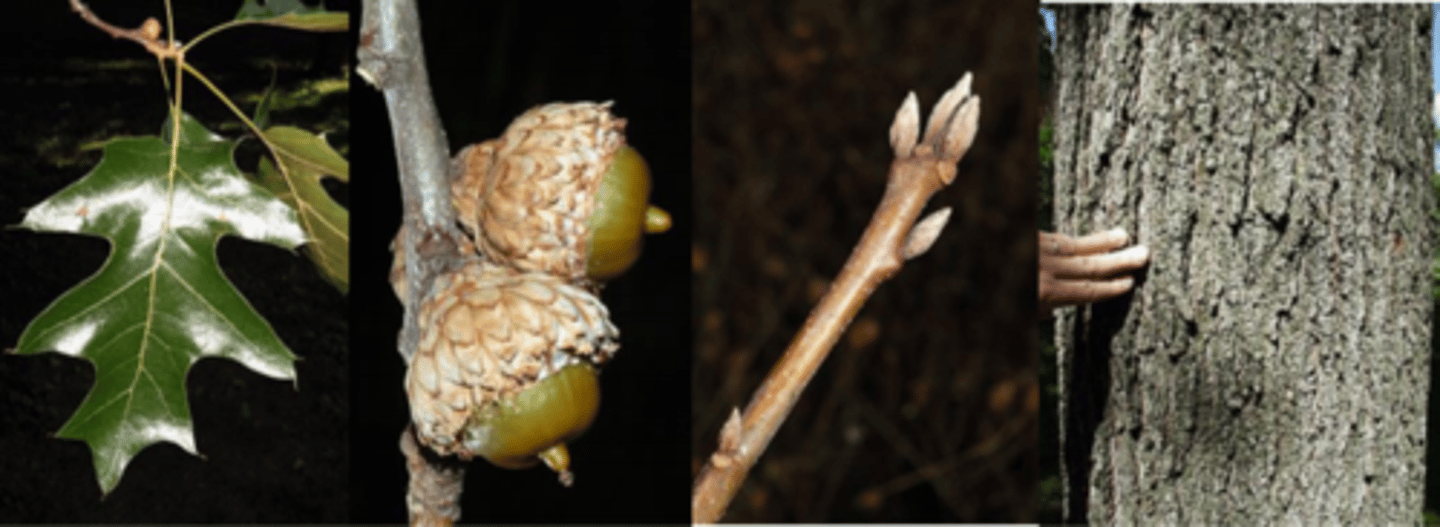
post oak
Fagaceae
Quercus stellata
Leaves: cruciform lobing, very distinctive. 6 in. long w/ 5 lobes. Leaves are thick, leathery above, densely pubescent beneath. Tend to cluster along the tops of the branches (distinct feature!); marcescent in winter.
Twigs: gray and pubescent, especially on new growth.
Buds: blunt, round in cross-section w/ numerous light-brown to reddish-brown imbricate scales.
Fruit: acorns are small .66 in. long, dark brown, normally striped; covered up to 50% by a warty cap.
Bark: similar to white oak w/out large plates. Can be reddish-brown w/ deep fissures.
Form/Silvics: prefers dry, wooded ridges on shallow nutrient-poor soils. Commonly grows with Q. marilandica. Shade intolerant.
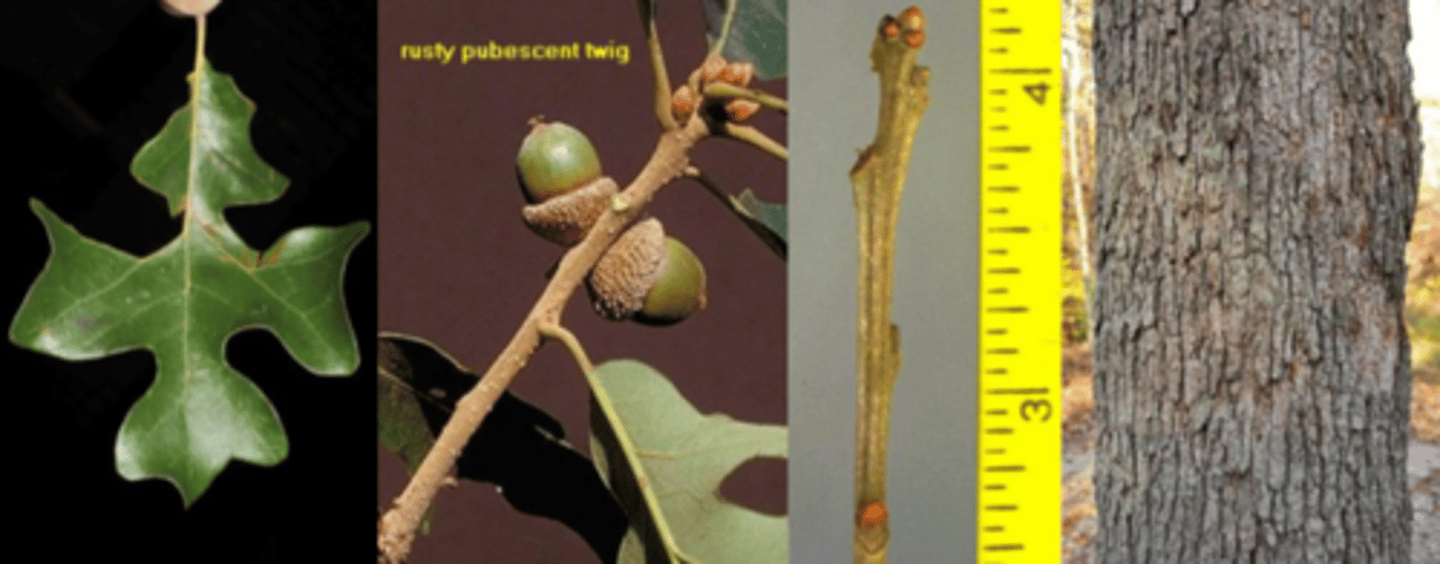
black raspberry
Rosaceae
Rubus occidentalis
Appearance: an arching shrub, the canes attaining a height of 3-7’ with tip-rooting stems
Leaves: alternate; leaflets 3 and sometimes 5; all leaflets broadly ovate to broadly lanceolate; end leaflet on primary canes somewhat smaller than common blackberry, 2¾ - 3¼” long, lower pairs of leaves smaller; surfaces on all leaflets dark green, slightly hairy; lower surface on all leaflets densely white with matted hairs; leaf stalk smooth but bearing short, stout, recurved prickles.
Canes: flexible, smooth, first-year canes with white glaucous bloom that rubs off to reveal light reddish purple color; prickles broad-based and recurved
Fruit: June-July; firm and compact, center hollow and thimble-like; purple-black, aromatic; mostly globe-shaped with a flattened base, about 1/2” across, becoming detached as a unit from the receptacle (hence the hollow center)
Silvics: occurs in open woods, along bluffs and in thickets.
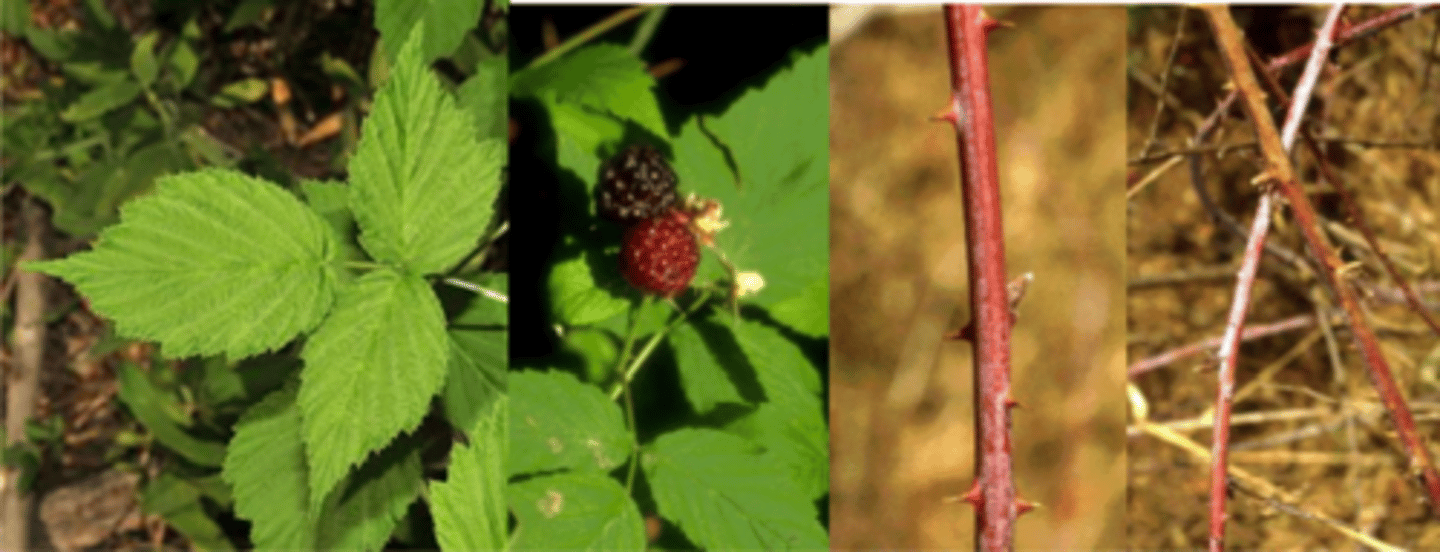
pawpaw
Annonaceae
Asimina triloba
Leaves: alternate, simple, obovate up to 12" w/ entire margins, have a distinctive odor when crushed (green bell pepper).
Twigs: Twig olive-brown, slender, smooth when young.
Buds: Terminal dark brown and soft like worm-on-a-string, feather-like (narrow paint brush); flower buds are rounded.
Fruit: Very distinctive/edible, green, mango/banana shaped, aromatic, preferred food source for several bird species as well as raccoon, opossum, squirrels.
Form/Silvics: Large shrub to small tree up to 30', slender, smooth trunk, broad crown, grows in colonies. Occurs in dense shade on moist lower slopes, ravines, valleys, along streams and at base of wooded bluffs.

shagbark hickory
Juglandaceae
Carya ovata
Leaves: alternate; pinnately compound; 8-14” long with 5 (sometimes 7) leaflets; lateral leaflets are obovate to lanceolate, terminal leaflets are much larger than the laterals; margins serrate and ciliate; rachis stout and mostly glabrous; green above and paler below.
Twig: stout and usually tomentose, but may be somewhat pubescent near terminal bud, numerous lighter lenticels; leaf scars are raised, 3-lobed to semicircular - best described as a "monkey face".
Buds: terminal bud is large, tan, and super soft/pubescent, covered with 3-4 brown scales, more elongated than other hickories.
Fruit: Nearly round, 1½ - 2”, with a very thick husk; nut is distinctly 4-ribbed, and the seed is sweet and delicious; maturing in fall.
Bark: At first smooth and gray, later broken into long, wide plates attached at the middle, curving away from the trunk resulting in a coarsely shaggy appearance.
Form/Silvics: A tall tree reaching over 120’ tall with a straight trunk and an open round to oblong crown; often found on upland slopes and flatwoods with other hickories and oaks, and sometimes along streams.

yellow buckeye
Sapindaceae
Aesculus flava
Leaves: Larger than A. glabra with long petiole, yellow-green above, hairy beneath, leaflet margins finely serrated
Twigs: Large terminal buds, orange-brown in color. Buds more tight and angled than and do not smell like A. glabra. Twigs are tan brown
Fruit: Round; leathery held in smooth capsule that splits into three sections
Bark: light tan, tends to be smoother than Ohio buckeye, can be spongey
Form/Silvics: Prefers moist, rich, high slopes. Appalachian tree species, not native to Missouri. Usually found along streams on unglaciated soils. Shade tolerant. Larger than Ohio buckeye
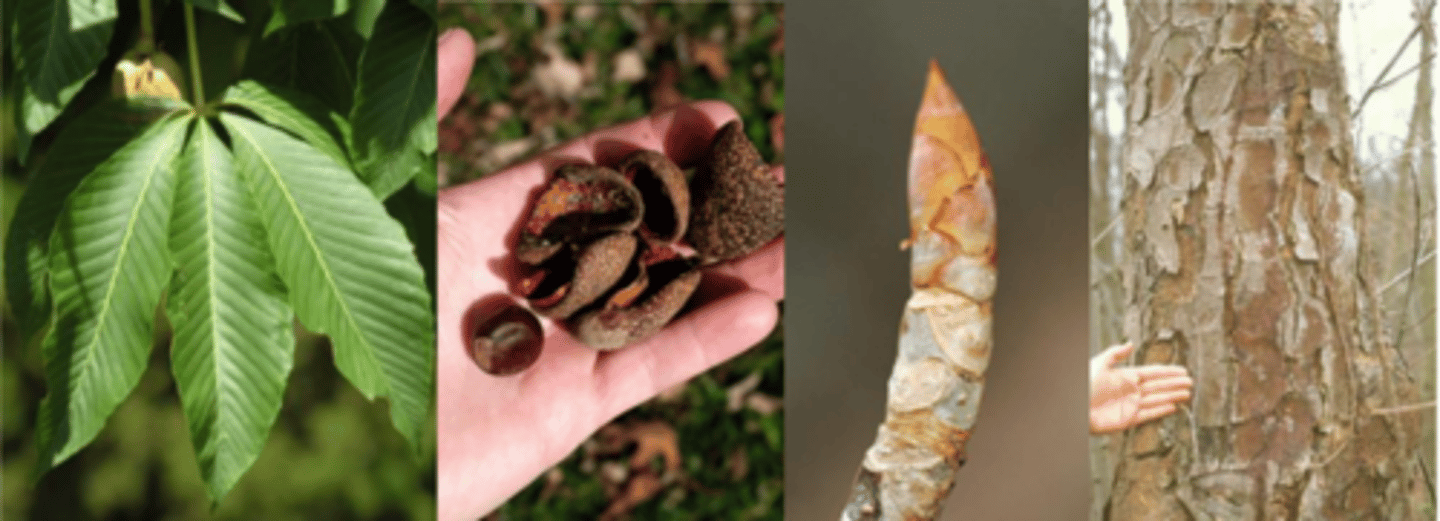
cucumbertree
Magnoliaceae
Magnolia acuminata
Leaf: alternate, simple, elliptical to ovate, 10" long, half as wide, acuminate at tip (hence the name), rounded/acute at base, hairy beneath, not glossy like grandiflora, lighter green, w/ more prominent veins. Leaf scars are large, horseshoe-shaped.
Twigs: stout, have a spicy odor.
Buds: terminal buds are large (1/2-3/4"), slightly crooked whitish, yellow-green w/ silky pubescence. Covered by a single "keeled" scale which leaves a white stipule scar encircling the stem. Lateral buds appressed to twig.
Flowers: perfect, self-sterile, greenish petals 2-3" long June not showy, slightly fragrant.
Fruit: aggregate of pinkish- red follicles, 2-3", maturing in October (looks like a small cucumber);
Form/Silvics: mature size 80-90' tall, 36-48" dbh. Straight, clear, slightly buttressed bole. Pyramidal crown. Bark has thin, blocky striations. Usually found on moist, fertile soils of loose texture with other hardwoods.
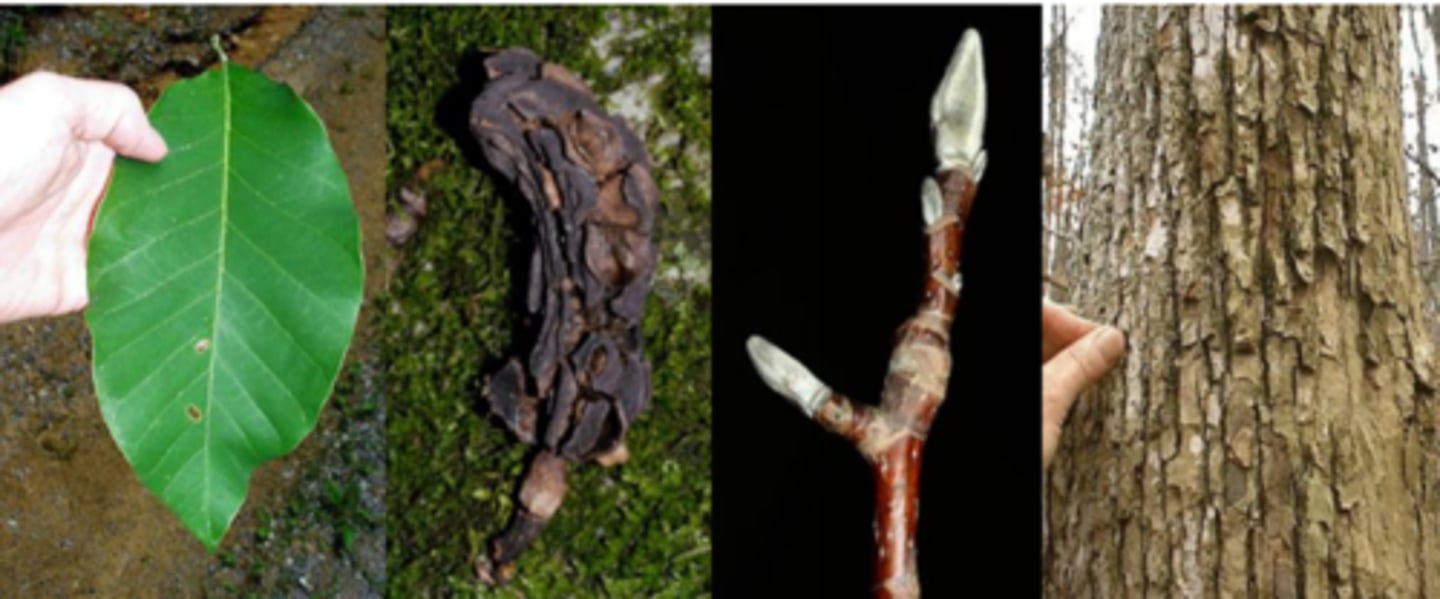
northern catalpa
Bignoniaceae
Catalpa speciosa
Leaves: whorled (only tree in the Midwest with whorled arrangement), cordate leaf shape up to 12” long, margins are entire; densely pubescent beneath. Petiole up to 6 in. long.
Twigs: stout, round w/ crater-like leaf scars. Buds: not obvious.
Fruit: capsule green turning brown 8-20" long, ½” in diameter (like long green bean), persist into winter.
Bark: reddish brown, thick with thick scales.
Form/Silvics: broad upright growth habit, 40-60” tall, 24” dbh. Moisture-loving species found on alluvial floodplains to the base of bluffs. Shade intolerant w/ large, spectacular white flower clusters in midsummer.
Looks like: southern ____________ - royal paulownia - dragon tree - tungoil tree

Osage-orange
Moraceae
Maclura pomifera
Leaves: Alternate, simple, pinnately veined, 2-5” long, oblong to ovate with an acuminate tip, margins entire, upper surface shiny.
Flower: Species is dioecious; females are borne in dense, round, clusters; males borne in subglobose racemes; neither showy, appearing late spring to early summer.
Fruit: A large, round multiple of drupes 4-5” in diameter, with a very distinctive citrus smell; the outer surface looks like "brains"; when crushed, a white, milky juice is exuded, maturing in early fall.
Twig: Moderately slender, zigzag, green changing to buff or orange-brown. Twigs are armed with stout, unbranched thorns at each leaf scar. A milky sap is exuded when cut.
Bark: Orange-brown, developing scaly ridges with irregular furrows.
Wood: Bright yellow-orange; yields a yellow dye when boiled in water. Also used for bows, hence the name “bois d’arc” or bowwood.
Form: A medium sized tree with a short trunk. The crown is irregular, with stiff, spiny branches. Campus trees shaped like coral.
Looks like: red mulberry - white mulberry - gum bumelia
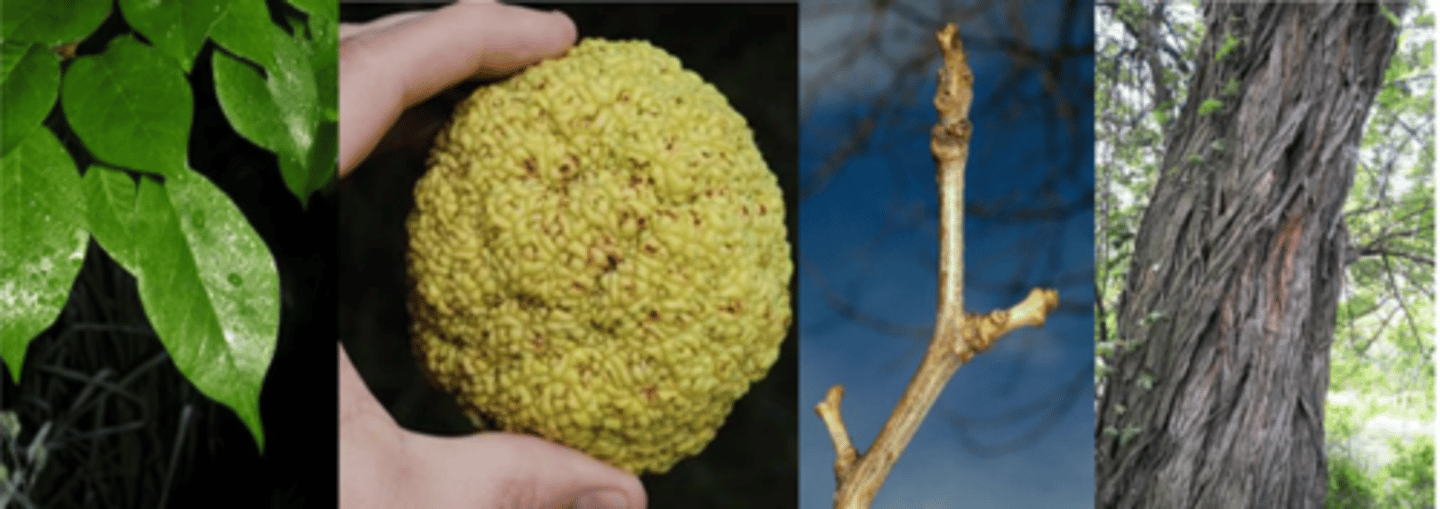
tulip-poplar, yellow-poplar
Magnoliaceae
Liriodendron tulipifera
Leaves: alternate, simple, 3-8" long/wide; broad truncate apex (at base and leaf tip) with short acuminate lobe on each side, rounded or truncate base (like hippo foot); pale beneath, petiole 2-4". Good yellow fall color.
Twigs: aromatic when crushed (smells sweet)/tastes very bitter; has distinct stipule scars surrounding the entire stem circumference at nodes; pith is chambered.
Buds: valvate buds (like a duck's bill), covered with bloom, green-brownish
Flowers: perfect w/ 6 greenish yellow petals in 2 rows, reflexed sepals, interior of corolla orange May to June (look like a tulip); beautiful.
Fruit: aggregate of samaras, persistent in winter. Good ID feature in winter. Winter food source for foraging birds, squirrels.
Bark: gray w/ interlacing, dark furrows separated by flattened gray ridges.
Form/Silvics: Mature size, 70-90' tall. Prefers deep, well drained, moist, slightly acid loam soils.

honeylocust
Fabaceae
Gleditsia triacanthos
Leaves: alternate, pinnately compound, 5-8" long, with 15 to 30 tiny leaflets or bi-pinnately compound with 4 to 7 pairs of minor leaflets. Leaflets are 1/2 to 1 1/2 inches long, ovate to elliptical in shape, green to yellow-green.
Twigs: May be either stout or slender, prominently zig-zag, red-brown to light brown in color, numerous lenticels and 3-branched thorns.
Buds: lateral buds are very small and sunken.
Flower: Small, greenish yellow, displayed on 2-3" long narrow, hanging clusters, not showy, but very fragrant, appearing in late spring and early summer.
Fruit: A very distinctive, 6-8" long, flattened, red-brown, leathery pod that becomes dry and twisted; pod contains many oval, dark brown, shiny seeds, 1/3" long, maturing in late summer and early fall.
Bark: Initially, gray-brown to bronze, and smooth with many horizontal lenticels, later breaking into long, narrow, curling plates. Often displaying clusters of large, branched thorns on trunk.
Form/Silvics: medium size tree with a typically short bole and an airy, spreading crown, reaches up to 80' tall. Commonly found on rich, moist bottomlands or limestone soils.
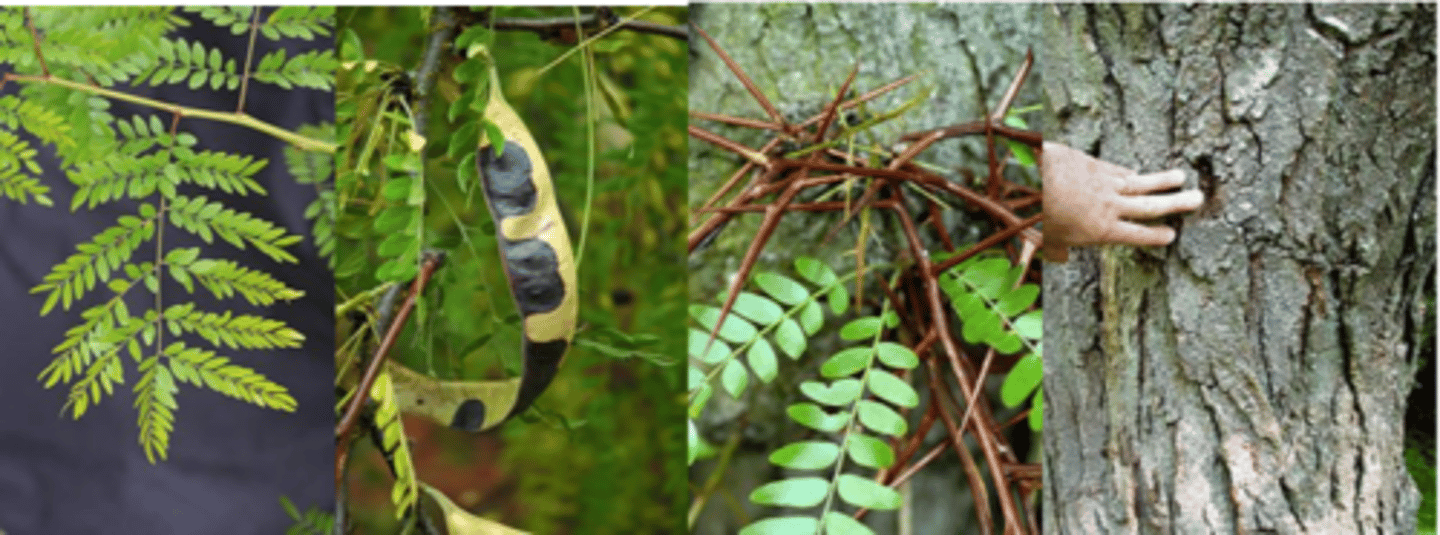
black maple
Sapindaceae
Acer nigrum
Leaves: opposite; simple, mostly three-lobed, closely resembles sugar maple; but, leaf blades are thicker than sugar maple w/ drooping sides; stipule-like leaflets at base of petiole; lower surface is downy.
Twigs: stouter than sugar maple; mottled gray-brown; conspicuously, warty lenticels.
Buds: nearly black, hoary pubescent, sharp-pointed. in 1s or 3s
Fruit: double samara with a slightly larger seed cavity compared to sugar.
Bark: like sugar maple, but more corrugated (hard to distinguish from sugar w/out leaves).
Form/Silvics: similar to sugar, but black tends to grow on the moister soils of streams and river bottoms, and perhaps more tolerant of hotter/drier conditions.

blue ash
Oleaceae
Fraxinus quadrangulata
Leaves: opposite, pinnately compound, 7-14” long with mostly w/ 9 leaflets, acuminate tip, base is broadly cuneate (=wedge shaped w/ straight sides) base which is unequal (like elms).
Twigs: stout, 4-angled w/ square, corky wings (like Euonymous alatus).
Buds: terminal bud are more elongate than other ashes.
Fruit: samara shaped like “canoe paddles”.
Bark: light gray, scaly plates NOT in ridges and furrows as in white ash; turns blue when injured (oxidizes).
Form/Silvics: Missouri native. Tolerates high pH, dry sites; often found on dry, rocky limestone ridges, normally a scattered tree in the landscape. Mature Size: 50-70ft.
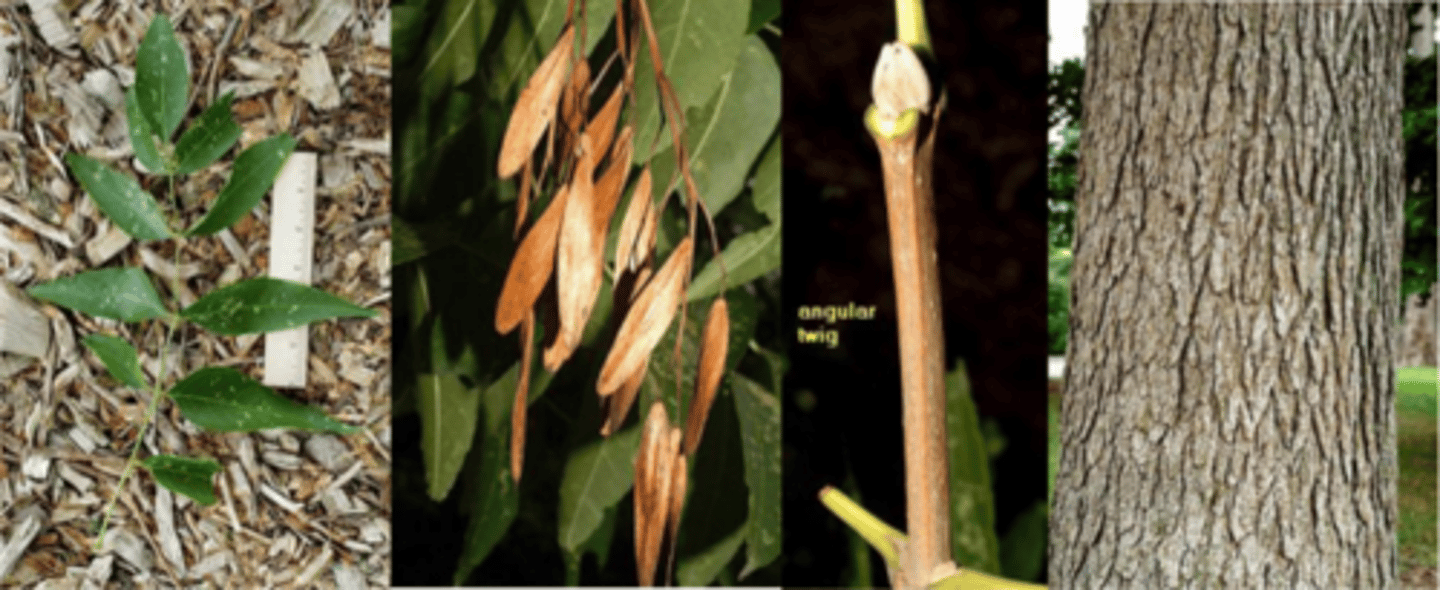
smooth sumac
Anacardiaceae
Rhus glabra
Leaves: alternate, featherlike arrangement; pinnately compound, 12-16” long; rachis smooth and lacking wings (as opposed to winged sumac); 15-23 leaflets, longest leaflets near middle of leaf; leaflets longer than broad to lanceolate; tip pointed, base rounded; margin coarsely serrate; upper surface dark green, shiny; lower surface lighter to conspicuously white; broken leaves and rachis exude a sticky, milky sap. Red leaves in the fall.
Fruit: August-September, compact clusters, erect, persistent; fruit globe-shaped, about 1/8” in diameter; dark red with red, velvety hairs.
Twigs: rigid, smooth, with white glaucous bloom; reddish brown to purplish; broken twigs exude white, milky sap; part of season’s twig-growth dies back during winter. Teeny tiny golden, fuzzy globose buds.
Form/Silvics: occurs in upland prairies, thickets, idle fields, borders and openings of woods, roadsides and along railroads.
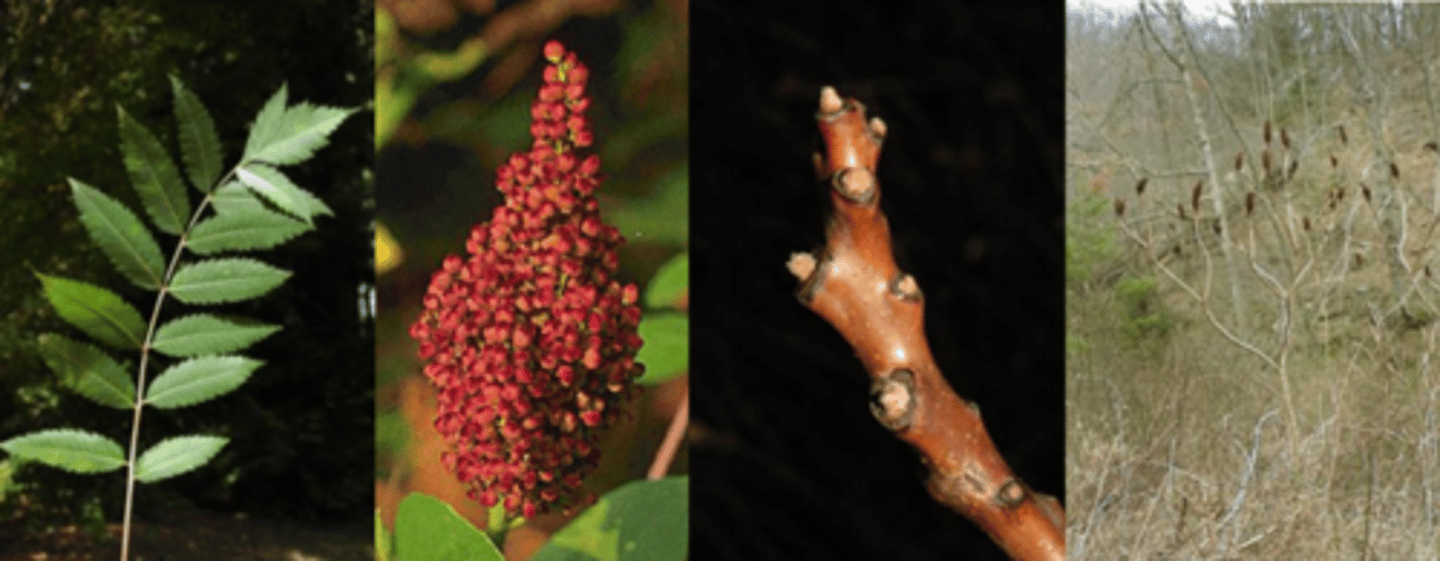
multiflora rose
Rosaceae
Rosa multiflora
Leaves: Alternate, pinnately compound leaf, 3-5” long, 5 to 11 serrated leaflets, comb-like stipules along base of petiole, dark green above and paler below.
Flower: White, 5 wedge-shaped petals, 2” across, occurring in clusters, fragrant, appearing in early summer.
Fruit: Red to reddish brown, 1/4 inch, oblong, fleshy "hip", ripens in late summer and persist through the winter.
Twig: Green or greenish-red, usually with paired, curved prickles, long and arching stems; buds red, pointed.
Bark: Brown, finely shreddy at base.
Form/Silvics: Sprawling arching stems which form a large round crown and dense thickets; individual stems often reaching high into the air when supported.
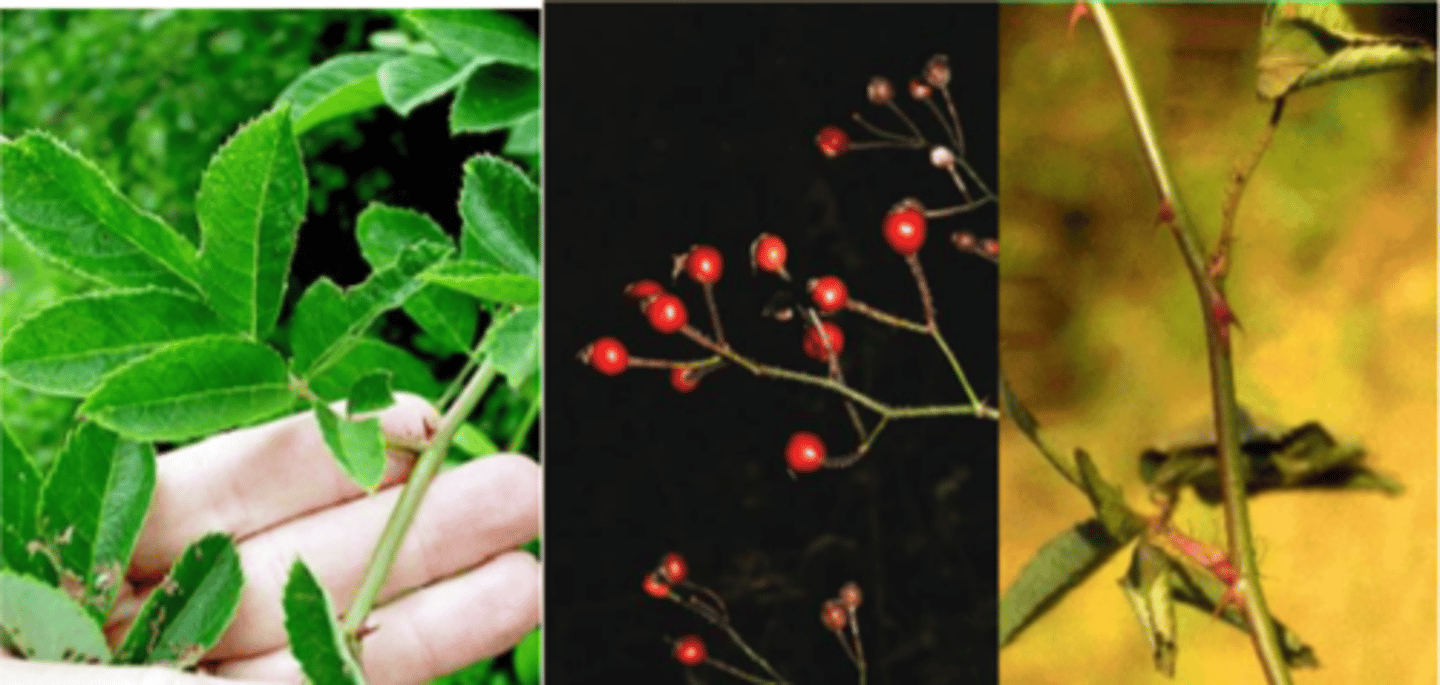
common blackberry
Rosaceae
Rubus allegheniensis
Appearance: erect shrub, the branches occasionally to 8’ and arching high being supported by surrounding trees or shrubs
Leaves: alternate; thick and often wrinkled; leaflets on flower canes 3, on primary canes 5; end leaflet on primary canes 3¼- 5” long, or 2-3 times longer than broad; the lower pairs smaller, ovate to obovate and tapering at both ends; margins sharply serrate; upper surface dark, dull green, smooth; lower surface paler, pubescent; leaflets on flower canes smaller.
Canes: primary green to reddish; ribbed (angled); numerous prickles, straight or recurved; flower canes are brown and ribbed.
Fruit: June-August; fruit stalks ½ - 1” long; deep violet to black, glossy, juicy, sweet globe- or cylinder-shaped, about ¾” long.
Silvics: occurs in open woods. Along bluffs, thickets and open valleys
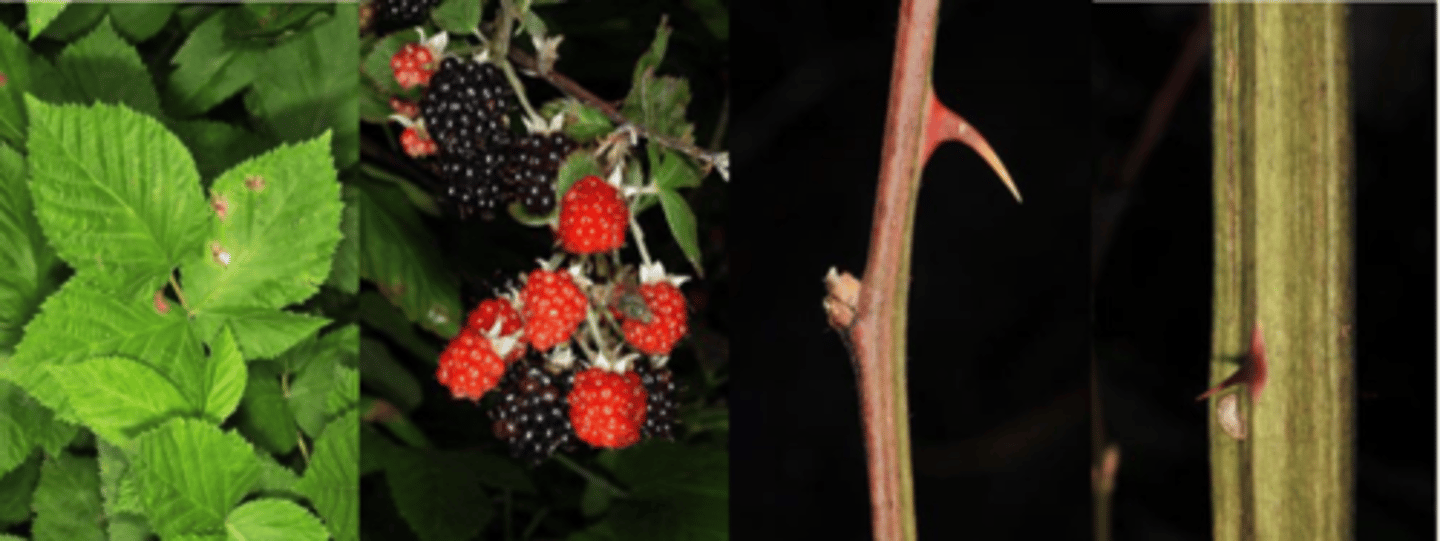
eastern wahoo
Celastraceae
Euonymus atropurpureus
Leaves: opposite, simple, 2-5 in. long, oblong-ovate w/ sharp point, serrulate. Can be pubescent beneath, always glabrous above.
Twigs: green/reddish-green; on fast growing twigs, can develop ridges like most Euonymus species.
Buds: terminals sharply pointed, ovoid with loose-fitting scales (sometimes).
Fruit: very distinctive obvious; bright pink capsules split to reveal orange-red arils (like Magnolia). Persist into late fall.
Form/Silvics: shrub/small tree up to 25’. Very adaptable prefers full sun; can display beautiful red fall color. Species name refers to dark purple flowers.

roughleaf dogwood
Cornaceae
Cornus drummondii
Leaves: simple, opposite, margins entire, arcuate-veined., tip acuminate, base rounded to wedge shaped. Rough-hairy above, wooly with loosely curled hairs below (common name). V-shaped leaf scars.
Twigs: w/ hairs, slender, reddish first year turning gray-green.
Fruit: distinctive white berries, ¼” August-October, borne on bright red-orange, hairy pedicels. Very hardy shrub/small tree.
Bark: gray, scaly. Inner bark is dark reddish brown.
Form/Silvics: large, shrubby, native dogwood, up to 12-15’. Common along streams, roadsides; shade tolerant. Can spread by suckers and create thickets.
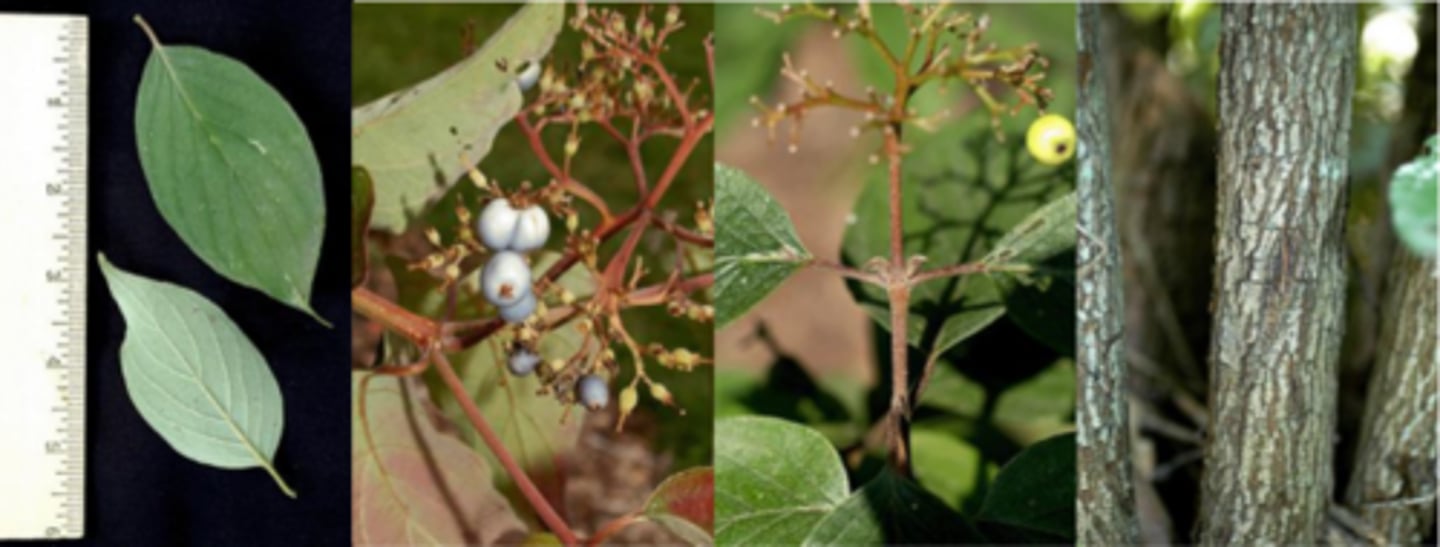
black locust
Fabaceae
Robinia pseudoacacia
Leaves: alternate, pinnately compound up to 12 in. long w/ 7-19 ovate leaflets per leaf. Leaflets are bluish-green w/ entire (not serrated) margins.
Twigs: moderately stout, zig-zag, smooth, brown; pairs of thick/sharp short, unbranched spines at most nodes, mainly on smaller twigs; spines may not be noticeable on slow-growing trees.
Buds: terminal bud lacking; lateral buds are small, usually not noticeable (sunken)
Flower: perfect white flowers appear in drooping clusters in early May, just at leaf out. Fragrant, very showy.
Fruit: flat, 4”-long, oblong pods, often persists during the winter.
Bark: tan, fibrous, thick w/ deep fissures; orange inner-bark.
Form/Silvics: A ubiquitous tree species; can be invasive.
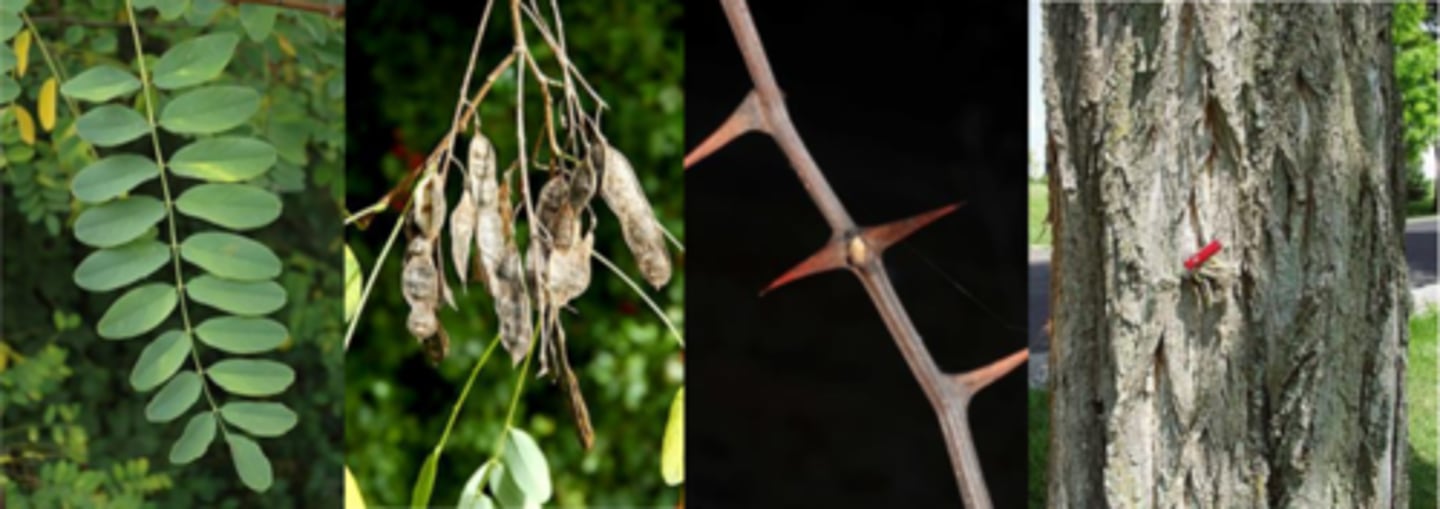
bitternut hickory
Juglandaceae
Carya cordiformis
Leaves: alternate; 6-10” long; pinnately compound w/ 7-11 leaflets; narrower than C. glabra; upper surface bright green.
Twigs: slender compared to other hickories; more or less pubescent; lenticellate.
Buds: terminal buds 1/3-3/4” long; cylindrical or somewhat 4-angled, valvate, sulfur-yellow and scurfy pubescent; lateral buds smaller, often short-stalked, divergent.
Fruit: ¾-1¼” long; thin husk and 4-winged above the middle, nut shell smooth; meat bitter tasting.
Bark: close, firm, and tight for many years; eventually in low, narrow ridges in an interlacing pattern, gray colored to mottled gray-brown and scaly on older trees.
Form/Silvics: medium size tree, 60-80’ tall, 12-24” dbh; chiefly associated with other hickories and oaks; found on many soil types from dry, gravelly uplands to rich, moist bottomlands

sassafras
Lauraceae
Sassafras albidum
Leaves: alternate; simple, 3-6” long; ovate to elliptical; pinnately veined and variably lobed; entire; green above and below and fragrant when crushed (Froot Loops);
Twig: slender, green and sometimes pubescent, with a spicy-sweet aroma when broken;
Buds: ¼” long and green (soft globe); twigs from young plants displayed at a uniform 60 degree angle from main stem.
Flower: dioecious; small but quite showy, both male and females are bright yellow-green, borne in 2 inch racemes appearing in early to mid-spring.
Fruit: dark shiny blue, ovoid, fleshy drupes, 1/3” long, that are borne in a red cup attached to a red stalks, held upright, maturing late summer.
Bark: brown, with cinnamon-brown inner bark, becoming coarsely ridged and furrowed; when cut the spicy aroma is obvious.
Form/Silvics: intolerant; pioneer species;; best growth on moist, well-drained, sandy soils; can also be found on disturbed sites and in dry to mesic forests, clearings, fence rows, and old fields; small to medium sized tree up to 60’ tall with an irregular often twisted trunk and main branches, usually flattopped crown; root suckering may result in thickets.
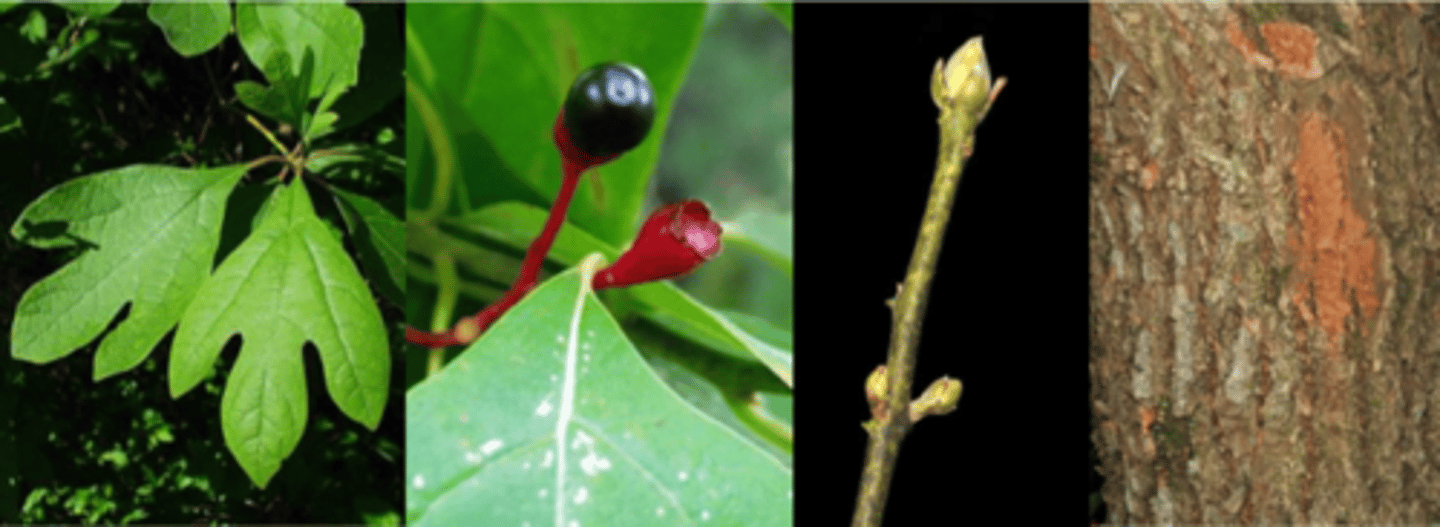
red mulberry
Moraceae
Morus rubra
Leaves: Alternate, simple, broadest at the base or middle; polymorphic (mostly entire) shaped leaves (entire to deeply lobed 1-3 lobes), dark green, scabrous. Densely toothed, tip pointed; with 3 principal veins emerging from the base; upper surface smooth; lower surface paler, hairy; excluding milky juice when cut
Twigs: Twigs tannish-brown, round, smooth w/ milky sap in summer.
Buds: brown, ovoid (plump) w/ 4-8 imbricate scales; bud scales two-toned green/brown.
Fruit: purple fleshy berry, 1.5” long, ripen in June-July. Known to be eaten by at least 21 species of birds, including wild turkey, squirrels, mice, and raccoons
Bark: bark thin, dark brown to gray with an orange tint, grooves shallow, ridges narrow, tight or occasionally with loose scales
Form/Silvics: Native to U.S. but less common than white mulberry; a woodland species, not weedy/invasive like white mulberry. Medium sized tree up to 60 feet tall, short trunk and broad, rounded crown. Different than white mulberry: M. alba has similar leaves which are smooth & shiny and yellowish green, raised leaf scars that are half-moon shaped with numerous bundle scars; M. alba bud scales are striped, broad at the base and pointed at the tip. Occurs in moist woods in lowland areas or on moist upland slopes
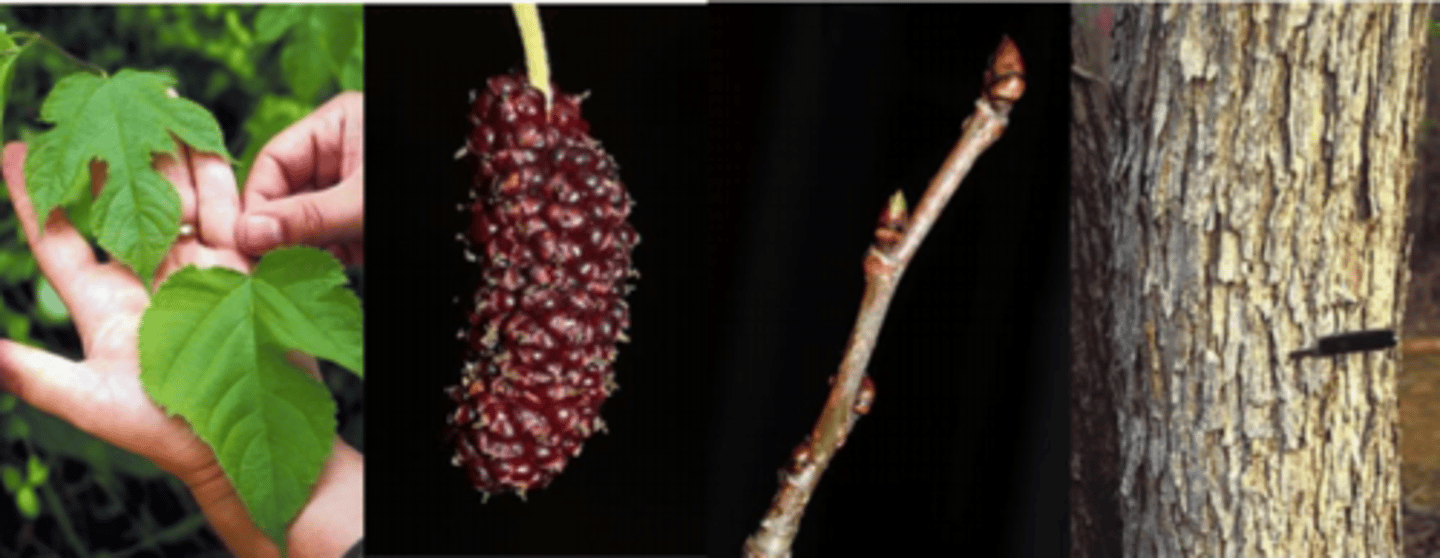
eastern cottonwood
Salicaceae
Populus deltoides
Leaves: alternate; simple; 3-7” long, 3-5” wide; deltate to ovate-deltate; margin crenate-serrate, teeth glandular; apex acuminate; base truncate to slightly cordate; lustrous green above, somewhat paler and glabrous below; petiole flattened (leaves appear to shimmer in the wind)
Twigs: stout, angular, yellowish brown; glabrous
Buds: ~3/4” long, narrowly ellipsoidal; lustrous brown; resinous; covered by 6-7 imbricate scales; lateral buds smaller, divergent
Fruit: dioecious; capsule releasing cottony, tufted seeds in summer (can be a weed problem); male clones and hybrids with P. nigra are "cottonless".
Bark: with very deep fissures.
Form/Silvics: tolerates dry conditions but does best in riparian, moist sites along streams or rivers. Can tolerate a wide range of site conditions. Mature size 75-100'.

Virginia creeper
Vitaceae
Parthenocissus quinquefolia
Leaves: alternate, palmately compound, 4-8” across, with five elliptical leaflets per leaf; coarsely crenate to serrate margins; shiny green above and paler below.
Flower: Small, not showy, green and borne in clusters on long stems, appear in summer.
Fruit: blue-black berry, ¼“ in diameter, borne in long-stemmed clusters, maturing in late summer.
Twigs: new stems are slender, light brown in color, with numerous reddish lenticels, tendrils are apparent opposite the buds, ending in adhesive pads;
Buds: broadly conical with orange-brown scales; leaf scars are nearly round and concave.
Bark: gray-brown, becoming coarsely hairy due to aerial roots and tendrils. When rapidly growing, the aerial roots are bright, orange-brown.
Form/Silvics: a climbing vine that may provide ground cover or ascend to fifty feet. Stems may get several inches in diameter

Norway maple
Sapindaceae
Acer platanoides
Leaves: opposite, simple, 5 lobes (but also with tiny extra pair at base), sharp pointed, slightly dentate, 4” petiole with milky sap when crushed, may have good yellow fall color. May be confused with sugar maple, but this one has more lobes, truncate at the bottom.
Twigs: Twigs stout, reddish.
Buds: initially lustrous green, turning red, scales keeled.
Fruit: winged seed in pairs, wings very wide-spreading.
Bark: Smooth on young trees, becoming closely fissured; dark-colored.
Form/Silvics: Mature size 40-50’. Shallow roots limit turf. needs room; Can be invasive in cooler, wetter climates; but, not in Missouri.
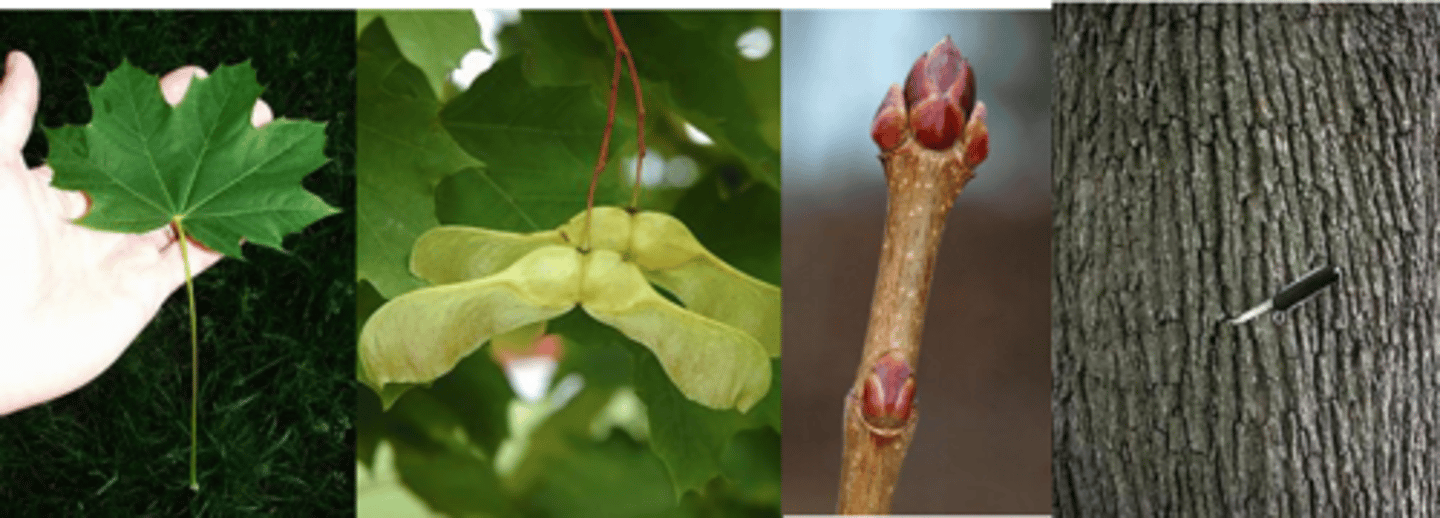
pitch x lob hybrid
Pinaceae
Pinus rigida x taeda
Leaves: Evergreen needles, 4 to 6 inches long, with three somewhat twisted needles per fascicle, yellow-green to green.
Fruit: Cones are ovoid, 3 - 5" long, light brown in color; umbo is armed with a short, stout prickle; maturing in fall.
Twig: Orange-brown and moderately stout; buds narrowly ovoid, light gray-brown.
Bark: Dark and scaly when young, developing red-brown or yellow-brown thick flat plates with deep furrows; sprouts of needles may be present.
Form: Extremely variable; short and poorly formed on poor sites, but can be a straight, medium sized tree reaching 80' tall on better sites; epicormic sprouting can be seen.

fragrant sumac Anacardiaceae Rhus aromatica
Leaves: alternate, trifoliate, 3-5” long, leaflets sub-sessile (almost no petiole), ovate, coarsely toothed, pubescent beneath; fragrant odor when crushed (like cleaning products).
Twigs: slender, brown, pubescent, aromatic;
Buds: small, yellowish-brown, covered by leaf scar. (like tiny pineapples)
Fruit: on female red, hairy drupe 1/4". Good orange to red fall color; foliage has a pleasing odor when crushed.
Bark: gray-brown and tight; initially smooth with obvious lenticels
Form/Silvics: mature size 2-4’ tall. Often small bush.

Japanese zelkova
Ulmaceae
Zelkova serrata
Leaves: alternate, simple, ovate with an acuminate tip, 1½ - 2½” long, pinnately veined, serrate with rounded over teeth; leaves are dark green above and much paler below.
Flower: monoecious; yellow-green, not showy, occur in tight clusters along new stems; appearing before the leaves.
Fruit: a small triangular drupe, 1/6 inch long, green and later turning brown, maturing in mid to late summer.
Twig: very slender, zigzag, red-brown in color; buds are reddish brown, cone-shaped, pointed, and widely divergent.
Bark: smooth and red-brown to gray when young with numerous lenticels; remains smooth for many years but eventually exfoliates into small patches, reddish brown in color.
Form/Silvics: a small to medium size tree to 80 feet; low branching vase-shaped tree with very tight branch angles. This appearance is maintained when very young and when very old.

trumpet creeper
Bignoniaceae
Campsis radicans
Leaves: Opposite, pinnately compound, 5-13” long, 7-11 coarsely serrated leaflets, individual leaflets 1- 3” long, shiny dark green above.
Flower: Very attractive, 2-3” long tubular, orange to red flowers, in clusters, appearing in late summer.
Fruit: Dry pod 3-6” long, 1 inch wide, each containing large numbers of winged seeds, ripens in early fall.
Twig: Light brown, solid pith, glabrous, leaf scar sunken, small buds, aerial roots in rows.
Bark: Large vines will develop pale brown scaly bark.
Form: Scrambling, climbing vine that develops tangles along fencerows and shrubs. It can climb quite high. Looks like Japanese wisteria

blackhaw
Caprifoliaceae
Viburnum prunifolium
Leaves: opposite, simple, 1-3” long, broad-elliptical to ovate, acute or obtuse, rounded to wedge-shaped, narrow at the base), margin serrulate (similar to cherry leaf), pinnately veined, shiny dark green above.
Twigs: moderately stout and stiff-looking; reddish brown; numerous opposite, short twigs give appearance of a fish skeleton.
Buds: valvate, narrowly ovate; LAVENDER, longer, pointed; leathery looking.
Fruit: glaucous, dark blue, oval drupe to 1/2 ", goes through different color changes as it ripens; shriveled, raisin-like fruit persists through winter
Bark: gray-brown and breaking up into small, square plates like alligator hide
Form/Silvics: mature size 12-15' tall with a twisted and stiff trunk. Occurs in low woods along streams near base of bluffs as well as dry, upper slopes. Found throughout Missouri. Usually multi-stemmed
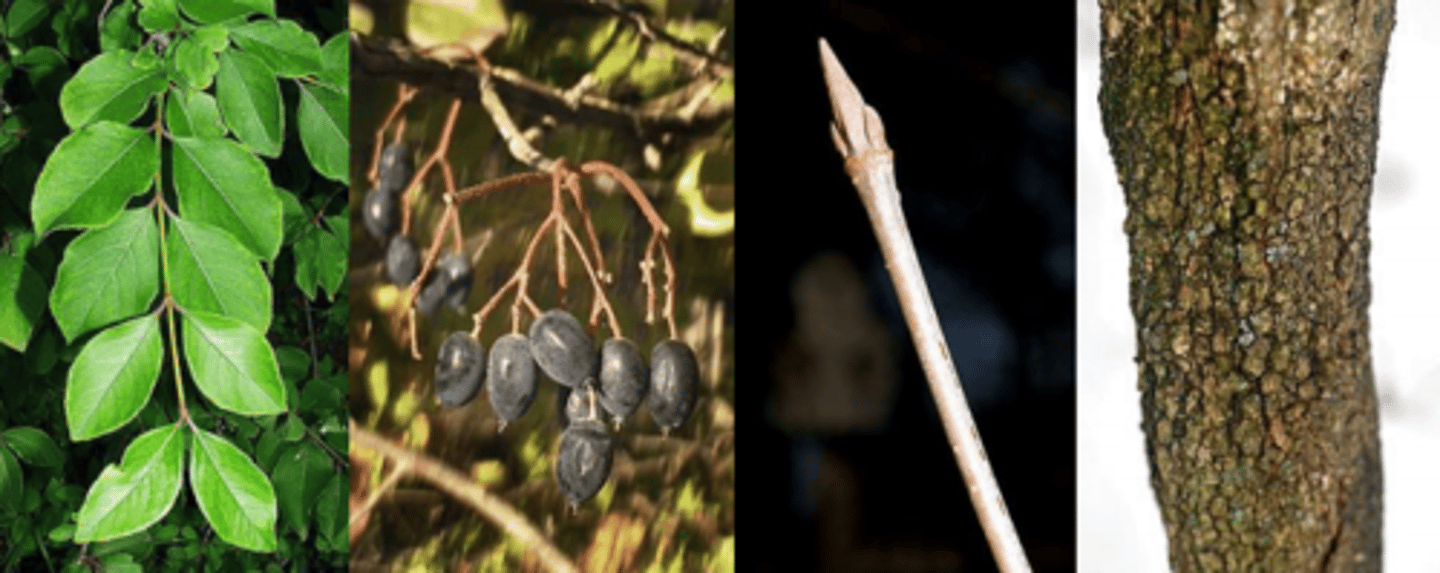
American bladdernut
Staphyleaceae
Staphylea trifolia
Leaves: opposite; pinnately compound with three (rarely 5) ovate or obovate leaflets that are 2-4” inches long; serrate margins.
Twig: slender, green to brown in color, with a large white pith; buds are in pairs of brown, 4-scaled, ovoid/globose and may be stalked.
Flower: Green-white, bell-shaped and small, borne on dangling 2 inch long panicles in spring.
Fruit: a very unique 1½”, 3-lobed, papery capsule that looks inflated. The inflated bag contains several hard, small brown seeds, maturing in September.
Bark: green-gray in color with white furrows.
Form/Silvics: large shrub or small tree that is heavily branched and suckers readily, forming a thicket.

bush honeysuckle
Caprifoliaceae
Lonicera maackii
Leaves: Opposite, simple, ovate, 2”-3” long, entire margin, acuminate tip; green above, paler and slightly fuzzy below.
Flower: Species is monoecious; white changing to yellow, ¾”-1” long, 4 upper petal lobes fused, very fragrant, appearing in late spring.
Fruit: Juicy red berry, ¼” in diameter, appearing in late summer often in great abundance, persists into the winter.
Twig: Slender, glabrous, grayish brown, hollow pith but solid brown at the nodes; opposite, small pointed, light brown buds.
Bark: Develops long, deep fissures, somewhat scaly ridges, grayish brown.
Form: An erect shrub, multi-stemmed, branches often arching, up to 20’ tall, 15’ spread. Leafs out in very early spring and will suppress adjacent vegetation with heavy shade. Truly a noxious weed!

Chinese elm
Ulmaceae
Ulmus parvifolia
Leaves: Alternate, simple, elliptical to broadly lanceolate, up to 2½” long, tiny leaves, pinnately veined, serrate margin; base of leaf is conspicuously inequilateral, shiny dark green above and nearly glabrous, paler below.
Flower: Species is monoecious; inconspicuous, light green in small tight clusters, appearing in late summer and early fall.
Fruit: A flattened, winged samara, nearly round but notched at the top, ½” long, light reddish brown, occur in tight clusters in the fall.
Twig: Slender, zigzag, brown, with obvious orange lenticels, maybe slightly pubescent; false terminal bud pushed over slightly to one side, quite small, ovate, reddish brown.
Bark: Very distinctive, even when young. Mottled green, gray and orange, jigsaw-like puzzle pieces separated by red-orange (inner bark). Trunk may become fluted.
Form/Silvics: A small tree reaching up to 70’ tall with a graceful spreading wide crown made up of fine branches. Looks like: Siberian elm, Japanese zelkova

American holly
Aquifoliaceae
Ilex opaca
Leaves: Alternate; evergreen, thick leathery, egg-shaped to widest in the middle. Margin with large, sharp, spine-tipped teeth, tip pointed; upper surface dark green, dull. Lower surface paler green, smooth to somewhat hairy. Short leaf stalk
Twigs: Stout, green to light brown/gray; covered with fine rust-colored hairs when young, smooth later
Trunk: Bark light or dark gray, thin smooth or with small, wart-like projections; woody ivory white to pale brown
Fruit: October. Berry-like, rounded to egg-shaped, bright red, rarely yellow or orange, ¼-½" long, seeds 4.
Flowers: May-June, in short stalked clusters, male and female flowers either on separate trees or both on same tree
Form/Silvics: Small to medium sized evergreen tree. Up to 50 feet tall, with short, crooked branches and a rounded or pyramidal crown. Fruit is considered poisonous. Occurs naturally only in southeastern Missouri on the lower slopes and edges of Crowley's Ridge on sandy-gravelly soils that remain moist from seepage.
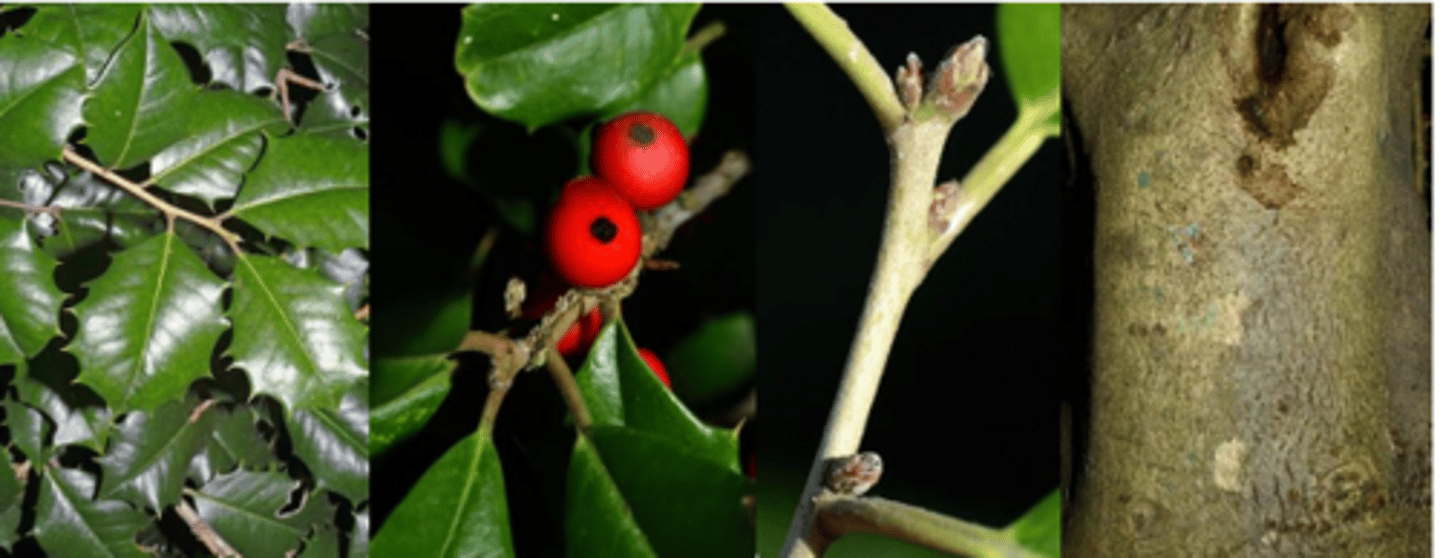
apple
Rosaceae
Malus spp.
Leaves: alternate, simple, elliptical to ovate, 1½ - 3”, pinnately veined, finely serrated, sometimes borne on spur shoots, green above and paler, white pubescent below and on the petiole.
Flowers: perfect, showy, may be white to red in color, with 5 petals for each flower; appear in the spring, usually in umbels.
Fruit: Pomes of various sizes and color (cultivar dependent) ranging from yellow to red when ripe in the fall. Often large and tough.
Twigs: Moderate in thickness, brown to gray, rapid growth usually gray hairy, generally many spur shoots; buds plump ovate, gray hairy.
Bark: Variable, generally smooth when young, later thin and scaly.
Form/Silvics: Generally poor, with twisted trunks and low branching; spur shoots are prominent. When unpruned, numerous sucker shoots form along trunk and in crown. Looks like: Callery pear, common pear, hawthorn

sawtooth oak
Fagaceae
Quercus acutissima
Leaves: Alternate, simple, lanceolate in shape, 3-7” long, pinnately veined with a very sharply serrate margin bearing bristle-tipped teeth. Strongly resembles a Castanea leaf.
Fruit: Acorns are oval in shape. Cap covers 1/2 of nut with scales very prominently reflexed - resembles hair. Among the first acorns to ripen in the fall after two years.
Twig: Quite slender, red to gray-brown in color with multiple terminal buds; buds are gray-brown, pubescent on the bud scale edges and somewhat pyramidal.
Bark: Ridged and furrowed even when young, later deeply ridged and furrowed, somewhat corky.
Form/Silvics: A small to medium size tree that forms a dense pyramidal crown that rounds with age. Looks like: American chestnut, Chinese chestnut, American beech
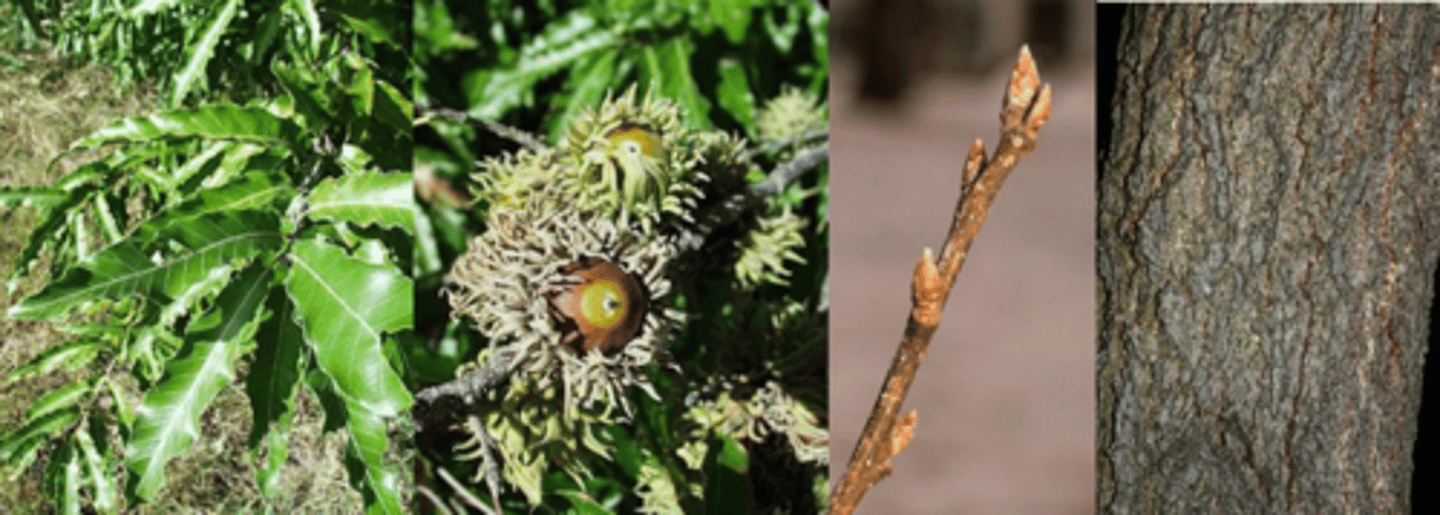
tree-of-heaven
Simaroubaceae
Ailanthus altissima
Leaves: alternate, pinnately compound, 18-24" 11-41 leaflets, lanceolate/ovate, truncate at base, ciliate, 2-4 coarse teeth near base. Stems and leaves rank smelling when bruised
Twigs: thick, medium brown w/ brown pith. Large, shield-shaped or heart-shaped leaf scars. Flat, red terminal bud.
Flower: dioecious or monoecious yellow green in 12" panicles, arise in June. Male with vile odor.
Fruit: samara tapering both ends, twisted, yellow orange.
Bark: mostly smooth, thin, medium gray in color, inner bark is tan colored.
Form/Silvics: medium-sized tree up to 60 feet tall; stout branches to form a open, very wide crown. Invasive.
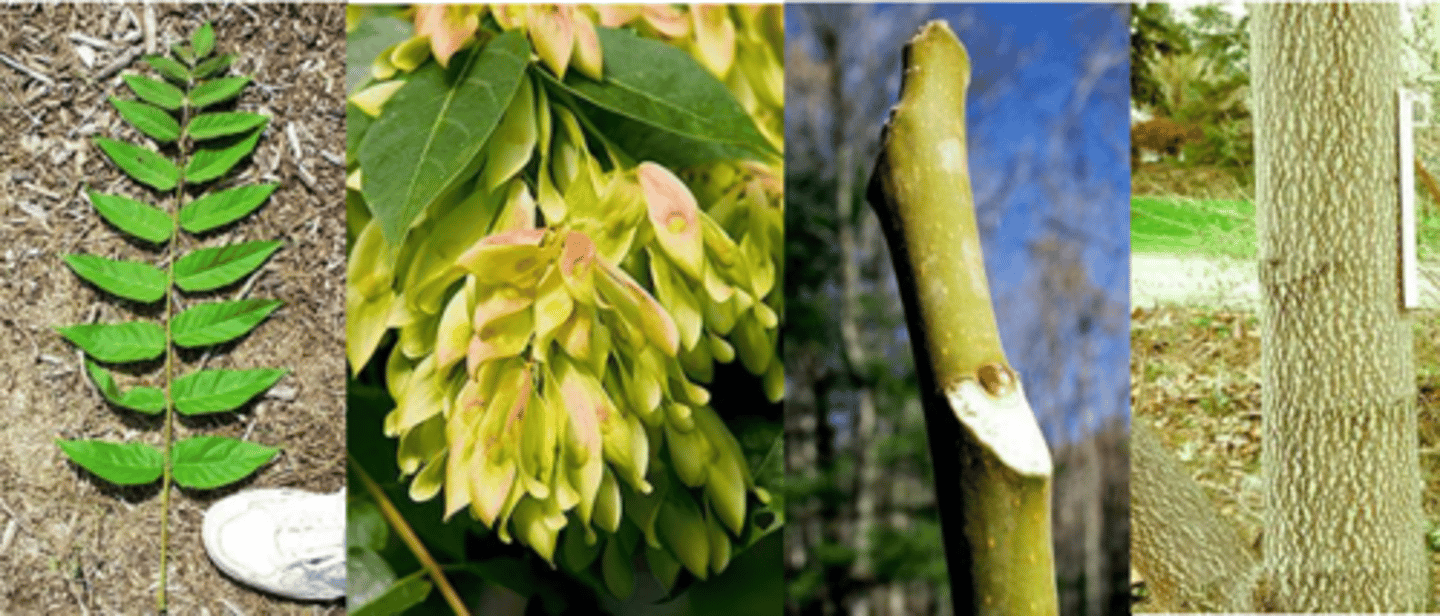
flowering dogwood
Cornaceae
Cornus florida
Leaves: Simple opposite, margins entire, sometimes barely toothed, leaves 3 to 5 inches long, 1 ½ to 2 ½ inches wide; oval to egg-shaped, tip acuminate, base wedge-shaped and often unequal; shiny green and somewhat hairy above; much paler and hairy below, heavily veined (arcuate); leaf stalk stout, grooved, about ¾ inch long
Twigs: Flexible, slender, reddish-gray to purplish, or greenish with red dots, hairy.
Flowers: Mid-April to mid-May, in terminal clusters with buds formed the previous year; flowers perfect; clusters of 25 to 30 located above four white bracts (often mistake for flower petals) the bracts are 1 ¼ to 2 ½ inches long, notched at the tip; flower buds develop the previous year and look like small onions
Fruit: August-November, brilliant red drupe, oval, shiny, in clusters of 2 to 6, cream-colored with 5 to 7 shallow longitudinal grooves
Trunk: Bark dark gray to brown with thin, squarish plates; wood brownish, strong, hard, not easily dented
Form/Silvics: Shrub to small tree to 40 feet with a straggling, spreading crown.

blue spruce
Pinaceae
Picea pungens
Leaves: Evergreen needles, ¾ - 1¼” long, stiff and very sharp (spine-like), displayed nearly straight out from twig, silvery blue to dark green. Strong acidic taste. Each needle borne on a raised, woody peg (sterigma).
Fruit: Cones are 2 – 4” long, cylindrical, light brown in color, scales are flexible, pointed with jagged uneven margins, mature in the fall.
Twig: Stout (when compared to other spruces), hairless, tan; needles are borne on woody pegs; bud scales brown and noticeably reflexed.
Bark: Gray to red-brown, young trees with small, thin scales; older trees still scaly but with shallow furrows.
Form/Silvics: Mature size 30’-60’ tall, formal, conical growth habit. Quite slow growing. Cultivars are so intense blue, they draw the eye from other plants in the landscape. Branches appear layered, especially with age.
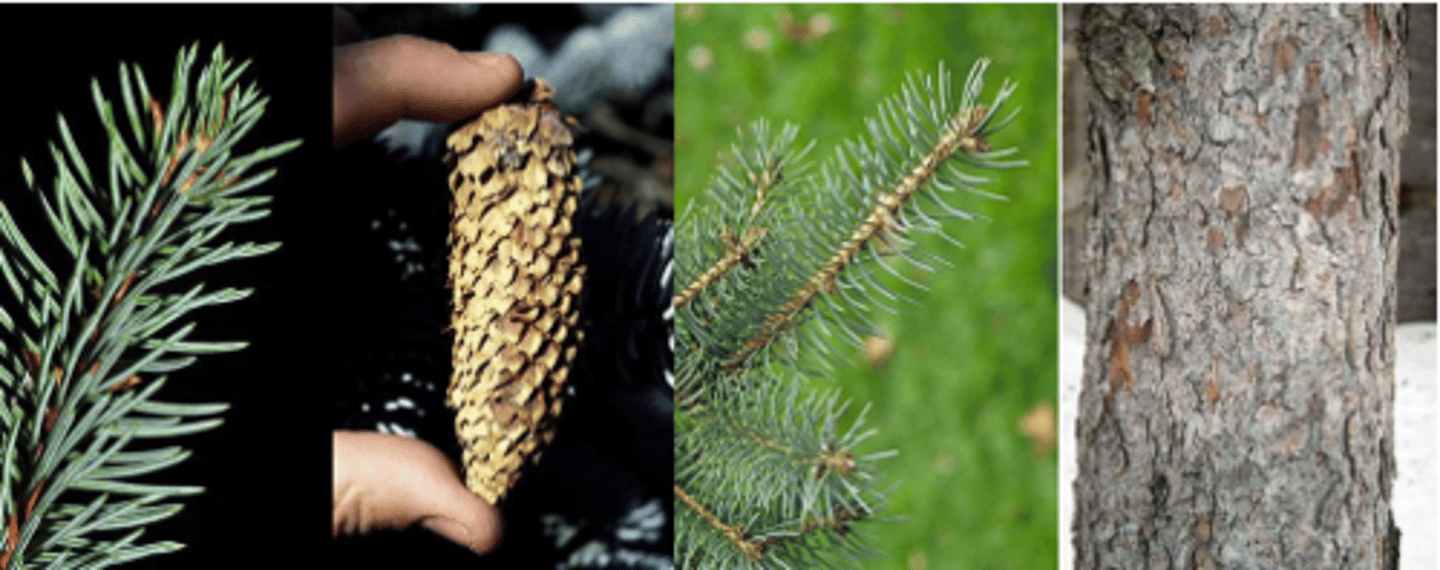
spicebush
Lauraceae
Lindera benzoin
Leaves: alternate, simple, elliptical, 3-5" long, pinnately veined, entire margin that may be somewhat ciliate, strong, spicy odor when crushed, green above and slightly paler below.
Twigs: slender, olive-green to brown in color, numerous light lenticels, with distinctive, stalked globose flower buds covered with 2 to 3 yellow-green to brown scales; when broken, a spicy, peppery smell is obvious. Terminal bud tiny and hot pink.
Flowers: dioecious; small, but due to large numbers they can be showy, yellow, appearing in axillary clusters before the leaves in early spring.
Fruit: bright red drupes (to 1/2" long) which mature in fall and are attractive to birds.
Bark: Brown to gray-brown and speckled with light colored lenticels.
Form/Silvics: a deciduous shrub with a broad, rounded habit which typically grows 6-12' high in moist locations in bottomlands, woods, ravines, valleys and along streams.
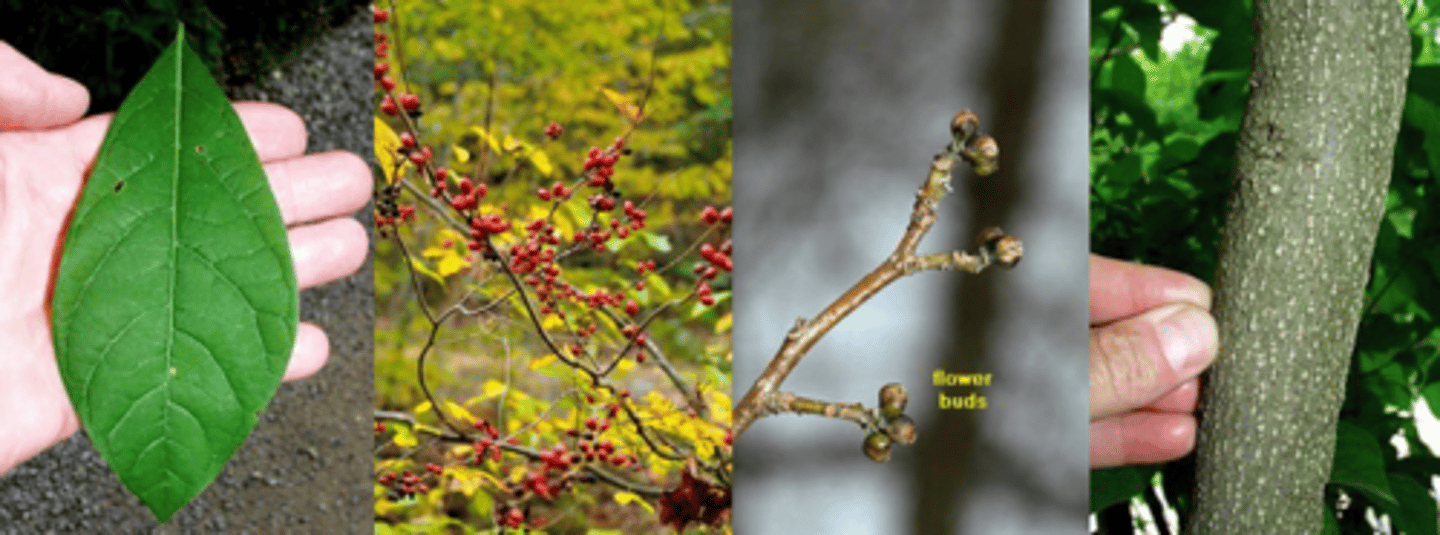
elderberry
Caprifoliaceae
Sambucus canadensis
Leaves: opposite, pinnately compound, up to 11 narrow leaflets, stays green late into the fall.
Twigs: tips are frequently dead, light brown warty lenticels; pith white, very large.
Buds: terminal buds lacking.
Fruit: purple-black berry, borne in broad cymose (flat-topped determinate inflorescence w/ outside flowers opening last)-structures, edible.
Form/Silvics: A riparian species which can stand some flooding. Shrubby nature, growth in clumps, early death of stems, reproduces from root sprouts.

mugo pine
Pinaceae
Pinus mugo
Leaves: Evergreen needles in fascicles of 2, curved but not twisted around each other, 1½ - 2½” long, stiff, medium to dark green, persist for many years.
Fruit: Small cones, borne singly or in small cluster, 1 to 2 inches long, grayish brown at maturity.
Twig: Moderate, typically short growth, very dense foliage, reddish gray-brown buds and stem with gray-white fascicle sheath.
Bark: Brownish gray, on older stems splits and irregular plates develop, raised bumps on smaller stems.
Form: Most planted cultivars are small bushy, round shrubs, 15-20’ in height
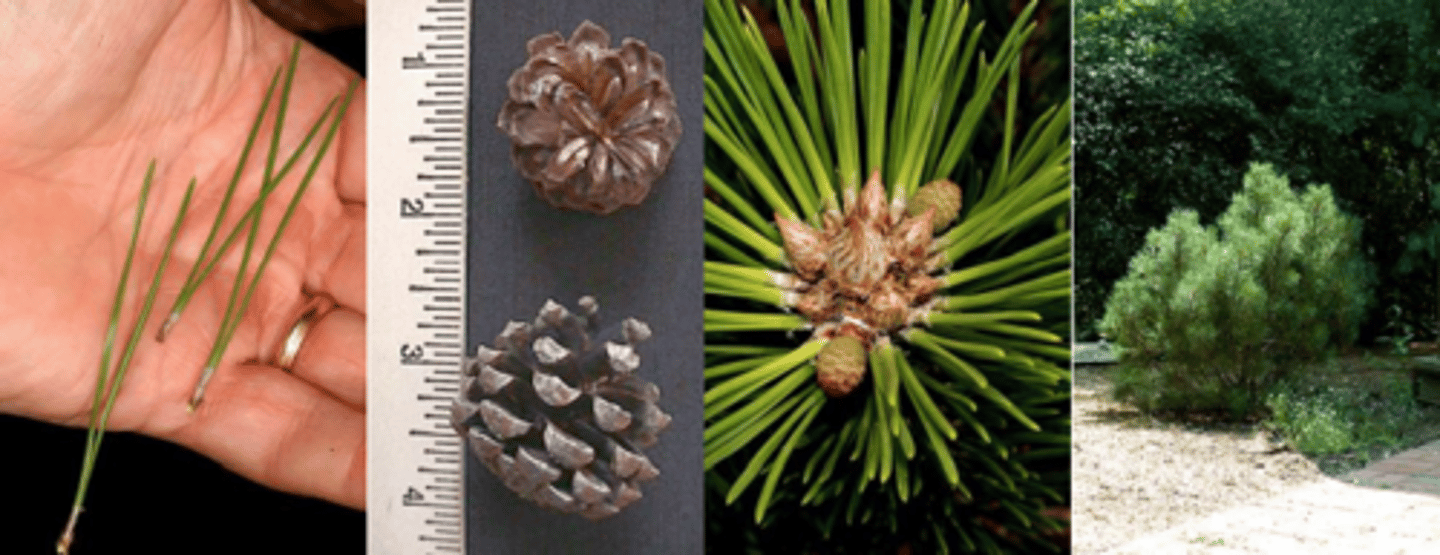
western redcedar
Cupressaceae
Thuja plicata
Leaves: Persistent, scale-like, and arranged in decussate pairs; yellow-green on top with a distinctive butterfly shaped bloom pattern on the underside. Individual leaves are typically 1/16 – 1/8” long and sets of four are roughly square. Foliage arranged in flattened sprays, dead leaves fall in sprays.
Fruit: Small woody cones (1/2” long) with thin, valvate scales arranged in 5 to 6 decussate pairs; typically upturned on the branches.
Twig: Younger twigs are flattened while older twigs are round, slender, flexible, and slightly zigzag; reddish brown.
Bark: Thin (1/2 - ¾” thick), fibrous, stringy, and reddish brown; finely ridged and furrowed; intertwined; comes off in long strips.
Form/Silvics: A large evergreen conifer that grows to 200’ tall and 10’ in diameter (sometimes more). Has an open, pyramidal crown with pendulous, frond-like branches. Base of trunk is often swollen and fluted.
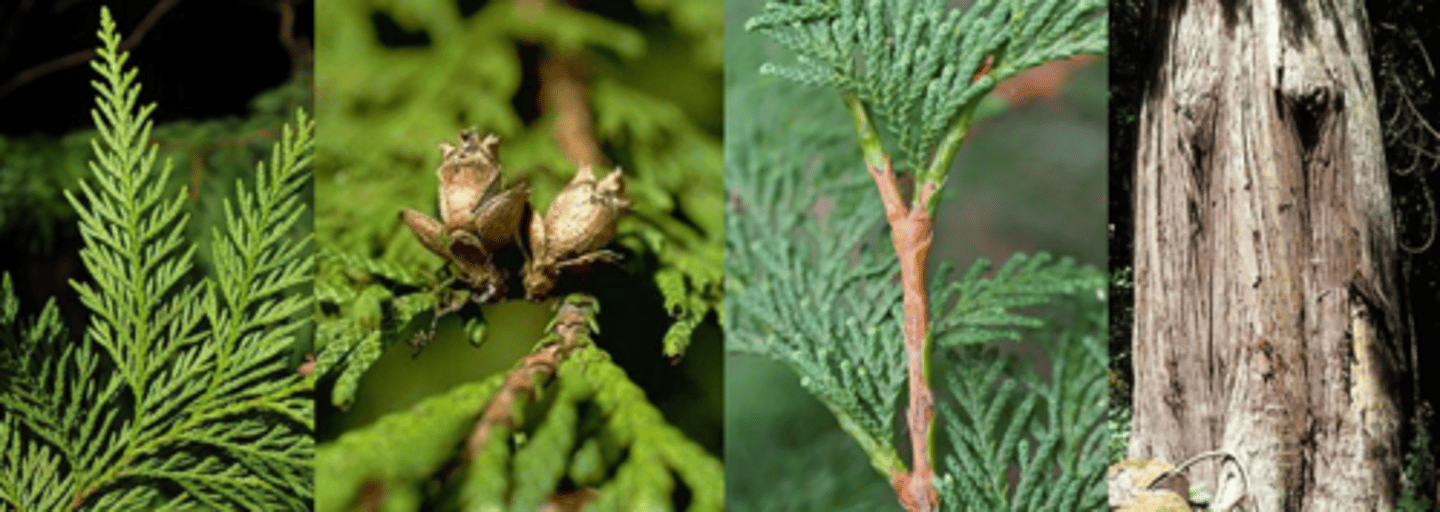
black pine, Austrian pine
Pinaceae
Pinus nigra
Leaves: evergreen needles, 4-6” long, flexible with two thick, dark green needles per fascicle.
Flower: monoecious; males cylindrical, yellow, in large clusters along twigs; females oval, yellow to purple.
Fruit: cones are ovoid, 2-3” long, yellow-brown; umbo is armed with a very short, minute prickle, maturing in the fall.
Twig: quite stout, brown to gray in color with a large white, ovoid terminal bud.
Bark: brown to gray, developing gray-brown ridges and dark brown furrows.
Form/Silvics: a medium-sized tree reaching up to 100 feet tall with a very dense crown (needles retained up to 4 years) that eventually develops a flat top.
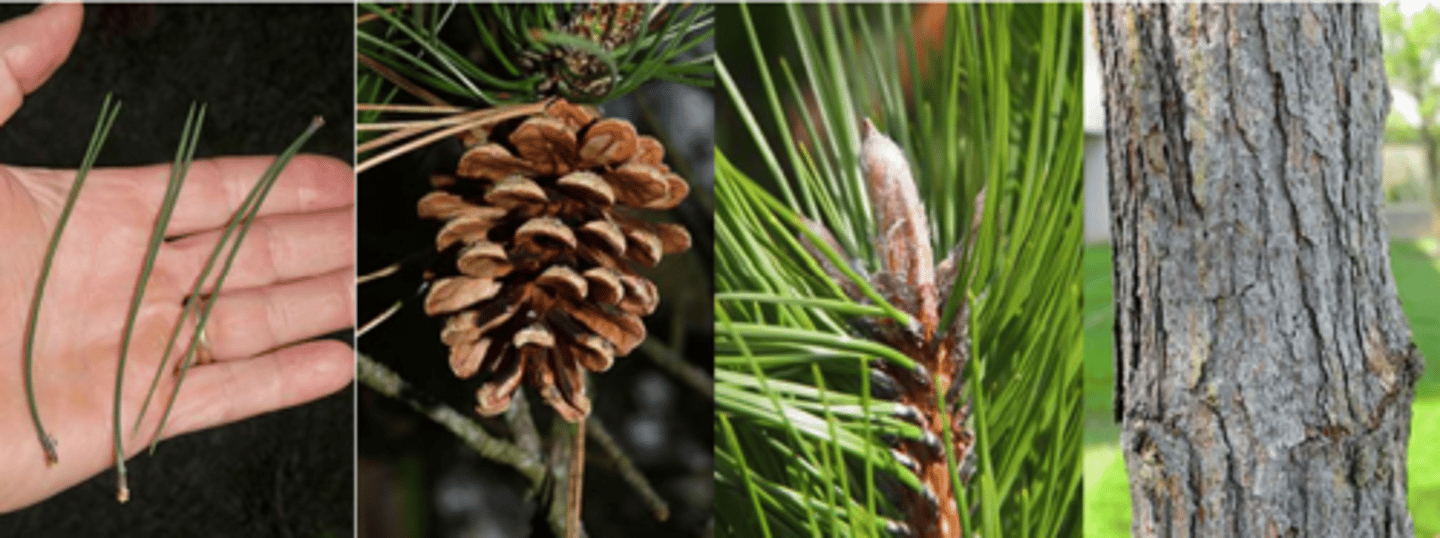
poison-ivy
Anacardiaceae
Toxiocodendron radicans
Leaves: alternate, trifoliate, up to 8” long, can be entire or irregularly toothed, usually oval shaped; central leaflet w/longest petiolule. Leaf scars are u-shaped w/ 6 bundle scars.
Twigs: brownish w/ fine aerial rootlets arising on the sides.
Buds: naked, elongated, angular, tan or light brown in color.
Fruit: yellowish-white berry.
Form/Silvics: a vine or shrub like habit, vines climbs w/ aerial roots, up to 60’. Stay away!!

greenbrier
Smilacaeae
Smilax spp.
Leaves: Alternate, simple, rounded to cordate, 3 – 5” long, margins ciliate or very finely serrate, parallel veins, shiny green above, slightly paler beneath.
Fruit: Dark blue to nearly black, round berry, ¼” in diameter, ripens in late summer and persists into the winter.
Twig: Stout green with numerous dark (nearly black), needle-like prickles, numerous paired, slender tendrils.
Bark: Remaining green for a long time but will turn darker and even brown on old stems.
